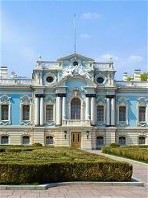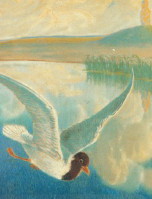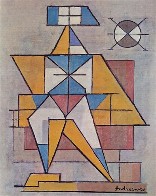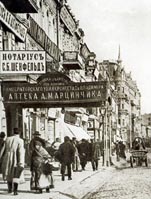IEU'S FEATURED TOPICS IN UKRAINIAN ART AND ARCHITECTURE
I. The Art of Fresco Painting in Ukraine
II. The Byzantine Art of Mosaic in Ukraine
III. The Timeless Art of the Ukrainian Icon
IV. The Art of Portraiture in Ukraine
V. The Art of Sculpture in Ukraine
VI. The Art of Ukrainian Baroque Engraving
VII. Masterpieces of Rococo Architecture in Ukraine
VIII. Ukrainian Classicist Painters and Sculptors
IX. Academism in 19th-century Ukrainian Painting
X. The Tradition of Ukrainian Landscape Art
XI. The Ukrainian Historical Painting: From Classicism to Realism
XII. The Ukrainian Realist Genre Painting
XIII. The Ukrainian Impressionist Painters
XIV. Mykhailo Boichuk and his School of Ukrainian Monumental Art
XV. Ukrainian Avant-Garde Artists of the Early 20th Century
XVI. Ukrainian Modernist Artists in Paris
XVII. Ukrainian Artists in Western Ukraine in the First Half of the 20th Century
XVIII. 20th-century Ukrainian Graphic Art and Printmaking
XIX. 20th-century Ukrainian Primitive (Naive) Art
XX. Kyiv's Architectural Monuments Destroyed in the 1930s and 1940s
XXI. Socialist Realism in Soviet Ukrainian Art
XXII. Ukrainian Artists of the Shistdesiatnyky Generation
XXIII. Ukrainian Nonconformist (Unofficial) Art in the USSR (1960s-80s)
 I. THE ART OF FRESCO PAINTING IN UKRAINE
I. THE ART OF FRESCO PAINTING IN UKRAINE
In the Kyivan Rus' the fresco was the principal method of decorating church interiors. While Byzantine-style mosaics were limited to the central part of a church, frescoes covered all the side apses, vaults, columns and walls of the side naves, and sometimes even the arch supports, galleries, niches, and external portals. In Byzantium, mosaics were never mixed with frescoes in the same building; this is a unique practice of Ukrainian church art. Harmony between mosaic and fresco was achieved by using the same dominant colors. The most famous examples of this decorative system are Saint Sophia Cathedral (1037) and the Cathedral of Saint Michael's Golden-Domed Monastery (mid-12th century) in Kyiv. After the middle of the 12th century frescoes almost completely replaced mosaics in the decoration of church interiors. The most complete set of frescoes from this period has been preserved in the church of Saint Cyril's Monastery in Kyiv... Learn more about the art of fresco painting in Ukraine by visiting the folwing entries:
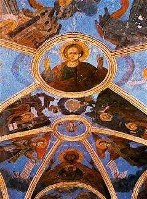 |
FRESCO PAINTING. A method of painting on freshly plastered walls with powdered pigments that are resistant to the erosive action of lime. Before the colors are applied to the wet plaster the main lines of the composition are usually traced on the preceding coat. The painting is very durable and is applied to both interior and exterior walls. The origins of fresco painting in Ukraine can be traced back to the 4th century BC. Frescoes adorned the homes, public buildings, and tombs of the Greek colonists and Scythians on the coast of the Black Sea. The most interesting ancient frescoes from the 1st century BC were discovered during excavations of burial sites in Kerch in the tomb of Demeter... |
| Fresco painting |
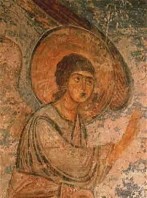
|
[FRESCOES OF] SAINT SOPHIA CATHEDRAL. Saint Sophia Cathedral is a masterpiece of the art and architecture of Ukraine and Europe. It was built in Kyiv at the height of Kyivan Rus', in the Byzantine style, and significantly transformed during the baroque period. The cathedral was founded by Grand Prince Yaroslav the Wise and built between 1037 and 1044. The original building, most of which remains at the core of the existing cathedral, is a cross-in-square plan with twelve cruciform piers marking five east-west naves intersected by five transverse aisles. The cathedral's interior is decorated with magnificient 11th-century mosaics and frescoes. Exterior ornamentation of the original 11th-century walls consists of decorative brickwork, the monochromatic painting of key architectural elements, and a number of frescoes... |
| Saint Sophia Cathedral |
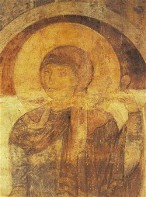
|
[FRESCOES OF] SAINT MICHAEL'S GOLDEN-DOMED MONASTERY. An Orthodox men's monastery in Kyiv. In the 1050s Prince Iziaslav Yaroslavych built Saint Demetrius's Monastery and Church in the old upper city of Kyiv, near Saint Sophia Cathedral. In 1108-13 his son, Sviatopolk II Iziaslavych, built a church at the monastery dedicated to Saint Michael the Archangel. The monastery was mostly destroyed during the Tatar invasion of 1240 and ceased to exist. Written records confirm that it was reopened by 1496. Soon afterward it began to be known as Saint Michael's Golden-Domed Monastery, its name being taken from the church built by Sviatopolk II Iziaslavych. Restored and enlarged over the 16th century, it became one of the most popular and wealthy monasteries in Ukraine. ... |
| Saint Michael's Monastery |
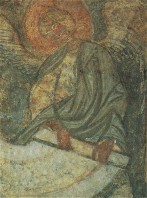
|
[FRESCOES OF] SAINT CYRIL'S MONASTERY. A monastery founded by Grand Prince Vsevolod Olhovych ca 1140 on the outskirts of medieval Kyiv. Its church, Saint Cyril's, was built ca 1146. The church's frescoes are fine examples of 12th-century Ukrainian art and the influence of Bulgarian-Byzantine painting on it. They depict the Nativity of Christ, the Presentation of Christ at the Temple, the Eucharist, the Annunciation, the Dormition, the Last Judgment and Apocalypse, an angel gathering the heavens into a scroll, the apostles, the evangelists, and various prophets and martyrs. Murals of saints--Saint Cyril and Saint Methodius, Saint John the Macedonian, Saint Euphemios--adorn its pillars, and compositions depicting Saint Cyril teaching the heretic, teaching in the cathedral, and teaching the emperor are found in the southern apse... |
| Saint Cyril's Monastery |
The preparation, editing, and display of the IEU entries associated with the art of fresco painting in Ukraine were made possible by the financial support of the CANADIAN FOUNDATION FOR UKRAINIAN STUDIES.
 II. THE BYZANTINE ART OF MOSAIC IN UKRAINE
II. THE BYZANTINE ART OF MOSAIC IN UKRAINE
In the 8th-9th century, the second Golden Age of Byzantine art began. During this period Kyivan Rus' actively entered the orbit of Byzantine culture and in 988 adopted Christianity through Byzantium. In fact, Byzantine influence on Ukrainian territory began much earlier and was concentrated on the northern shores of the Black Sea, in such cities as Kerch and Chersonese Taurica. The earliest Kyivan churches built in the Byzantine style (such as the Church of the Tithes) did not survive the continual invasions of nomadic hordes. However, the Saint Sophia Cathedral, begun in 1037, has been preserved in relatively good condition. It represents a masterpiece of the art and architecture of Ukraine and Europe. According to the Rus' chronicles, Prince Volodymyr the Great imported the first architects and artists from Chersonese, and these together with the artists of Constantinople were the first creators of Kyivan mosaics and frescos... Learn more about the legacy of Byzantine art in Ukraine, and in particular the Byzantine art of mosaic, by visiting the following entries:
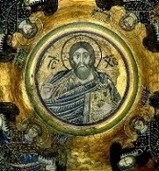
|
MOSAIC. A method of wall and floor decoration in which small pieces of cut stone, glass (tesserae), and, occasionally, ceramic or other imperishable materials are set into plaster, cement, or waterproof mastic. The earliest existing examples of mosaics in Ukraine are fragments from the floor of a domestic bath found at the site of the Greek colony of Chersonese Taurica (ca 3rd-2nd century BC). Made of various colored pebbles, the floor depicts two nude figures and decorative motifs. Mosaic was used to decorate various Rus' churches and palaces in the 10th to 12th centuries, including the Church of the Tithes (989-96), the Saint Sophia Cathedral (1037 to the late 1040s), the Dormition Cathedral of the Kyivan Cave Monastery (1078), and Saint Michael's Church (1108-13) of the Saint Michael's Golden-Domed Monastery... |
| Mosaic |
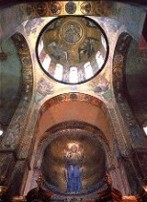 |
[MOSAICS OF] SAINT SOPHIA CATHEDRAL. The centripetal plan of Saint Sophia Cathedral, internal volumes, and external massing reflect the hierarchical ordering of the mosaics and frescoes inside. As the surfaces of the walls advance from the floor and the narthex, the frescoes increase in size and religious significance and culminate in the monumental mosaics Mother of God (Orante) in the central apse and Christ Pantocrator in the central dome. Among the most masterful mosaics are those of the Church Fathers. The more archaic Orante in the central apse, often referred to as the Indestructible Wall, is the most famous.... |
| Saint Sophia Cathedral |
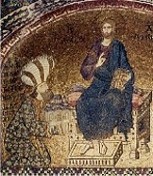 |
BYZANTINE ART. Visual art produced in the Byzantine Empire and in countries under its political control or cultural influence, among them Ukraine. The spread of Byzantine art was the result, in large measure, of its style, which had all the traits of universalism to which other cultures could easily adapt. This style began to develop in the 6th century AD during the first Golden Age under the reign of Emperor Justinian. It was based on Greco-Roman art and the art of the East--Syria, Asia Minor, Persia, and Egypt. In architecture, churches with stone cupolas symbolizing the cosmos appeared, replacing the longitudinal basilicas with flat wooden ceilings... |
| Byzantine art |
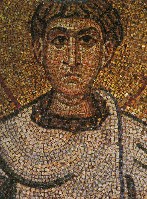
|
[MOSAICS OF] SAINT MICHAEL'S GOLDEN-DOMED MONASTERY. The main church of the Saint Michael's Golden-Domed Monastery (built in either 1654-7 or 1108-13) is an important architectural and cultural monument. Originally it had three naves and three apses on the eastern side and was topped by a single large gilded cupola. It was rebuilt in a baroque style and expanded with a new facade and six additional cupolas in the 18th century. The most striking elements of the interior were the 12th-century frescoes and mosaics, probably done by Kyivan artisans (including perhaps Master Olimpii). Although many of these were destroyed in the 13th to 16th century, some--notably the mosaics of Saint Demetrius of Thessalonika, the Eucharist, and Archdeacon Stephen--survived and were partially restored in the late 19th century... |
| Saint Michael's Monastery |
The preparation, editing, and display of the IEU entries associated with the Byzantine art of mosaic in Ukraine were made possible by the financial support of the CANADIAN FOUNDATION FOR UKRAINIAN STUDIES.
 III. THE TIMELESS ART OF THE UKRAINIAN ICON
III. THE TIMELESS ART OF THE UKRAINIAN ICON
With the introduction of Christianity in the 10th century, Byzantine icons and icon painters began to be imported into Ukraine. In the following century an indigenous school of icon painting developed in Kyiv. By the turn of the century the Kyivan Cave Monastery Icon Painting Studio could boast of such renowned painters as Master Olimpii and Deacon Hryhorii, who are mentioned in the Kyivan Cave Patericon. Because of their destructibility by fire and desirability as war booty, many icons perished. No Kyivan icons from the 11th century, and only a few from the 12th, have survived to our day. With the rise of the Principality of Galicia-Volhynia principality in the 13th century, a Galician tradition of icon painting arose. The chief icon painting schools in Galicia were those of Peremyshl and Lviv. Each of them had many branches scattered throughout the Carpathian Mountains region as far west as Transcarpathia. Numerous samples of their work dating back to the early 15th century have been preserved. At the beginning of the 17th century icon painting began to revive in eastern Ukraine. Its patrons were not only the church but also the rising Cossack elite. The new baroque churches in Kyiv, Chernihiv, and other centers of the Cossack Hetman state were decorated with elaborate iconostases. By the second half of the 18th century the icon evolved into an ordinary painting on a biblical theme and disappeared as a distinctive art form. However, at the beginning of the 20th century, Ukrainian icon painting was revived in a neo-Byzantine form, represented by Mykhailo Boichuk and his 'monumentalist' school, as well as by such painters as Modest Sosenko and Petro Kholodny... Learn more about the art of the Ukrainian icon by visiting the following entries:
ICON. An image depicting a holy personage or scene in the stylized Byzantine manner, and venerated in the Eastern Christian churches. The image can be executed in different media; hence, the term 'icon' can be applied to mural paintings, frescoes, or mosaics, tapestries or embroideries, enamels, and low reliefs carved in marble, ivory, or stone or cast in metal. The typical icon, however, is a portable painting on a wooden panel. The earliest technique of icon painting was encaustic, but the traditional and most common technique is tempera. The paint--an emulsion of mineral pigments (ochers, siennas, umbers, or green earth), egg yolk, and water--is applied with a brush to a panel covered with several layers of gesso. Gold leaf is fixed to designated areas before painting begins. The paint is applied in successive layers from dark to light tones; then the figures are outlined and, finally, certain areas are highlighted with whitener. After drying, the painting is covered with a special varnish consisting of linseed oil and crystalline resins to protect it from dust and humidity... |
|
| Icon |
ICONOSTASIS. A solid wooden, stone, or metal screen separating the sanctuary from the nave in Eastern Christian churches. Of varying height, it consists of rows of columns and icons. It extends the width of the sanctuary and has three entrances: the large Royal Gates at the center and the smaller Deacon Doors on each side. The Royal Gates are hung with a curtain. The iconostasis evolved in Byzantium in the 9th-11th centuries. The icons of the iconostasis are separated by columns and are arranged in several rows. The number of icons and ranges can vary. Usually, a full iconostasis contains over 50 icons set in four to six rows, but simpler (one- or two-story) and more elaborate (seven-story) iconostases are known. In Ukraine the earliest iconostases were low, consisting of only two tiers. Their further development was conditioned by the development of wooden architecture and the decline of the art of mosaics. By the 14th-15th centuries the typical structure of the two- and three-tiered iconostasis was established... |
|
| Iconostasis |
KYIVAN CAVE MONASTERY ICON PAINTING STUDIO. Main centre of Ukrainian icon painting for many centuries. Its founding at the end of the 11th century was connected with the painting (1083-9) of the Dormition Cathedral of the Kyivan Cave Monastery by Greek masters and the Kyivan artists Master Olimpii and Deacon Hryhorii. The studio developed a distinctive style that is evident in its frescoes, icons, and book illuminations. From the late 16th century, collections of prints by western and local artists and of student drawings were kept for educational purposes. The studio's finest masterpieces of the 18th century are the mural paintings of the Dormition Cathedral (1724-31) and the Trinity Church (1734-44) above the Main Gate of the Kyivan Cave Monastery, which were done by Ivan Maksymovych, T. Pavlovsky, Zakharii Holubovsky, and A. Halyk. Many noted icon painters and engravers were trained at the studio. Towards the end of the 18th century the studio gradually lost its importance in the development of Ukrainian art...
|
|
| Kyivan Cave Monastery Icon Painting Studio |
RUTKOVYCH, IVAN, b ? in Bilyi Kamin, near Zolochiv, Galicia, d ? Icon painter of the 17th century. Most of his creative life was spent in Zhovkva (1667 to ca 1708) where, among other things, he was one of the key figures in the Zhovkva School of Artists. Some of his work has been preserved, in whole or in part, such as the iconostases of the wooden churches in Volytsia Derevlianska (1680-2) and Volia Vysotska (1688-9); the large iconostasis of the Church of Christ's Nativity in Zhovkva (1697-9, now in the National Museum in Lviv), which is considered to be the finest Ukrainian iconostasis; and separate icons, such as Supplication (1683) from Potylych (now in the National Museum) and The Nativity of Virgin Mary (1683) from Vyzhliv. Rutkovych's treatment of religious subjects was realistic and almost secular in spirit. The emotive richness of his colors and the rhythm of his lines testify to the influence of contemporary European art on his style. Vira Svientsitska's book about Rutkovych was published in Kyiv in 1966... |
|
| Ivan Rutkovych |
KONDZELEVYCH, YOV, b 1667 in Zhovkva, Galicia, d ca 1740 in Lutsk, Volhynia. Noted icon painter and elder of the Bilostok Monastery in Volhynia. After his training at the Zhovkva School of Artists, he probably studied painting at the Kyivan Cave Monastery Icon Painting Studio and abroad. Some of his numerous works have survived, including a fragment of the Bilostok Monastery iconostasis; the tabernacle of the Zahoriv Monastery (1695); and the famous iconostasis of the Maniava Hermitage, painted in 1698-1705 and transferred in 1785 to the church in Bohorodchany upon the dissolution of the hermitage. In 1923 the iconostasis was deposited in the National Museum in Lviv under the name the Bohorodchany iconostasis. In 1722 Kondzelevych took part in painting the iconostasis of the Zahoriv Monastery. His last work was The Crucifixion (1737) for the Lutsk Monastery. Kondzelevych broadened the traditional scheme of the icon significantly: he devoted much attention to the surroundings, particularly to the landscape, which he filled with distinctive architectural ensembles... |
|
| Yov Kondzelevych |
KHOLODNY, PETRO, b 18 December 1876 in Pereiaslav, Poltava gubernia, d 7 June 1930 in Warsaw. Distinguished painter. A graduate of the Kyiv Drawing School, he began to exhibit his work in 1910. Symbolist influences are apparent in his early paintings, such as A Tale of a Girl and Peacock (1916). Attracted by ancient Galician icons in 1914, he became fascinated with the tempera technique and used it frequently. During the Ukrainian struggle for independence (1917-20), Kholodny worked in the Central Rada's Ministry of Education. Leaving Ukraine with the UNR government in 1920, he settled in Lviv in 1921. The subsequent period proved to be the most productive one in Kholodny's artistic career. In 1922 he helped found the Circle of Promoters of Ukrainian Art and took part in its exhibitions. He began to paint icons and churches and to design stained-glass windows. The basic features of his work, rooted in Ukrainian artistic traditions that grew out of the synthesis of Byzantine iconography with folk art, were compositional unity, the primacy of the line, and harmonious, warm colors...
|
|
| Petro Kholodny |
The preparation, editing, and display of the IEU entries featuring the timeless tradition of the Ukrainian icon were made possible by the financial support of the CANADIAN FOUNDATION FOR UKRAINIAN STUDIES.
 IV. THE ART OF PORTRAITURE IN UKRAINE
IV. THE ART OF PORTRAITURE IN UKRAINE
The oldest form of secular art in Ukraine, portraiture dates back to the 4th-century BC portraits found in burial sights in the Greek city of Chersonese Taurica. Medieval examples are the depictions of Grand Prince Yaroslav the Wise and his family (1044) in the frescoes of the Saint Sophia Cathedral in Kyiv and the depictions of Grand Prince Sviatoslav II Yaroslavych and his family in the illuminations of the Izbornik of Sviatoslav (1073). Prince Yaropolk Iziaslavych and his wife are shown in the Trier Psalter (1078-87). Secular portraits of nobles, notable Cossacks, peasant leaders, and rich burghers gained currency in the 16th century and grew in popularity through the 17th and 18th centuries. A special type of portrait painting developed in Ukraine, the parsunnyi (from the Latin persona), depicting notable figures in rich attire and formal poses against a background reaffirming their official status. During the baroque period of the late 17th and early 18th centuries many official portraits of Cossack hetmans, including Bohdan Khmelnytsky, Ivan Mazepa, Ivan Skoropadsky, Danylo Apostol, and Pavlo Polubotok, were painted depicting the regalia of office. Church leaders were also well represented in portraiture. Family portraits mirrored social and historical changes in their composition and the manner in which the subjects were painted. The development of regional styles gave rise to the Kyivan, Galician, and Volhynian schools of portrait painting. Portraits were also made by engravers, such as Leontii Tarasevych, Oleksander Tarasevych, Ivan Shchyrsky, and Hryhorii K. Levytsky. The tsarist abolition of Ukrainian autonomy in the 18th century coincided with the establishment of the Saint Petersburg Academy of Arts (1758), which attracted many Ukrainian artists. Dmytro H. Levytsky of Kyiv became a professor at the academy and the greatest portraitist in the Russian Empire of his time. Volodymyr Borovykovsky, another outstanding portraitist, also worked in Saint Petersburg in the classical, academic manner favored by the imperial court. In the 19th century many portraits were painted in Ukraine by trainees of the academy. Portraits were also painted by wandering artists and by artists who were formers serfs, such as Taras Shevchenko, whose contribution to the Ukrainian art has often been underrated. Portraits remained popular throughout the 19th century, and, in the 20th century, artists have created portraits in a wide variety of styles... Learn more about the art of portraiture in Ukraine by visiting the following entries:
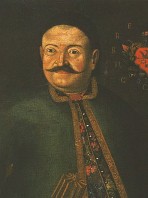
|
PORTRAITURE. The artistic depiction of one or more particular persons. Although portraiture did not emerge as a separate genre in the Ukrainian art until the 16th century, its existence may be traced back to some icons: the canonical renderings of Saint Anthony of the Caves and Saint Theodosius of the Caves in the Holy Protectress of the Caves icon (ca 1288), where they have been given individualized features. In the late 15th and early 16th centuries the rendering of icon countenances became more realistic as a result of Renaissance influences (eg, the Krasiv Mother of God). In the 17th century, realistic portrayals of patrons were part of the composition of icons, such as the Holy Protectress, with a portrait of Hetman Bohdan Khmelnytsky, and the fresco Supplication (1644-6), with Metropolitan Petro Mohyla, in the Transfiguration Church in Berestove in Kyiv. Late 16th- to 18th-century religious and secular portraits at first had some characteristics of the icon, such as flattened forms, static frontal composition, and hieratic figural representation. With time, under the influence of Renaissance painting, they became three-dimensional and were painted with a linear and aerial perspective. Many portraits of patrons of shrines and churches were painted and displayed inside churches. Memorial portraits of members of the upper classes were painted on wood or metal and attached to the lids of their coffins. One of the most sensitive and beautifully modeled was that of V. Lanhysh (1635), found in the Lviv Dormition Brotherhood's portrait collection... |
| Portraiture |
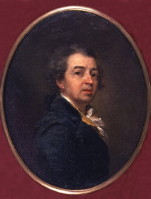
|
LEVYTSKY, DMYTRO H., b 1735 in Kyiv, d 16 April 1822 in Saint Petersburg. The most prominent portraitist of the classicist era in the Russian Empire. He acquired his basic training from his father, Hryhorii K. Levytsky, and helped him do engravings for the Kyivan Cave Monastery Press. In 1753-6 he helped his father and Aleksii Antropov decorate Saint Andrew's Church in Kyiv. From 1758 to 1761 he worked in Saint Petersburg, where he likely studied with Antropov, L.-J.-F. Lagrene, and G. Valeriani. From 1762, while living in Moscow he was a portraitist in great demand among the Russian aristocracy. He moved to Saint Petersburg in 1769, and he won the highest award at the summer exhibition in 1770 held by the Saint Petersburg Academy of Arts and was elected a member of the academy. A teacher of portraiture at the academy (1771-88), he retired to Ukraine in 1788, but in 1795 he returned to Saint Petersburg to become portraitist at the imperial court. Building on the baroque, classicism, and Western European traditions, Levytsky created a school of portrait painting. His portraits reveal his expert knowledge of drawing, composition, color, and the appropriate gesture. He executed over 100 portraits. Many Ukrainian (eg, L. Myrypolsky, S. Maiatsky, L. Kalynovsky) and Russian portraitists studied with Levytsky at the academy, and his works influenced the portraiture of Volodymyr Borovykovsky...
|
| Dmytro H. Levytsky |
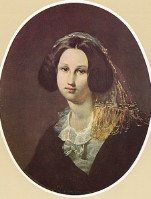
|
SHEVCHENKO, TARAS, b 9 March 1814 in Moryntsi, Zvenyhorodka county, Kyiv gubernia, d 10 March 1861 in Saint Petersburg, Russia. Ukraine's national bard and famous artist. Born a serf, Shevchenko became a houseboy of his owner, P. Engelhardt, who noticed Shevchenko's artistic talent, and in Saint Petersburg apprenticed him to the painter V. Shiriaev. Through his Ukrainian supporters in Saint Petersburg Shevchenko met the famous painter Karl Briullov, who donated his painting as the prize in a lottery whose proceeds were used to buy Shevchenko's freedom. Although Shevchenko is known primarily because of his poetry, he was also an accomplished artist; 835 of his art works are extant, and another 270 of his known works have been lost. Trained as an academic artist, Shevchenko moved beyond stereotypical historical and mythological subjects to realistic depictions on ethnographic themes, often expressing veiled criticism of the absence of personal, social, and national freedom under tsarist domination. His portraits have a broad social range of subjects, from simple peasants and petty officials to prominent Ukrainian and Russian cultural figures, Ukrainian historical figures, and members of the imperial nobility. They are remarkable for the way Shevchenko uses light to achieve sensitive three-dimensional modeling. He painted or sketched over 150 portraits, 43 of them of himself. He also painted and drew numerous landscapes and was very proficient in watercolor, aquatint, and etching. In 1860 the Imperial Academy of Arts recognized his mastery by designating him an academician-engraver... |
| Taras Shevchenko |
_s.jpg)
|
GE, MYKOLA, (also: Gay, Gue), b 27 February 1831 in Voronezh, d 13 April 1894 at Ivanovskyi khutir (now the village of Shevchenko), Bakhmach county, Chernihiv gubernia. Painter of mixed French and Ukrainian origin. Having grown up on his family estate in Popelukhy near Mohyliv-Podilskyi in Podilia, Ge later studied at Kyiv University (1847) and Saint Petersburg University (1848-9), and at the Saint Petersburg Art Academy (1850-7), where he became a professor in 1863. One of the founders of the Peredvizhniki group of Russian and Ukrainian populist painters, later in his career he abandoned the group's naturalistic style. His realist paintings, including portraits, are characterized by particular psychological depth, while his late cycle of works on Biblical themes foreshadow the emergence of expressionism in European art. Initially, Ge's style of painting was influenced by his teacher Karl Briullov and the principles of academism taught at the Saint Petersburg Art Academy. In 1857 he travelled to Western Europe and in 1860 settled in Italy where he lived, with interruptions, until 1870. Influenced by works of Italian Renaissance masters, Ge continued to paint compositions on Biblical theme, but he also executed numerous landscapes and some portraits. Upon his return to Saint Petersburg in 1870, Ge painted several works on historical subjects and numerous portraits. In 1876 he returned to Ukraine where he settled at his estate in Chernihiv gubernia and remained there until his death. Throughout his life Ge took a keen interest in Ukrainian culture, particularly the works of Taras Shevchenko, whose poetry he greatly admired... |
| Mykola Ge |
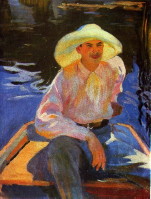
|
MURASHKO, OLEKSANDER, b 7 September 1875 in Kyiv, d 14 June 1919 in Kyiv. Painter. He studied at the Kyiv Drawing School (1891-4) and later, under Ilia Repin, at the Saint Petersburg Academy of Arts (1894-1900) where he was awarded the Academy's gold medal in 1900 for his diploma painting Burial of a Kish Otaman. As part of his prize, he was sent to study in Paris (1902-4); later he also studied at the Munich Academy of Arts. He belonged to the New Society of Artists in Saint Petersburg and participated in its annual exhibitions (1904-14). In 1907 he settled in Kyiv, where he taught painting at the Kyiv Art School (1909-12) and at his own studio (1912-17). In 1909 he exhibited his canvases in Paris, Amsterdam, and at the international exhibition in Munich where his painting A Carousel (1906) was awarded the main prize. In 1910 he had one-man exhibitions in Berlin, Koln, and Dusseldorf. From 1911 he exhibited with the Munich Sezession group. In 1916 he joined the Peredvizhniki society and became a founding member of the Kyiv Society of Artists. He was a cofounder of the Ukrainian State Academy of Arts in 1917 and served there as a professor and rector. Murashko's style evolved from the realism of the Peredvizhniki school into a vivid, colorful impressionism. His paintings and portraits have been praised by critics for their psychological depth. Murashko established an international reputation and had a strong influence on the development of Ukrainian portraiture in the 20th century. He was murdered in Kyiv by unknown assailants... |
| Oleksander Murashko |
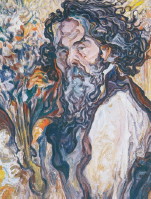
|
NOVAKIVSKY, OLEKSA, b 14 March 1872 in Slobodo-Obodivka (now Nova Obodivka), Olhopil county, Podilia gubernia, d 29 August 1935 in Lviv. Painter and educator. He studied painting under F. Klymenko in Odesa (1888-92) and at the Cracow Academy of Fine Arts (1892-3, 1895-1900) under J. Unierzyski and Jan Stanislawski. After graduating with a gold medal he lived in Mogila (now Nowa Huta), near Cracow, where he devoted himself to landscape painting. The first solo exhibition of his works was held in Cracow in 1911. Having attracted Metropolitan Andrei Sheptytsky as his patron, Novakivsky moved to Lviv in 1913 where exhibitions of his works took place in 1920 and 1921. Novakivsky also exhibited at shows of the Society for the Advancement of Ruthenian Art, the Society of Friends of Ukrainian Scholarship, Literature, and Art, the Association of Independent Ukrainian Artists, and the Novakivsky Art School which he established in 1923. During his Cracow period Novakivsky painted portraits, landscapes, still lifes, and genre scenes in a naturalistic and impressionist style that resembled that of Polish contemporaries, such as Jan Stanislawski, Jacek Malczewski, and Stanislaw Wyspianski. During his early Lviv period his style evolved under the impact of the First World War to become more symbolist and expressionist. He executed in this style, among others, several masterful portraits. In the 1920s his colors grew more vivid, and his lines more dynamic, and his paintings from that period are fully expressionist in style... |
| Oleksa Novakivsky |
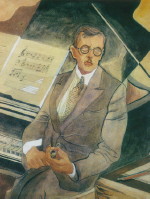
|
PETRYTSKY, ANATOL, b 31 January 1895 in Kyiv, d 6 March 1964 in Kyiv. Ukrainian painter and stage designer. He studied at the Kyiv Art School (1912-17) and the Advanced Artistic Theatrical Workshop in Moscow (1922-4) and worked as stage designer in the Molodyi Teatr (1916-19), the Shevchenko First Theater of the Ukrainian Soviet Republic, and the Franko New Drama Theater. In 1925-41 he continued to design in Ukrainian operatic and drama theaters in Kharkiv, Kyiv, and Odessa, and in 1945-59 (with interruptions) in the Kyiv Theater of Opera and Ballet. Petrytsky's early work, particularly his painting, was influenced by cubism and futurism. As a stage designer he was an adherent of theatrical conventionality and readily employed Ukrainian traditional print and ornamentation. In Les Kurbas's staging of Vertep in Molodyi Teatr, he created stylized costumes for actors who appeared in the puppet show; in Ostap Vyshnia's Vii, staged at the Franko New Drama Theater, he united screens with stylized costumes. From 1930 he specialized mostly in design for opera and ballet. Even under pressure to adhere to norms of socialist realism he preserved a national coloring in his theater and dance work. Petrytsky was also a renowned master of portraiture; among others, he painted a well-known series over 150 portraits of the leading Ukrainian cultural figures in the 1920s and 1930s (most of these works were destroyed by the Soviet authorities). He also excelled in landscape painting and graphic art... |
| Anatol Petrytsky |
The preparation, editing, and display of the IEU entries about the art of portraiture in Ukraine were made possible by the financial support of the CANADIAN FOUNDATION FOR UKRAINIAN STUDIES.
 V. THE ART OF SCULPTURE IN UKRAINE
V. THE ART OF SCULPTURE IN UKRAINE
Sculptural depictions (schematized female figures made from mammoth bones) dating back to the Paleolithic Period have been found in Ukraine at the Mizyn archeological site (ca 18,000 BC). Terra-cotta figures from the Trypilian culture and stone stelae have survived from the Bronze Age. The Scythians left behind beautiful examples of relief sculpture. Numerous examples of Hellenic figural sculpture have been found among the ruins of the ancient states on the northern Black Sea coast. Pre-Christian examples from the 1st millennium AD include the stone temples and idols, such as the Zbruch idol. Life-size freestanding stone baby dating from the 11th to 13th centuries AD were erected in the steppes of Ukraine by Turkic tribes. However, only a few sculptures from the period of Kyivan Rus' (10th-12th centuries) have been preserved. This is because the Eastern church opposed figural carving. As the influence of Renaissance art spread to Ukraine, particularly Galicia, sculpture became more common. During the baroque period (mid-17th to early 18th century) in Ukraine, relief carvings reached the zenith of their development in architectural decoration and in the multistoried iconostasis, rather than, as in western Europe, in three-dimensional sculpture. The best and most numerous examples of three-dimensional sculpture are to be found in Galicia in the work of talented local sculptors and imported ones, such as Johann Georg Pinzel. Classicism appeared in the mid-1750s and brought with it a return to the harmony, clarity, and serenity of antiquity. Among Ukrainian artists working in the classical style was Ivan Martos, who worked mostly in Russia. In the second half of the 19th century romanticism and realism replaced classicism. In Russian-ruled Ukraine Fedir Balavensky introduced Ukrainian ethnographic elements into his allegorical sculptures. The modernist sculptor Alexander Archipenko, who gained international fame in Paris in the 1910s, is the most famous Ukrainian sculptor... Learn more about the art of sculpture in Ukraine by visiting the following entries:
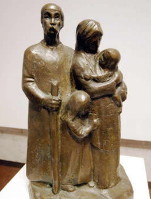
|
SCULPTURE. A general term in visual art for three-dimensional representations made by carving or modeling in a variety of materials, of which stone and clay are the most widely used. Sculpture encompasses monuments and statues, which are usually large in scale and are meant for public display; decorative or ornamental works; and small forms. Basically it may be divided into works that are freestanding and works that are attached to a background (relief sculpture). In most regions of Ukraine the development of sculpture was hindered by the hostile attitude of the Orthodox church to sculptural images. Sculpture was limited to relief carvings, mostly in stone or wood. They were often limited to architectural decorations and carvings of the iconostases. During Renaissance secular buildings, especially in Galicia, were lavishly decorated with carved reliefs. It is also in Galicia that the best and most numerous examples of three-dimensional sculpture are to be found. There sculpture was incorporated into church and secular architecture and were particularly popular in Roman Catholic churches. The developement of sculpture in Ukraine during classicism was inspired by Greek rather than Roman prototypes and was more geometric and austere. However, classicism coincided with the decline of Ukrainian autonomy and the annexation of eastern and most of central Ukraine by Russia. Thus, most prominent Ukrainian sculptors in Russian-ruled Ukraine were compelled to work within the Imperial Russian context in Saint Petersburg or abroad... |
| Sculpture |
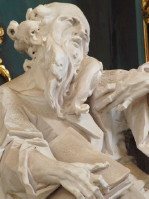
|
PINZEL, JOHANN GEORG, b ? d ca 1761. Eighteenth-century sculptor; the leading representative of the so-called 'Lviv school' of the late-baroque and rococo sculpture. Almost nothing is known of Pinzel's origins and personal life. In the mid 1740s he appeared in Buchach at the court of the starosta of Kaniv, Mikolaj Bazyli Potocki, and from that time he worked in Galicia, often in cooperation with the architect Bernard Meretyn. The most famous of his surviving works are the rococo stone statues of Saint Louis, Saint Athanasius, and Saint George on the facade of Saint George's Cathedral in Lviv (1759-61), the monuments of Saint John of Nepomuk and Saint Anna in Buchach, and the wood statues of the side altars in the Roman Catholic churches in Horodenka (1750s) and Monastyryska (1761). The stone carvings on the facade of the Buchach town hall, the figures and bas-reliefs in the Buchach Holy Protectress Church, and the sculpted church decorations in the Trinitarian Church in Lviv are attributed to him. He carved several crucifixions, the most interesting of which was in Saint Martin's Roman Catholic Church in Lviv. His work had a powerful influence on many eighteenth-century Galician sculptors and contributed to the establishment of the Galician tradition of rococo sculpture. The Pinzel Museum, a branch of the Lviv Art Gallery housing Pinzel's sculptures, was opened in Lviv in 1996 in the former church of the Clarissines. In 2012 a large exhibition of Pinzel's work took place at the Louvre Museum in Paris...
|
| Johann Georg Pinzel |
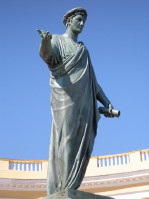
|
MARTOS, IVAN, b ca 1752-4 in Ichnia, Pryluky regiment, d 17 April 1835 in Saint Petersburg. Sculptor; father of Oleksander Martos. Born into a Cossack starshyna family of the Poltava region, Martos studied at the Saint Petersburg Academy of Arts (1764-73) and in Rome (1774-9), where he became a proponent of Classicist style of sculpture. He taught at the Saint Petersburg Academy (1779-1835) and served as its rector (1814-35). Martos created numerous sculptures in Russia and Ukraine, including the burial monuments of Hetman Kyrylo Rozumovsky in Baturyn (1803-5) and Count Petr Rumiantsev at the Kyivan Cave Monastery (1797-1805) and statues of Count Armand-Emmanuel du Plessis duc de Richelieu in Odesa (1823-8), Emperor Alexander I in Tahanrih (1828-31), and Prince Grigorii Potemkin in Kherson (1829-36). His works are noted for their monumental, but restrained and lucid classicist form that conform to the Classical ideal of beauty and idealize the virtues of courage, patriotism, and civic duty. His work had a considerable influence on many sculptors in the Russian Empire in the first half of the 19th century... |
| Ivan P. Martos |
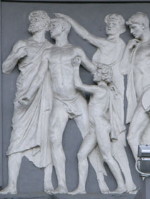
|
BALAVENSKY, FEDIR, b 31 December 1864 in Liubotyn near Kharkiv, d 8 November 1943 in the village of Lianozovo, Moscow oblast. Sculptor and pedagogue. He graduated from the Kyiv Drawing School in 1896 and the Saint Petersburg Academy of Arts in 1903. Balavensky lectured at art schools in Kyiv (1907-22) and at the Ceramic Technical School in Myrhorod (1922-30). Among his works are busts of Taras Shevchenko, Mykola Lysenko, Ivan Kotliarevsky, and Panteleimon Kulish; the Shevchenko monuments in Kyiv (which won second prize in a 1911 international contest and was demolished by Anton Denikin's troops in 1919), Lubny, Zolotonosha, and Myrhorod (1924-6); and the bronze gravestone bust of Marko Kropyvnytsky in Kharkiv (1914). In Kyiv Balavensky executed a number of allegorical statues on the Red Cross building (1913), co-sculpted the bas-relief Triumph of Phryne on the Iserlis building (1909), and designed the hippodrome (1916). In his sculptures Balavensky combined classicism with Ukrainian folk elements. A study of Balavensky by H. Bohdanovych was published in Kyiv in 1963... |
| Fedir Balavensky |
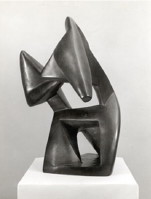
|
ARCHIPENKO, ALEXANDER (ARKHYPENKO, OLEKSANDER), b 30 May 1887 in Kyiv, d 25 February 1964 in New York. Modernist sculptor, painter, and pedagogue. Archipenko studied art at the Kyiv Art School in 1902-5, in Moscow in 1906-8, and then briefly at the Ecole des Beaux-Arts in Paris. His first one-man show took place in 1906 in Ukraine. He moved to Paris in 1909. From 1910 he exhibited his works with a group of Cubists and in 1912 he joined a new artistic group--La Section d'Or, which numbered among its members Pablo Picasso and Georges Braque. Also in 1912 he opened his own school of sculpture in Paris. In the early 1910s Archipenko became the most prominent cubist sculptor of his generation, who utilized interdependent geometrical lines and introduced new concepts and methods into sculpture. In 1912 he created the first modern sculpture made of various polychromed materials (wood, glass, and metal fiber). At this time he created the first so-called sculpto-peintures (carved and painted plaster reliefs) and the first modern sculpture composed of concave forms contrasted with convex ones and incorporating elements of color and the void. From 1919 to 1921 Archipenko's works were exhibited in many cities throughout Europe. In 1920 he was given a separate pavilion at the Venice Biennale. In 1923 he moved to the United States. He established a school in New York, and in the following year, he moved it to Woodstock, New Jersey... |
| Alexander Archipenko (Oleksander Arkhypenko) |
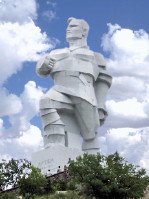
|
KAVALERIDZE, IVAN, b 26 April 1887 at Ladanskyi khutir near Romny, Kharkiv gubernia, d 3 December 1978 in Kyiv. Sculptor, film director, dramatist, and screenwriter. He studied art at the Kyiv Art School (1907-9), the Saint Petersburg Academy of Arts (1909-10), and with N. Aronson in Paris (1910-11). His sculptures include busts of famous people such as F. Chaliapin (1909), and over 100 monuments in various cities of Ukraine: eg, the monument to Princess Olha in Kyiv (1911), which was destroyed in 1934; the Taras Shevchenko monuments in Kyiv (1918), Romny (1918), Poltava (1925), and Sumy (1926); and the Hryhorii Skovoroda monuments in Lokhvytsia (1922) and Kyiv (1977). In the 1920s his work was influenced by cubism, as exemplified by his monument to Artem in Artemivsk, Donetsk oblast. His group compositions, such as Bohdan Khmelnytsky Sends the Kobza Players into the Villages (1954), Amvrosii Buchma in the Role of M. Zadorozhny (1954), and Prometheus (1962)--are somewhat stylized. In 1928 he became interested in filmmaking. He scripted and directed a number of innovative historical films marked by stylization and monumentalism. A retrospective exhibit of his sculptures was held in 1962... |
| Ivan Kavaleridze |
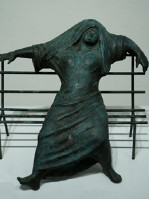
|
KRUK, HRYHORII, b 30 October 1911 in Bratyshiv, Tovmach county, Galicia, d 5 December 1988 in Munich. Sculptor. A graduate of the Lviv School of Decorative Art (1934), the Cracow Academy of Arts (1937), and the Berlin Academy of Arts (1940), he settled in Munich at the end of the Second World War and devoted himself to sculpture. By 1960 he had produced up to 200 sculptures and had established a Europe-wide reputation. His works were displayed at one-man shows: in Munich (1952, 1963, 1969), Paris (S. Badinier Gallery, 1954), London (1954), Edinburgh (1954), Bonn (1955), Rome (1957), New York and Philadelphia (1961), Vienna (1962), Toronto (1964, 1981), and Geneva (1971). Kruk was a thoroughly modern artist, who attempted to go beyond the traditional norms in search of the immediate, instinctive impression evoked by an expressive, suitably deformed form. He remained true to his peasant origins: his strong bond with the earth was expressed through the massiveness, heaviness, and brutal vitality of his figures. He sculpted many portraits, including those of Pope Paul VI and Cardinal Yosyf Slipy, and figures of peasants, monks, Cossacks, bandurists, rabbis, working women, and dancers. Kruk's sculptures have been presented in three albums. His drawings, which have been published in a special album (1980), are distinguished also by immediacy and spontaneity... |
| Hryhorii Kruk |
The preparation, editing, and display of the IEU entries the art of sculpture in Ukraine were made possible by the financial support of the CANADIAN FOUNDATION FOR UKRAINIAN STUDIES.
 VI. THE ART OF UKRAINIAN BAROQUE ENGRAVING
VI. THE ART OF UKRAINIAN BAROQUE ENGRAVING
In Ukraine, from the 11th to the 16th century manuscript books were ornamented with headpieces, initials, tailpieces, and illuminations. Many of these features appeared as well in the first printed books. In the late 16th century Lviv became the first center of printing and graphic art and one of the first influential engravers was Lavrentii Fylypovych-Pukhalsky. Graphic-art centers also arose at printing presses established in Ostrih, Volhynia, in Striatyn and Krylos in Galicia, and finally in Kyiv at the highly advanced engraving shop of the Kyivan Cave Monastery Press. Beginning in the second half of the 17th century, in addition to religious themes, secular and everyday subjects, portraits, town plans, etc were depicted in graphic form. During the Ukrainian baroque period, which coincided with the Hetman state, engraving became highly developed, utilizing not only new forms, but also allegory, symbolism, heraldry, and very ornate decoration. These characteristics suited the belligerency and dynamism of the Cossack period, whose apogee during the hetmancy of Ivan Mazepa defined the artistic fashion for the late 17th and early 18th centuries. The most famous Kyivan craftsman of the time was the portraitist and illustrator Oleksander Tarasevych (active from 1667 to 1720). Other notable craftsmen were Ivan Shchyrsky, Zakharii Samoilovych, Leontii Tarasevych, Ivan Strelbytsky, and Ivan Myhura, who was known for his very personal style incorporating folk art motifs. In Western Ukraine most prominent master engravers included Dionisii Sinkevych and Nykodym Zubrytsky. After the defeat of Ivan Mazepa at the Battle of Poltava in 1709, cultural life in Ukraine declined because of Russian political restrictions and the migration of Ukrainian intellectuals and artists to Saint Petersburg. Nevertheless, Kyiv still had such craftsmen as Averkii Kozachkivsky and especially Hryhorii K. Levytsky, the most prominent Ukrainian engraver of the 18th century... Learn more about art of Ukrainian baroque engraving by visiting the following entries:
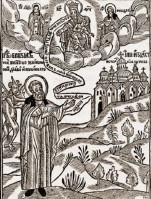
|
MASTER ILLIA, b and d ? A 17th-century wood engraver. A monk at Saint Onuphrius's Monastery, in the 1630s he worked as an engraver in Lviv. From 1640 to about 1680 he worked at the Kyivan Cave Monastery Press. During his career he produced about 600 woodcuts for illustrations, title pages, headpieces, and prints. His work decorated such books as the Euchologion of Petro Mohyla (Kyiv 1646), one of the finest examples of Ukrainian book design of the time; the Nomocanon (Lviv 1646); the Kyivan Cave Patericon (Kyiv 1661, 1678); and Lazar Baranovych's Mech dukhovnyi (The Spiritual Sword, 1666) and Antin Radyvylovsky's Ohorodok Marii Bohorodytsi (The Garden of Mary, the Mother of God, 1676). Two albums of his woodcuts were published in Kyiv in the 1640s, and a collection of 132 of his biblical illustrations appeared at the end of the 17th century. Illia was a master of the thematic woodcut. His illustrations depict daily life, landscapes, buildings, and famous monks of the Kyivan Cave Monastery... |
| Master Illia |
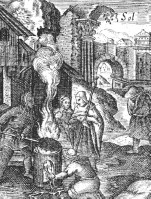
|
TARASEVYCH, OLEKSANDER, b ca 1640, probably in Transcarpathia, d ca 1727 in Kyiv. Engraver and church figure; founder of the Ukrainian school of metal engraving. He and his brother, Leontii Tarasevych, learned engraving in Augsburg. Oleksander lived and worked in Hlusk, Belarus, and in Vilnius before returning to Ukraine in 1688 to take monastic vows at the Kyivan Cave Monastery and direct the engraving workshop at the Kyivan Cave Monastery Press. Later he served as acting archimandrite of the Svensk Monastery, near Briansk, and the Kyivan Cave Monastery. Tarasevych masterfully executed copper engravings depicting scenes from the New Testament, heraldic compositions, and portraits of Catholic and Orthodox saints and contemporary Ukrainian and Belarusian hierarchs, Cossack colonels, and Polish and Lithuanian monarchs and nobles. In Vilnius and Kyiv he trained many professional engravers. Books and albums from his personal library were used as instructional materials in the workshops of the Kyivan Cave Monastery in the 18th and 19th centuries... |
| Oleksander Tarasevych |
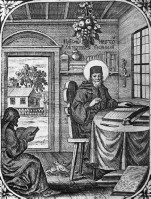
|
TARASEVYCH, LEONTII, b ca 1650, probably in Transcarpathia, d 1710 in Kyiv. Master engraver. He and his brother, Oleksander Tarasevych, learned engraving in Augsburg at the workshop of B. and P. Kilian. In 1680-8 he worked in Vilnius, where he engraved illustrations for the Basilian, Franciscan, and Jesuit presses there. From 1688 he worked in Ukraine, first in Chernihiv and then in Kyiv at the Kyivan Cave Monastery Press under the patronage of Metropolitan Varlaam Yasynsky. Tarasevych engraved portraits of prominent Ukrainians, Poles, and Russians, including Hetman Ivan Mazepa; portrayals of the Catholic and Orthodox saints; heraldic and corporation crests; theses of scholarly disputes at the Vilnius Academy and Kyivan Mohyla Academy, decorated with many symbols, allegories, and saints; and book illustrations, notably 45 engravings for the Kyivan Cave Patericon printed by the Kyivan Cave Monastery Press in 1702. Tarasevych helped establish the art of copper engraving in Ukraine and created some of the best works in Ukrainian baroque graphic art... |
| Leontii Tarasevych |
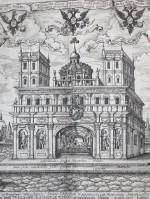
|
SCHYRSKY, IVAN, b ca 1650, most likely in the Chernihiv region, d 1714 in Liubech, Chernihiv regiment. Baroque engraver. He studied engraving under Oleksander Tarasevych at the Vilnius Academy Press (1677-80) and theology and literature at the academy. He worked as a master engraver in Vilnius and then in Chernihiv and Kyiv, where he also taught poetics at the Kyivan Mohyla College. In 1686 he took monastic vows at the Kyivan Cave Monastery, and soon afterward he cofounded the Saint Anthony of the Caves Monastery in Liubech. Shchyrsky created over 100 masterful copper engravings. Those from his Vilnius period included copies of the Czestochowa and other miraculous icons, coats of arms (eg, for Adam Kysil), and pictures of various saints. During his time in Ukraine he created many fine, detailed engravings: illustrations for religious and panegyrical books, coats of arms, the famous engraving Labarum triumphale (1698) for the poetic thesis honoring the rector of the Kyivan Mohyla College; a portrait of Metropolitan Varlaam Yasynsky (1707), and others... |
| Ivan Shchyrsky |
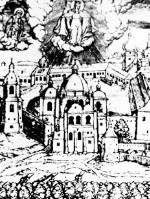
|
ZUBRYTSKY, NYKODYM, b 1688 in the Lviv region, d 1724. Engraver. He worked for the presses in the Krekhiv Monastery, Lviv (1691-1702), and the Pochaiv Monastery (1704) before being invited by Hetman Ivan Mazepa to Kyiv to work in the Kyivan Cave Monastery Press (1705-12). He later moved to Chernihiv and worked for the Chernihiv Press (1712-24). Almost 400 of his engravings have been preserved, including 67 illustrations and ornaments etched in copper for the illustrated philosophical-moralistic book Ifika iieropolitika (1712), some illustrations and ornaments for an edition of the New Testament (1717), and the famous print Turkish Siege of Pochaiv (1704). The themes of his genre prints were often taken from folk stories and legends... |
| Nykodym Zubrytsky |
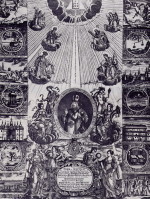
|
LEVYTSKY, HRYHORII K., b ca 1697 in Maiachka, Poltava regiment, d 19 May 1769 in Maiachka. Baroque master engraver and painter. Levytsky studied engraving in Wroclaw (until 1735). From ca 1738-41 he was an Orthodox priest in Maiachka and continued to do engravings for the Kyivan Cave Monastery Press. Over 40 of his engravings illustrate the press's Gospel (1737), Psalter (1737), and Apostolos (1737-8 and 1752), the title pages and ornamentation of Kyivan Mohyla Academy students' theses in verse. He also prepared four engraved boards for Mykhail Kozachynsky's collection of theses on Aristotle's philosophy (Lviv 1745), containing portraits, coats of arms, cartouches, allegories, symbols, views of Kyiv's architectural monuments, genre scenes, and Oleksii Rozumovsky's family tree. In 1753-6, together with his son, (later famous portraitist) Dmytro H. Levytsky, and Aleksei Antropov, Levytsky painted rococo murals inside Saint Andrew's Church in Kyiv... |
| Hryhorii K. Levytsky |
The preparation, editing, and display of the IEU entries about the art of Ukrainian baroque engraving were made possible by the financial support of the CANADIAN FOUNDATION FOR UKRAINIAN STUDIES.
 VII. MASTERPIECES OF ROCOCO ARCHITECTURE IN UKRAINE
VII. MASTERPIECES OF ROCOCO ARCHITECTURE IN UKRAINE
In some ways, rococo represented the continuation and conclusion of the baroque period in art and architecture. At the tame time, it signified a fundamental departure from the pathos and striving for the supernatural and spiritual that characterized the creative mind of a baroque artist. Rococo developed at first in a decorative art in the early 18th century in France. Lighter designs, graceful decorative motifs with many shell forms (rocaille in French) and natural patterns, as well as small-scale sculpture inspired by trivial subject matter progressively replaced the flamboyant forms of the baroque architecture, overloaded with unrestrained ornamentation. In Ukraine, where baroque influences were particularly strong and long-lasting, rococo and baroque architectural influences were often intermingled. Rococo influences in Ukrainian sculpture can be seen particularly in iconostases, where carved shell motifs and interlace patterns replaced grapevines and acanthus foliage, often without structural logic. Bartolomeo Francesco Rastrelli and Bernard Meretyn were among the most important rococo architects in Ukraine... Learn more about the masterpieces of rococo architecture in Ukraine by visiting the following entries:
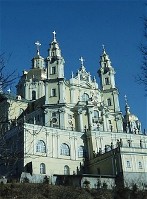
|
ROCOCO. An architectural and decorative style that emerged in France in the early 18th century. Examples of the rococo style in Ukraine are Saint Andrew's Church (1747-53) in Kyiv; the Cathedral of the Nativity of the Mother of God (1752-63) in Kozelets, Chernihiv gubernia; the Roman Catholic churches of the Dominican order in Lviv (1747-64) and Ternopil (1745-9); Saint George's Cathedral (1745-70) in Lviv; the Dormition Cathedral at the Pochaiv Monastery (1771-83) in Volhynia; and the town hall (1751) in Buchach, Galicia. The iconostases of Saint Andrew's Church in Kyiv and the church of the Mhar Transfiguration Monastery (1762-5) in Poltava gubernia have delicately carved rococo surface decorations. In religious painting the rococo style had little impact in Ukraine because of the strong hold of the baroque. A few still lifes, intimate in scale, appeared for the first time, however, and rococo design and decoration left a mark on furniture produced in Hlukhiv and Nizhyn in Chernihiv gubernia and in Olesko in Galicia... |
| Rococo |
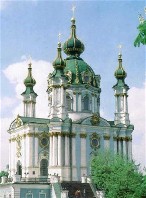
|
SAINT ANDREW'S CHURCH IN KYIV. A masterpiece of rococo architecture in Kyiv. It was designed for Empress Elizabeth I by Bartolomeo Francesco Rastrelli and built under the direction of I. Michurin in 1747-53. Set on a hill above the Podil district on a cruciform foundation atop a two-story building, the church has a central dome flanked by four slender towers topped with small cupolas. The exterior is decorated with Corinthian columns, pilasters, and complex cornices designed by Rastrelli and made by master craftsmen, including the Ukrainians M. Chvitka and Ya. Shevlytsky. The interior has the light and grace characteristic of the rococo style. The iconostasis is decorated with carved gilded ornaments, sculptures, and icon paintings done in 1751-4 by Aleksei Antropov and his assistant at the time, Dmytro H. Levytsky. During the Seven Years' War the imperial court lost interest in the church, and it was unfinished when it was consecrated in 1767. Since 1958 the church has been a branch of the Saint Sophia Museum... |
| Saint Andrew's Church |
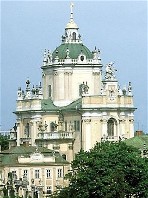
|
SAINT GEORGE'S CATHEDRAL IN LVIV. One of the finest examples of rococo church architecture in Europe. The cathedral's complex, consisting of the church, the campanile (its bell was made in 1341), the metropolitan's palace, office buildings, a wrought-iron fence, two gates, and a garden, stands on a high terrace overlooking the old city of Lviv. The church was designed by and built under the direction of Bernard Meretyn in 1744-59 and finished in 1764 by S. Fessinger, who also built the adjacent metropolitan's residence (1761-2). Built on a cruciform ground plan, the four-column church is topped by one large cupola and four small ones. The high exterior walls are decorated with simplified Corinthian pilasters, rococo stone lanterns, and a cornice. Two stairways with delicate rococo balustrades lead to the main entrance, which is flanked by statues of Ukrainian Metropolitans Atanasii Sheptytsky and Lev Sheptytsky. The cathedral serves as the seat of the Ukrainian Catholic Halych metropoly... |
| Saint George's Cathedral |
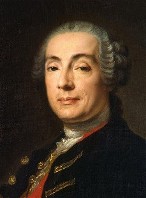
|
RASTRELLI, BARTOLOMEO FRANCESCO, b 1700 in Paris, d 1771 in Saint Petersburg. Architect of Italian origin. Having arrived in Saint Petersburg in 1716 with his father, Carlo Bartolomeo Rastrelli, who did many sculptures for Emperor Peter I, he was appointed court architect in 1730. His renovations of the Great Palace in Peterhof (1747-52; now Petrodvorets), the Catherinian Palace in Tsarskoe Selo (1752-7), the Winter Palace (1754-62), Mikhail Vorontsov's palace (1749-57), and S. Stroganov's palace (1752-4) in Saint Petersburg are the finest examples of late baroque and rococo architecture. He designed two outstanding buildings in Kyiv, Saint Andrew's Church (1747-53) and the Mariinskyi Palace (1752-5)... |
| Bartolomeo Rastrelli |
The preparation, editing, and display of the IEU entries featuring the masterpieces of rococo architecture in Ukraine were made possible by the financial support from TEODOR BUTREJ's bequest to the CANADIAN FOUNDATION FOR UKRAINIAN STUDIES.
 VIII. UKRAINIAN CLASSICIST PAINTERS AND SCULPTORS
VIII. UKRAINIAN CLASSICIST PAINTERS AND SCULPTORS
Drawing inspiration from the art and culture of classical antiquity of ancient Greece and Rome, classicism developed in the mid 18th century in western Europe (primarily in France and England) in opposition to the then-dominant Rococo esthetics. Generally, the classicist style was associated with harmony, restraint, and adherence to recognized "classical" standards of form, beauty, and craftsmanship. It promoted such characteristics of a work of art or literature as symmetry, decorum, harmony, and idealism. This style was linked, on the one hand, with the ideals of the Age of Enlightenment, and, on the other hand, with the dominance of an imperial political order. Classicism came to Ukraine from central and southern Europe in the second half of the 18th century. Politically and culturally, this was the time of Ukraine's national decline. The processes of Russification and colonization of Ukraine, resulting from the imperialist policies of Catherine II and the dissolution of the Cossack Hetman state, contributed to the denationalization of the potential leaders of Ukraine's cultural life: the nobility and higher clergy. Ukrainian classicist painters had a vital influence on the development of Russian and eastern European painting, but all of them worked and created in Saint Petersburg. Among these painters were Antin Losenko, who introduced the style of classicism to the Russian Empire and founded the historical school at the Russian Academy of Arts; Dmytro H. Levytsky, who was the leading portraitist of his time; and Levytsky's student Volodymyr Borovykovsky, who painted icons and portraits. The masters of decorative painting, which was very typical of the period and was widely used in the palaces in Ukraine, were Hryhorii Stetsenko, Yurii Kozakevych, I. Kosarevsky, and the painter-serf M. Dykov. Vasilii Tropinin (a Russian who spent many years in Podilia), M. Terensky of Peremyshl, and Luka Dolynsky and I. Luchynsky of Lviv were realist painters of the classicist school. Classicism is reflected in the engravings of Hryhorii Srebrenytsky, Mykhailo Kozlovsky, and Volodymyr Borovykovsky and in the autolithographs of I. Shchedrovsky, P. Boklevsky, Kostiantyn Trutovsky, Mykhail Mykeshyn, and others. In sculpture classicism in the Russian Empire was also represented by a Ukrainian, Ivan P. Martos, who worked in Saint Petersburg and Moscow and was the leading artist and teacher at the end of the 18th century, and by Kostiantyn Klymchenko, who worked in Rome. Because of the innate nature of this artistic style, the works of classicist painters, sculptors, and architects are devoid of national traits so the works of Ukrainian masters of the classicist style were easily appropriated by the Russian imperial culture. Classicism survived in Ukraine until the middle of the 19th century, when it turned into academism... Learn more about the Ukrainain master artists of the classicist style by visiting the following entries:
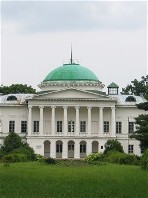
|
CLASSICISM. In the art of the 18th century the term classicism denoted a certain general style connected with the esthtic ideals of classical Greek and Roman cultures and with works of art whose simplicity and severity of form contrasted with the decorativeness of the baroque. Its influence was felt first in Western Ukraine, where it manifested itself mainly in the architecture of palaces and villas, such as the palace of the Ossolinskis in Lviv (now the Lviv National Scientific Library of Ukraine), built in 1827 by the Swiss architect P. Nobile, or the palace in Vyshnivets in the Ternopil region. Later these kinds of buildings were built in central and eastern Ukraine by Italian, French, English, and German architects. The largest number of the finest examples of architectural classicism have been preserved in the Chernihiv region: the palace of Count Petro Zavadovsky in Lialychi designed by Giacomo Quarenghi in 1794-5; the building of Mykhailo P. Myklashevsky in Nyzhnie (second half of the 18th century), V. Darahan's residence in Kozelets; and the palaces of a patron of classicism, Hetman Kyrylo Rozumovsky, in Pochep (built in 1796 by Oleksii Yanovsky) and in Baturyn (built in 1799-1803 according to the design of C. Cameron). The classicist style was also embodied in numerous manor houses, churches, and town buildings throughout Ukraine. The most typical buildings of the 19th century in this style are the palaces in the village of Murovani Kurylivtsi (1805); the buildings of the Sofiivka Park near Uman (1796-1805); P. Galagan's palace in Sokyryntsi, designed by P. Dubrovsky in 1829; the Bezborodko Nizhyn Lyceum, designed by L. Rusca in 1824; the Kyiv University building, designed by Vincent Beretti in 1837-42; the new building of the Kyivan Mohyla Academy, designed by Andrei Melensky in 1822-5; and the cathedral in Sevastopol, built in 1843. In these buildings classicism was often combined with the Empire style, which was closely related to it... |
| Classicism |
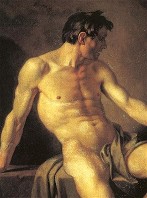
|
LOSENKO, ANTIN, b 10 August 1737 in Hlukhiv, Nizhyn regiment, Hetman state, d 4 December 1773 in Saint Petersburg. Painter; a leading exponent of historical painting in the classicist style. He studied in the Hlukhiv Singing School and was brought to Saint Petersburg to sing in the imperial court choir in the late 1740s. After his voice changed, he was sent to study art under Ivan Argunov (1753-8) and at the Saint Petersburg Academy of Arts (1758-60). Recognized for his exceptional talent, Losenko was promised a bursary to study in Paris where he arrived in 1760 and studied under Jean II Restout, but his stay there was cut short in 1762 when the imperial bureaucrats failed to send him his promised stipend. In Paris Losenko painted his first masterpiece The Miraculous Draught of Fishes (1762). In 1766-9 Losenko studied in Rome where he painted, among others, Cain (1768) and Abel (1769). After he was awarded several medals from the Paris Academy of Arts, Losenko's achievements were also recognized in Saint Petersburg. He became a member of and professor at the Saint Petersburg Academy in 1770, served as its director (1772-3), and wrote its textbook on human proportions (1772). Losenko's oeuvre includes paintings on biblical and mythological themes; paintings on historical themes, such as Grand Prince Volodymyr and Rohnida (1770); portraits of prominent personalities; a self-portrait; and some 200 drawings of nude figures and parts of the body, which were held up as models of excellence to students at the academy for many years. Losenko introduced to the art of the Russian Empire the classicist pompier style of painting and was the first painter to depict in this style, in addition to the traditional mythological and biblical motifs, also themes from the history of Kyivan Rus'. Most of his works are preserved at the Russian Museum in Saint Petersburg and the Tretiakov Gallery in Moscow. Only his Abel is housed in Ukraine, in the Kharkiv Art Museum... |
| Antin Losenko |
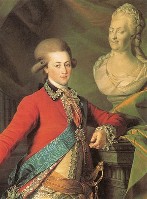
|
LEVYTSKY, DMYTRO, b 1735 in Kyiv, d 16 April 1822 in Saint Petersburg. The most prominent portraitist of the classicist era in the Russian Empire. He acquired his basic training from his father, Kyiv painter and master engraver Hryhorii K. Levytsky, whom he helped to do engravings for the Kyivan Cave Monastery Press. In 1753-6 he assisted his father and Aleksei Antropov in decorating Saint Andrew's Church in Kyiv. From 1758 to 1761 he worked in Saint Petersburg, where he likely studied with Antropov, L.-J.-F. Lagren?, and G. Valeriani. From 1762, while living in Moscow he was a portraitist in great demand among the Russian aristocracy. He moved to Saint Petersburg in 1769, and he won the highest award at the summer exhibition in 1770 held by the Saint Petersburg Academy of Arts and was elected a member of the academy. Together with a number of his Ukrainian compatriots in Saint Petersburg, Levytsky was an active Freemason and member of Saint Petersburg's Masonic lodge. A teacher of portraiture at the academy (1771-88), he retired to Ukraine in 1788, but in 1795 he returned to Saint Petersburg to become portraitist at the imperial court. Building on the baroque, classicism, and Western European traditions, Levytsky created a school of portrait painting. His portraits reveal his expert knowledge of drawing, composition, color, and the appropriate gesture. He executed over 100 portraits, including ones of Empress Catherine II, other members of the Russian imperial family, King Stanislaus I Leszczynski, the French encyclopedist Denis Diderot, and his own father, Hryhorii K. Levytsky. One of his paintings is in the permanent collection of the Louvre Museum in Paris. Many Ukrainian and Russian portraitists studied with Levytsky at the academy, and his works influenced the second most prominent portraitist of this period in the Russian Empire, Volodymyr Borovykovsky... |
| Dmytro H. Levytsky |
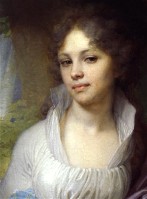
|
BOROVYKOVSKY, VOLODYMYR, b 4 August 1757 in Myrhorod, Myrhorod regiment, Hetman state, d 18 April 1825 in Saint Petersburg. Iconographer and portrait painter, son of Luka Borovyk (d 1775) who was a Cossack fellow of the banner and an iconographer. Borovykovsky was trained in art by his father and uncle and then in 1788 went to study portrait painting under Dmytro H. Levytsky at the Saint Petersburg Academy of Arts. In 1793 he became an academician there. Until 1787 Borovykovsky lived and worked in Ukraine. During his career he painted many churches, icons, and iconostases, only some of which have been preserved: the icons of Christ (1784) and the Virgin Mary (1784 and 1787), now in Kyiv, the icon of SS Thomas and Basil (1770s, in Myrhorod), the iconostases and wall paintings in the village churches in Kybyntsi in the Poltava region and Ichnia in the Chernihiv region, and others. Borovykovsky's religious art departed from the established norms of Byzantine iconography in the Russian Empire and tended towards a realistic approach. In Saint Petersburg Borovykovsky painted about 160 portraits, among them Ukrainian public figures, such as Dmytro Troshchynsky (1819). Among the large number of official portraits he painted are the full-figure portraits of Catherine II (1794) and Paul I (1800). At the beginning of the 1790s Borovykovsky began to paint miniatures and portraits of women in the Ukrainian iconographic style. Adhering to the spirit of classicism, he promoted West European traditions through his art; in his later works he introduced the style of Sentimentalism and proto-Romanticism in painting. The largest number of Borovykovsky's works can be found in the museums of Saint Petersburg and Moscow. In Ukraine they can be seen in the museums of Kyiv, Kharkiv, Odesa, Poltava, Dnipro, Kherson, and Simferopol... |
| Volodymyr Borovykovsky |
_s.jpg)
|
MARTOS, IVAN, b ca 1754 in Ichnia, Pryluky regiment, Hetman state, d 17 April 1835 in Saint Petersburg. Sculptor; father of Oleksander Martos. Born into a Cossack starshyna family of the Poltava region, Martos studied at the Saint Petersburg Academy of Arts (1764-73) and in Rome under Antonio Canova (1774-9), where he became a proponent of Classicist style of sculpture. He taught at the Saint Petersburg Academy (1779-1835; as senior professor from 1794) and served as its rector (1814-35). Martos created numerous sculptures in Russia and Ukraine, including the burial monuments of Hetman Kyrylo Rozumovsky in Baturyn (1803-5) and Count Petr Rumiantsev at the Kyivan Cave Monastery (1797-1805) and statues of Count Armand-Emmanuel du Plessis duc de Richelieu in Odesa (1823-8), Emperor Alexander I in Tahanrih (1828-31), and Prince Grigorii Potemkin in Kherson (1829-36). His works are noted for their monumental, but restrained and lucid classicist form that conform to the Classical ideal of beauty and idealize the virtues of courage, patriotism, and civic duty. His work had a considerable influence on many sculptors in the Russian Empire in the first half of the 19th century... |
| Ivan Martos |
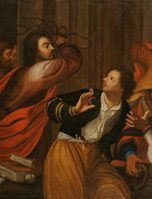
|
DOLYNSKY, LUKA, b ca 1745 in Bila Tserkva, d 10 March 1824 in Lviv. Painter. Orphaned during the time of the haidamaka uprisings in Right-Bank Ukraine, Dolynsky found support with the Uniate metropolitan of Kyiv Pylyp Volodkovych who recognized his talent and sent him to Lviv to Metropolitan Lev Sheptytsky who became Dolynsky's mentor. Dolynsky studied with Yurii Radylovsky in Lviv in 1770-1 and was later sent to study at the Vienna Academy of Arts (1775-7). In 1777 he settled permanently in Lviv, where he worked as a church artist and portraitist. He painted the interior of Saint George's Cathedral (1770-1 and 1777), decorating the iconostasis and the side altars. In the 1780s and 1790s he decorated various churches in Lviv, including the Church of the Holy Spirit, the Church of Saints Peter and Paul, and the Church of Good Friday in Lviv, and churches in nearby villages. In 1807 and 1810 he painted and gilded the Dormition Cathedral of the Pochaiv Monastery, and in 1820-1 the iconostasis and murals in Saint Onuphrius's Church in Lviv. Dolynsky painted portraits of Prince Lev Danylovych (1770-1), Maria Theresa and Joseph II (1775-7), Metropolitan Fylyp Volodkovych, and others. In combining classical and original Ukrainian stylistic features, he departed from the Lviv guild tradition of icon painting... |
| Luka Dolynsky |
The preparation, editing, and display of the IEU entries dealing with Ukrainain master artists of the classicist style were made possible by the financial support of the CANADIAN FOUNDATION FOR UKRAINIAN STUDIES.
 IX. ACADEMISM IN 19TH-CENTURY UKRAINIAN PAINTING
IX. ACADEMISM IN 19TH-CENTURY UKRAINIAN PAINTING
In the first half of the 19th century realism began to replace classicism in Ukrainian art, but an eclectic artistic movement referred to as academism continued to flourish, as it did in other parts of Europe, almost to the end of the century. Academism was a style of painting and sculpture produced under the influence of European academies or universities. Most notably, academism was influenced by the standards of the French Academie des Beaux-Arts in Paris, whose representatives followed the movements of Classicism and Romanticism in an attempt to create a synthesis of these styles and traditions. In this context, academism may also be referred to as 'L'art pompier' or 'eclecticism.' Another trend during this period, referred to as 'historicism,' focussed on producing stylized paintings on historical themes aiming to represent the era in history that the painting depicted. Academism also placed particular importance on allegory in art since paintings were desired to embody an 'idee,' a full and complete idea. Opposed to realism, academism strived toward elevated idealism in art, often choosing religious, or even more frequently, mythological themes and motifs as subject matter for paintings. Many Ukrainian artists of the first half of the 19th century, such as those who studies in the Saint Petersburg Academy of Arts under the famous academist painter Karl Briullov, were strongly influenced by academism. However, from the 1840s on, many Ukrainian artists turned away from the dogmatism and narrow limits of academism and adopted other styles. For example, Taras Shevchenko, the national bard of Ukraine who was a painter and engraver by profession, began to produce realistic depictions of scenes from the daily life of the peasantry and from Ukrainian history. A number of his followers adopted this approach, eventually giving rise to a Ukrainian ethnographic school of genre painting. Other Ukrainian painters cofounded the realist art movement of the so-called Peredvizhniki who desired to produce popular art and organized regular traveling exhibitions throughout the Russian Empire... Learn more about academism in 19th-century Ukrainian painting by visiting the following entries:
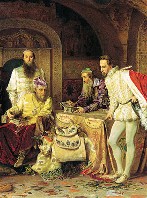
|
ACADEMISM. Art movement based on ancient Greek esthetics and on the dogmatic imitation of primarily classical art forms. Academism first arose in the art academies of Italy in the 16th century and then in France; later it spread to other countries. Art academies were founded in Rome, Paris, Vienna, Berlin, Saint Petersburg, Munich, Cracow, and other cities. Many Ukrainian artists graduated from these schools; for example, Antin Losenko, Ivan Buhaievsky-Blahodarny, Ivan Soshenko, Taras Shevchenko, Dmytro Bezperchy, Volodymyr Orlovsky, Apollon Mokrytsky, Ivan Aivazovsky, Kornylo Ustyianovych, and Teofil Kopystynsky. As advanced schools of art theory and practice, the academies played a positive role in the development of these artists, but eventually their conservatism and dogmatism, their restriction of artistic freedom, and their narrow limits on the selection of theme and formal means (composition, color, technique) called forth a strong reaction among progressive artists. These artists organized their own art groups with anti-academic programs, such as the romantics, the Peredvizhniki, the impressionists, and the Secessionists. Ukrainians--for example, Taras Shevchenko, Mykola Ge, Ivan Kramskoi, Oleksander Lytovchenko, Mykola Bodarevsky, Mykola Pymonenko, and Mykola Yaroshenko, and in time the Ukrainian impressionists--participated in this reaction too. The principles of academism were later revived in the 20th century in Soviet art in Ukraine and primarily manifested itself in socialist-realist portraiture, which was photographically accurate and conformed to officially approved models... |
| Academism |
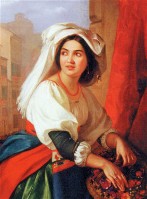
|
MOKRYTSKY, APOLLON, b 12 August 1810 in Pyriatyn, Poltava gubernia, d 8 or 9 March 1870 in Moscow. Painter; full member of the Saint Petersburg Academy of Arts from 1849. He studied painting under Kapiton Pavlov at the Nizhyn Lyceum and under Oleksii Venetsianov and Karl Briullov in Saint Petersburg (1830-9). In spite of financial hardships, Mokrytsky successfully completed his course of study at the academy thanks, to a large extent, to the support of his Ukrainian compatriot Vasyl Hryhorovych. After working in Ukraine and visiting Italy Mokrytsky was appointed a professor at the Moscow School of Painting, Sculpture, and Architecture (1851-70). His students included Ivan Shyshkin and Kostiantyn Trutovsky. Many of Mokrytsky's paintings, particularly the early ones, are executed in the style of academism. His later works, including portraits of Yevhen Hrebinka (1840) and Nikolai Gogol, a self-portrait (1840), and Italian landscapes, are painted in a lucid, realist style. Mokrytsky played an important role in the process of purchasing Taras Shevchenko's freedom; he introduced Shevchenko to influential Russian and Ukrainian intellectuals in Saint Petersburg, in particular, his teachers, artists Briullov and Venetsianov, and poet Vasilii Zhukovsky, who later helped to secure Shevchenko's freedom from serfdom. Mokrytsky left a diary (published in 1975) containing, among other things, information about Shevchenko... |
| Apollon Mokrytsky |
_s.jpg)
|
SHEVCHENKO, TARAS, b 9 March 1814 in Moryntsi, Zvenyhorod county, Kyiv gubernia, d 10 March 1861 in Saint Petersburg. Ukraine's national bard and famous artist. Born a serf, at the age of 14 Shevchenko became a houseboy of his owner, P. Engelhardt, and served him in Vilnius and then Saint Petersburg. Shevchenko spent his free time sketching statues in the capital's summer gardens. There he met the Ukrainian artist Ivan Soshenko, who introduced him to other compatriots, such as Apollon Mokrytsky, and to the painter Oleksii Venetsianov. Shevchenko later met the famous Russian painter Karl Briullov, who donated his painting as the prize in a lottery whose proceeds were used to buy Shevchenko's freedom in 1838. Soon after, Shevchenko enrolled in the Imperial Academy of Arts and studied there under Briullov's supervision. Although Shevchenko is known primarily because of his poetry, he was also an accomplished artist; 835 of his art works are extant, and another 270 of his known works have been lost. Trained in the style of academism, Shevchenko moved beyond stereotypical historical and mythological subjects to realistic depictions often expressing veiled criticism of the absence of personal, social, and national freedom under tsarist domination. His portraits have a broad social range of subjects, from simple peasants to prominent Ukrainian and Russian cultural figures and members of the imperial nobility. His portraits are remarkable for the way Shevchenko uses light to achieve sensitive three-dimensional modeling. He also painted and drew numerous landscapes. On 2 September 1860 the Imperial Academy of Arts recognized Shavchenko's mastery by designating him an academician-engraver... |
| Taras Shevchenko |
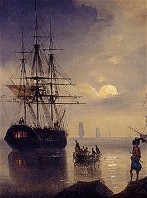
|
AIVAZOVSKY, IVAN, b 29 July 1817 in Teodosiia, Tavriia gubernia, d 5 May 1900 in Teodosiia. Painter of seascapes, landscapes, and genre paintings. Aivazovsky was descended from a family of Galician Armenians who had settled in the Crimea. He began to study art in Simferopol and completed his artistic education (in 1833-7) at the Imperial Academy of Arts in Saint Petersburg. In the early 1840s he travelled widely through Italy, France, England, the Netherlands, and the Ottoman Empire, and gained high reputation for his masterfully executed seascapes. He become an academician of the Saint Petersburg Academy of Arts in 1845 and an honorary member of the academy in 1887 (he was also a member of four other academies). In 1845 Aivazovsky settled in Teodosiia. He produced some 6,000 paintings, depicting mainly scenes on the Black Sea and turbulent seascapes and numerous Ukrainian landscapes. During his student years Aivazovsky often traveled in Ukraine with Vasilii Shternberg. In 1880 Aivazovsky established an artists' studio and picture gallery in Teodosiia, which he donated later to the city. The Aivazovsky Picture Gallery in Teodosiia houses some 400 of his works, as well as paintings by Crimean seascape artists and a small collection of seascapes by Western artists. Following the Russian annexation of the Crimea in 2014, some 40 of Aivazovsky's paintings have been removed by the Russian occupation authorities from his gallery in Teodosiia and transferred to the Tretiakov Gallery in Moscow... |
| Ivan Aivazovsky |
_s.jpg)
|
GE, MYKOLA (also: Gay, Gue), b 27 February 1831 in Voronezh, d 13 April 1894 at Ivanovskyi khutir, Bakhmach county, Chernihiv gubernia. Painter of mixed French and Ukrainian origin. Ge studied at Kyiv University (1847) and Saint Petersburg University (1848-9), and at the Saint Petersburg Academy of Arts (1850-7), where he later became a professor in 1863. Initially, Ge's style of painting was strongly influenced by his teacher Karl Briullov and the principles of academism taught at the Saint Petersburg Academy. In fact, he was one of the leading representatives of academism in the 1850s. In 1856 he received the Academy's Gold Medal for his painting Saul and the Witch of Endor, executed in the academic style. In 1857 he travelled to Western Europe and in 1860 he settled in Italy where he lived, with interruptions, until 1870. Influenced by works of Italian Renaissance masters, Ge continued to paint compositions on Biblical themes, but he also executed numerous landscapes and some portraits. Upon his return to Saint Petersburg in 1870, Ge painted several works on historical subjects and numerous portraits of prominent cultural and political figures, including that of his former teacher Mykola Kostomarov. At that time he became one of the founders of the Russian Society of Itinerant Art Exhibitions, but did not adopt the predominant naturalist style of the Peredvizhniki painters. In 1876 Ge returned to Ukraine where he settled at his estate in Chernihiv gubernia and remained there until his death. There he produced his famous cycle of paintings on New Testament themes... |
| Mykola Ge |
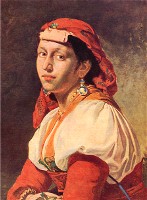
|
KOPYSTYNSKY, TEOFIL, b 15 April 1844 in Peremyshl, Galicia, d 5 July 1916 in Lviv. Monumentalist painter and portraitist. A graduate of the Cracow School of Fine Arts (1871) and the Vienna Academy of Art (1872), he spent his life painting churches, iconostases, and icons in Lviv and the surrounding villages. His more important works have been preserved: the murals of the wooden church in Batiatychi, the altar icon of the Transfiguration in the Church of the Transfiguration in Lviv, The Crucifixion (1902) in Saints Cyril and Methodius's Church in Sokolia near Busk, the murals (1911-12) of Saint Michael's Church in Rudnyky, and the iconostases in the churches in Zhovtantsi, Batiatychi, Zhydachiv, Myklashiv (1908), and Synevidsko Vyzhnie. He was also recognized as a restorer and conservator of old art. From 1878 to 1899 Kopystynsky restored a number of religious masterpieces. In 1888 he cleaned and restored 150 old Ukrainian icons at the Stauropegion Institute's museum in Lviv. Kopystynsky established a reputation as a master portraitist and from 1872 to 1895 he painted 17 portraits of prominent Ukrainian social and cultural figures of the 19th century, as well as Hetman Petro Konashevych-Sahaidachny and Metropolitan Petro Mohyla. Kopystynsky was also a leading book illustrator in Western Ukraine. He taught drawing in secondary schools in Lviv and participated in the exhibitions of the Society of Friends of the Fine Arts... |
| Teofil Kopystynsky |
The preparation, editing, and display of the IEU entries associated with the style of academism in 19th-century Ukrainian painting were made possible by the financial support of the CANADIAN FOUNDATION FOR UKRAINIAN STUDIES.
 X. THE TRADITION OF UKRAINIAN LANDSCAPE ART
X. THE TRADITION OF UKRAINIAN LANDSCAPE ART
In Ukrainian art conventionalized landscape elements were used in icons, while some of the earliest landscapes were settings for the 16th and 17th-century religious engravings. Landscape painting did not, however, become an independent genre in Ukrainian art until the 19th century. Romanticism inspired artists to record faithfully the pastoral scenery of thatched-roof cottages and the surrounding countryside. Among them were Ivan Soshenko, Taras Shevchenko, and Vasilii Shternberg. With time two types of landscape art developed, the poetic and the epic. Among the 19th-century artists who devoted much of their work to Ukrainian landscapes were two artists of non-Ukrainian origin, Ivan Aivazovsky, who is famous for his marine paintings, and Arkhyp Kuindzhi, who painted Romantic moonlit scenes. Other Ukrainian artists who devoted their efforts to landscape painting were Serhii Vasylkivsky, Ivan Pokhytonov, and Serhii Svitoslavsky. In the early 20th century Petro Levchenko painted intimate lyrical views in impressionist colors capturing the fleeting effects of light in both urban and rural scenes. Vasyl H. Krychevsky and Abram Manevich also worked in the impressionist manner. Symbolism was dominant in the fantasy landscapes of Yukhym Mykhailiv. In Western Ukraine Ivan Trush painted idyllic sunsets and panoramic views only slightly influenced by impressionist colors. In the 1930s, after socialist realism was imposed as the only sanctioned artistic method in the USSR, landscape painting was limited to views of collective farms and industrial sites. Pure landscape painting was revived in Ukraine only after the Second World War. Of the Ukrainian landscape artists who worked outside their homeland, the most prominent was Oleksa Hryshchenko, who achieved recognition in France for his landscapes and seascapes, painted mostly in an expressionist manner... Learn more about the tradition of Ukrainian landscape art by visiting the following entries:
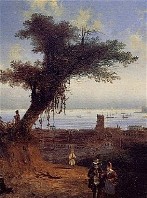
|
LANDSCAPE ART. The depiction of natural scenery. In Ukrainian art conventionalized landscapes and architectural settings became part of the scenes in icons illustrating the lives of saints. During the Renaissance landscapes in icons became less schematized and began looking more like the surrounding Ukrainian countryside. Architecture and local scenery were important elements in the icons of Ivan Rutkovych and Yov Kondzelevych. Landscapes also appeared as backgrounds to portraits. Some of the earliest landscapes were settings for religious engravings. At first they were variations on landscapes borrowed from Western European models, but later, local elements emerged. In 1669 Master Illia depicted the Dnieper River in his engraving. Similar engravings by Leontii Tarasevych showed an even greater preoccupation with local scenery. Depictions of churches and secular buildings appeared in the engraved theses produced in the 17th and 18th centuries by the Kyivan Cave Monastery Press. In the 18th century, landscapes gained greater prominence in religious pictures. Landscape painting become an independent genre in Ukrainian art in the 19th century... |
| Landscape art |
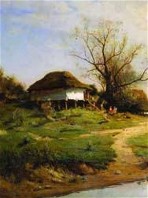
|
SVITOSLAVSKY, SERHII, b 6 October 1857 in Kyiv, d 19 September 1931 in Kyiv. Landscape painter. After studying at the Moscow School of Painting, Sculpture, and Architecture (1875-83) he returned to Kyiv. From 1884 he took part in the exhibitions of the Peredvizhniki society, and in 1891 he became a member of the society. During the Revolution of 1905 he contributed to the satirical magazine Shershen' and helped students expelled from the Kyiv Art School. His realist landscapes are noted for their vibrant colors. Some of his best-known works are Dnieper Rapids (1885), Oxen in the Field (1891), Street in a County Town (1895), On a River (1909), Ferry on the Dnieper (1913), Vicinity of Kiev: Winter, Windmill, and The Dnieper at Dusk. His travels in Central Asia in the late 1890s gave rise to a group of landscapes, including Steppe, Goat Herd in the Mountains, and Ships of the Desert (1900). After his eyesight deteriorated in the early 1920s, Svitoslavsky gave up painting. Albums of his works were published in Kyiv in 1955 and 1989... |
| Serhii Svitoslavsky |
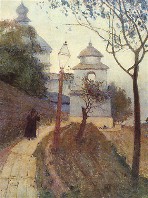
|
LEVCHENKO, PETRO, b 11 July 1856 in Kharkiv, d 27 January 1917 in Kharkiv. Painter and pedagogue. He studied art in Kharkiv under Dmytro Bezperchy, at the Saint Petersburg Academy of Arts (1878-83), and in Paris and Rome. From 1886 he lectured at the Kharkiv Painting School. He was a member of the Society of South Russian Artists and a participant in almost all of the exhibitions of the Peredvizhniki (1886-1904), and from 1900 his works displayed the influence of the impressionists. Levchenko did some 800 landscapes, primarily of Ukraine (such as A Deserted Place, Night: A Cottage in Moryntsi, A Ukrainian Village, In the Kharkiv Region, A Street in Putyvl, and The Yard of Saint Sophia Cathedral), but also painted abroad (such as A Street in Paris and Seacoast: Naples), as well as still lives and genre paintings. A posthumous retrospective exhibition of 700 of his paintings was held in Kharkiv in 1918. Monographs about him were written by M. Pavlenko (1927), Yu. Diuzhenko (1958), and M. Bezkhutry (1984)... |
| Petro Levchenko |
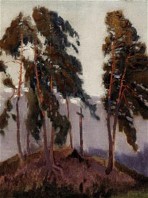
|
TRUSH, IVAN, b 17 January 1869 in Vysotske, Brody county, Galicia, d 22 March 1941 in Lviv. Painter, community figure, and art and literary critic; son-in-law of Mykhailo Drahomanov. After studying at the Cracow Academy of Fine Arts (1891-7) under Leon Wyczolkowski and Jan Stanislawski he lived in Lviv, where he was active in Ukrainian artistic circles and community life. A friend of Ivan Franko, he organized the Society for the Advancement of Ruthenian Art and the Society of Friends of Ukrainian Scholarship, Literature, and Art and their exhibitions; copublished the first Ukrainian art magazine, Artystychnyi vistnyk; painted many portraits for the Shevchenko Scientific Society; lectured on art and literature; and contributed articles to Literaturno-naukovyi vistnyk, Dilo, and Ukrainische Rundschau. He traveled widely: he visited Kyiv several times (he taught briefly at Mykola I. Murashko's Kyiv Drawing School in 1901), Crimea (1901-4), Italy (1902, 1908), and Egypt and Palestine (1912). Trush was an impressionist, noted for his original use of color. A major part of his large legacy (over 6,000 paintings) consists of landscapes... |
| Ivan Trush |
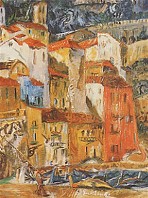
|
HRYSHCHENKO, OLEKSA, b 2 April 1883 in Krolevets, Chernihiv gubernia, d 28 January 1977 in Vence, France. Modernist painter, art scholar, and author. While specializing in biology at Kyiv University and Moscow University, he studied painting with Serhii Svitoslavsky in Kyiv and K. Yuon in Moscow. He became involved in the modernist art movement in Russia. During a brief stay in Paris in 1911 he met A. Lhote, Alexander Archipenko, and Le Fauconnier and became interested in cubism. From 1913 to 1914 he studied in Italy and wrote several studies of Italian primitive artists and the relation between the icon and Western art. During the Revolution of 1917, Hryshchenko became professor of the State Art Studios in Moscow and was offered the directorship of the Tretiakov Gallery, but he escaped from Russia via Crimea to Turkey. From 1919 to 1921 he lived in Istanbul, where he painted hundreds of watercolors. In 1921 he moved to France. In 1927 he settled in Cagnes in southern France. By this time he had changed his cubist style to a more dynamic expressionism, distinguished by cascades of exotic oriental colors... |
| Oleksa Hryshchenko |
The preparation, editing, and display of the IEU entries featuring the tradition of Ukrainian landscape art were made possible by the financial support of the CANADIAN FOUNDATION FOR UKRAINIAN STUDIES.
 XI. THE UKRAINIAN HISTORICAL PAINTING: FROM CLASSICISM TO REALISM
XI. THE UKRAINIAN HISTORICAL PAINTING: FROM CLASSICISM TO REALISM
Defined by its subject matter rather than artistic style, works of historical painting (understood in a specific, more narrow sense of this term) depict scenes from secular history, excluding religious, mythological or allegorical subjects. This type of paiting became increasingly popular in the late 18th century in France and England, and in the 19th century historical painting developed into a distinct genre throughout Europe. Within the context of Ukrainian art, Antin Losenko, a Cossack from Hlukhiv who spent most of his creative career in western Europe and in Saint Petersburg, was the first to introduce to Eastern Europe not only the genre of historical painting, but also the subject matter from the history of the Ukrainian lands: in 1770 he painted a celebrated painting of Grand Prince of Kyivan Rus' Volodymyr the Great and his wife Rohinda. In western Ukrainian lands, in the same year 1770 Luka Dolynsky painted an important historical depiction of the Halych ruler Lev Danylovych. However, the genre of historical painting fully developed in the Ukrainian context only in the second half of the 19th century. Taras Shevchenko included many historical subjects in his drawings and graphic works. But the most significant influence on the development of Ukrainian historical painting in Russian-ruled Ukraine was exerted by the legacy of Ukrainain-born Ilia Repin. Repin's realist historical paintings, and in particular his famous canvas The Zaporozhian Cossacks Write a Letter to the Turkish Sultan (1880-91), set the standard for younger Ukrainian painters to aspire to and considerably popularized the subject matter of Cossack history. As a professor of Saint Petersburg Academy of Arts, Repin also considerably influenced many of his Ukrainian students, including Mykola Pymonenko, Fotii Krasytsky, and Semen Prokhorov, as well as other Ukrainian painters at the Academy, such as Serhii Vasylkivsky. In Austrian-ruled western Ukraine the most important painter of historical canvases after Dolynsky was Kornylo Ustyianovych. But this genre of painting found its most accomplished master in western Ukraine in the early 20th century in the person of Mykola Ivasiuk whose canvas Khmelnytsky's Entry into Kyiv (1912) became particularly popular... Learn more about the Ukrainian historical painting from classicism to realism by visiting the following entries:
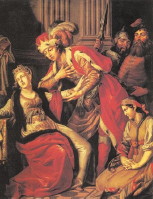
|
LOSENKO, ANTIN, b 10 August 1737 in Hlukhiv, Nizhyn regiment, d 4 December 1773 in Saint Petersburg. Painter; a leading exponent of historical painting in the classicist style. He studied in the Hlukhiv Singing School and was brought to Saint Petersburg to sing in the imperial court choir in the late 1740s. After his voice changed, he was sent to study art under Ivan Argunov (1753-8) and at the Saint Petersburg Academy of Arts (1758-60). Recognized for his exceptional talent, Losenko was promised a bursary to study in Paris where he arrived in 1760 and studied under Jean II Restout. In Paris Losenko painted his first masterpiece The Miraculous Draught of Fishes (1762). In 1766-9 Losenko studied in Rome where he became particularly interested in Rafael's paintings. After he was awarded several medals from the Paris Academy of Arts, Losenko's achievements were recognized in Saint Petersburg. He became a member of and professor at the Saint Petersburg Academy in 1770, served as its director (1772-3), and wrote its textbook on human proportions (1772). Losenko's oeuvre includes paintings on biblical and mythological themes; paintings on historical themes, such as The Holy Apostle Andrew (1769) and Grand Prince Volodymyr and Rohnida (1770); portraits of prominent personalities; a self-portrait; and approximately 200 drawings. Losenko introduced to the art of the Russian Empire the classicist pompier style of painting and was the first painter to depict in this style, in addition to the traditional mythological and biblical motifs, also themes from the history of Kyivan Rus' (in his painting of Grand Prince Volodymyr the Great and Rohinda)...
|
| Antin Losenko |
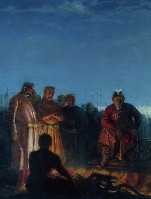
|
USTYIANOVYCH, KORNYLO, b 1839 in Vovkiv, Lviv district, Galicia, d 22 July 1903 in Dovhe, Stryi county, Galicia. Painter, writer, and journalist; founding member of the Shevchenko Society (1873). After studying at the Vienna Academy of Fine Arts (1858-63) he worked in Vienna and throughout Galicia and Bukovyna, where he painted icons for over 50 churches, 15 iconostases, 11 church murals, and 7 religious canvases. Among his 40 portraits are ones of Mykola Ustyianovych, Stepan Kachala, Yuliian Lavrivsky, and Anatol Vakhnianyn. He also did paintings on historical themes, such as Prince Vasylko of Terebovlia (1866), Shevchenko in Exile (1880), Nestor the Chronicler (1901), Yaroslavna's Lament, Cossack Battle (1890), and Hetman Ivan Mazepa at a Dnipro Crossing (1903); ethnographic paintings, such as Boiko Couple and Hutsul; and a few landscapes. His portrait drawings of Galician princes were printed in the journal Pryiatel' ditei (1881-3). Ustyianovych's works conform to the principles of academism but reveal a romantic bent. Ustyianovych's first poems were written in yazychiie and published in 1861. During his studies in Vienna he evolved from a Pan-Slavist into a Ukrainian populist. From 1872 he contributed articles, humorous feuilletons, accounts of his travels, and several stories in the Ukrainian vernacular to Galician periodicals. He worked as a scenery designer for the Ruska Besida Theater in Lviv, and his tragedies Iaropolk Sviatoslavych (1877) and Oleh Sviatoslavych (1876) were performed there (1878, 1883)... |
| Kornylo Ustyianovych |
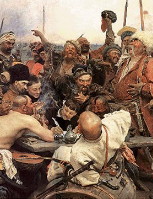
|
REPIN, ILIA, b 5 August 1844 in Chuhuiv, Zmiiv county, Kharkiv gubernia, d 29 September 1930 in Kuokkala, Finland. Painter; full member of the Saint Petersburg Academy of Arts from 1893. He studied in Saint Petersburg under Ivan Kramskoi (1863-4) and then at the Academy of Arts (1864-71), which granted him a scholarship to study in Italy and France (1873-6). For many years he lived in Saint Petersburg and served as a professor (1894-1907) at and the rector (1898-9) of the Academy of Arts, where his students included the Ukrainian painters Mykola Pymonenko, Oleksander Murashko, Fotii Krasytsky, and Semen Prokhorov. From 1900 Repin lived in Kuokkala in Finland. A good part of his work consists of genre paintings. Some of the works show his attachment to Ukraine, its people, and its history, among them the famous painting The Zaporozhian Cossacks Write a Letter to the Turkish Sultan (1880-91), Evening Party (1881), Haidamakas (1898-1917), Black Sea Freebooters (1908), and Hopak (1926-30, unfinished). He painted many portraits of Russian and Ukrainian cultural figures, including Mykola I. Murashko, Arkhyp Kuindzhi, Mykola Kostomarov, Ivan Kramskoi, Vasyl V. Tarnovsky, Taras Shevchenko, and Dmytro Bahalii; did illustrations for editions of the works of Nikolai Gogol (Mykola Hohol) and for his friend Dmytro Yavornytsky's book on Zaporozhian Sich; and painted and sketched many Ukrainian landscapes and inhabitants. Although Repin was a realist, his rich colors and restless lines often produce an almost expressionistic effect. Some of his paintings show the influence of impressionism and symbolism... |
| Ilia Repin |
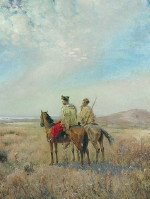
|
VASYLKIVSKY, SERHII, b 19 October 1854 in Izium, Kharkiv gubernia, d 7 October 1917 in Kharkiv. Painter and art scholar. He studied at the Saint Petersburg Academy of Arts (1876-85) and in France (1886-8). He also painted in Italy, Spain, northern Africa, and Britain. After settling in Kharkiv in 1888, he was active in Ukrainian artistic circles and headed the architectural and art society there. He produced over 3,000 realist and impressionist works, but many of them perished in museum fires during the Second World War. They include a few portraits; historical paintings, such as Zaporozhian Skirmish with Tatars (1892), Cossacks in the Steppe (1915), and Cossack Campaign (1917); genre paintings, and many landscapes, such as Cossack Meadow (1893), Dnipro Floodplains (1896), and Along the Donets (1901). In 1901-8 Vasylkivsky painted murals and ornamental wall panels for the Poltava Zemstvo Building, which perished in the Second World War; they included The Chumak Romodan Route, The Cossack Holota, and The Election of Colonel Martyn Pushkar. He copublished, with Mykola Samokysh, an album of Ukrainian folk ornamental motifs (1912), for which he painted over 100 designs, and an album on Ukrainian antiquity (1900, text by Dmytro Yavornytsky), for which he did 27 historical portraits... |
| Serhii Vasylkivsky |
_s.jpg)
|
SLASTION, OPANAS, b 14 January 1855 in Berdiansk, Tavriia gubernia, d 24 September 1933 in Myrhorod, Poltava okruha. Painter, illustrator, architect, art scholar, ethnographer, and kobzar. After graduating from the Saint Petersburg Academy of Arts (1882) he worked as an artist for the Ministry of Defense in Saint Petersburg (1887-1900), where he was able to study materials on the Ukrainian Cossacks, and presided over the Ukrainian Club in the capital (1897-1900). In 1883-5 he did 55 pen drawings for the 1886 Saint Petersburg edition of Taras Shevchenko's epic poem 'Haidamaky.' His painted genre scenes, landscapes, and historical paintings. From 1900 to 1928 he taught at the Myrhorod Arts and Crafts School and created illustrations for more of Shevchenko's poems. For many years Slastion wandered about Ukraine, painting landscapes, drawing architectural monuments, collecting folklore and folk art, and writing down the folk songs and historic songs performed by kobzars. He became a skilled performer of Cossack dumas on the bandura. His gallery of kobzars in Left-Bank Ukraine, drawn from 1875 to 1928, was not published until 1961. From the ethnographic materials Slastion collected he prepared albums on Ukrainian and Zaporozhian antiquities, folk dress, folk ornaments, embroidery, wood carvings, ceramics, and architecture. In 1910–13 he designed dozens of village public buildings in the Ukrainian 'folk style' of architecture... |
| Opanas Slastion |
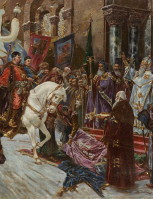
|
IVASIUK, MYKOLA, b 28 April 1865 in Zastavna, Bukovyna, d 25 November 1937 in Kyiv. Realist painter. A student of the Vienna (1884-9) and Munich (1890-6) art academies, he organized the first Ukrainian art school in Chernivtsi (1899-1908), then worked in Lviv, Vienna, and Prague. His most important works deal with historical themes: Khmelnytsky at Zboriv (1893), The Battle of Khotyn (1903), Khmelnytsky's Entry into Kyiv (1912), and Bohun at Berestechko (1919). His painting Khmelnytsky's Entry into Kyiv became particularly popular in Western Ukraine and thousands of color reproductions of it were printed. He also painted a large number of genre scenes and portraits (of Olha Kobylianska, Yurii Fedkovych, Ivan Franko, Taras Shevchenko, Oleksander Myshuha, and self-portraits). Ivasiuk is a representative of the academic style of the Vienna-Munich school at the end of the 19th century. Themes from the Ukrainian Cossack period, which is prominent in Ivasiuk's work, was popular at the time in Polish and Russian painting. In 1925 he accepted an invitation to teach at the Kyiv State Art Institute and moved to Soviet Ukraine. After working for several years in Kyiv, he was arrested in November 1937 by the NKVD on the wave of the Yezhov terror and executed... |
| Mykola Ivasiuk |
The preparation, editing, and display of the IEU entries about the Ukrainian historical painting from classicism to realism were made possible by the financial support of the CANADIAN FOUNDATION FOR UKRAINIAN STUDIES.
 XII. THE UKRAINIAN REALIST GENRE PAINTING
XII. THE UKRAINIAN REALIST GENRE PAINTING
Paintings depicting scenes from everyday life on the Ukrainian territories are already found in Scythian art and in the frescoes of Saint Sophia Cathedral in Kyiv (11th century). By definition, however, genre painting is associated with European easel painting, which dates back to the late Middle Ages in the West and the 18th century in Ukraine. In the late 19th century, with the rise of the Peredvizhniki society of painters who opposed the dogmatic imitation of classical art forms promoted by Saint Petersburg Academy of Arts, genre painting came to enjoy great popularity in the Russian Empire, including Ukraine. Depicting primarily scenes from village life, the Ukrainian representatives of the Peredvizhniki, such as Kyriak Kostandi, Ilia Repin, or Mykola Pymonenko, worked in realist and naturalist styles and were more concerned with realistic portrayals than with stylistic innovation. Many other Ukrainian artists were influenced by their ideas and painted strictly realistic genre scenes, including historical scenes from the daily life of the Cossacks. As a result of their representatives' primary focus on the subject matter of their paintings, in the wake of formalist experimentation in the early 20th century, originally radical in nature, the Peredvizhniki society became a bastion of conservatism and opposed modernist trends in Ukrainian art. The naturalist styles advocated by its members were later used as the basis of Soviet socialist realism... Learn more about the Ukrainian realist genre painting by visiting the following entries:
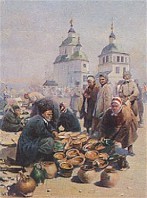
|
GENRE PAINTING. A style of painting characterized by the depiction of scenes from everyday life. Ukrainian genre painting usually depicts village life. Early examples of genre painting in Ukraine include certain works by Vasilii Shternberg, Ivan Soshenko, and Taras Shevchenko. In the late 19th century, the Ukrainian representatives of the Peredvizhniki society of painters, such as Kostiantyn Trutovsky, Ilia Repin, Mykola Bodarevsky, and Mykola Pymonenko were among the more prominent genre painters. Later works depicting everyday life were painted by, among others, Porfyrii Martynovych, Ivan Izhakevych, Fotii Krasytsky, Fedir Krychevsky, Oleksander Murashko, and Anatol Petrytsky, some of whom were associated with the Peredvizhniki, and by the Western Ukrainians such as Olena Kulchytska, Ivan Trush, Mykola Ivasiuk, and Yosyp Bokshai. In the first half of the 20th century, with the influence of Western experimentalism, genre painting declined, particularly in Western Ukraine, and often appeared simply as a pretext to formal stylization, especially in graphic art. In Soviet Ukraine in the 1930s, in addition to village life, industrial themes also became popular subjects for genre painting... |
| Genre Painting |
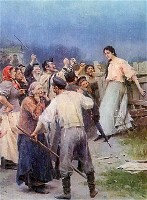
|
PEREDVIZHNIKI. A name applied to members of the Russian Society of Itinerant Art Exhibitions. It was founded in 1870 by Ivan Kramskoi, Mykola Ge, and 13 other artists who had left the Saint Petersburg Academy of Arts in protest against its rigid neoclassical dicta. In order to reach the widest audience possible, the society organized regular traveling exhibitions throughout the Russian Empire, including Kyiv, Kharkiv, and Odesa in their tours. Over the years the society attracted artists from various parts of Russia, Belarus, and Ukraine. Among the Ukrainians who joined it were Kyriak Kostandi, Arkhyp Kuindzhi, Mykola Kuznetsov, Oleksander Murashko, Leonid Pozen, Mykola Pymonenko, Petro Nilus, Ilia Repin, Serhii Svitoslavsky, and Mykola Yaroshenko. The Peredvizhniki worked in realist and naturalist styles and concentrated on landscape art, portraiture, and genre painting. In Southern Ukraine, the Society of South Russian Artists, established in Odesa in 1890, was closely associated with the Peredvizhniki. Among its founders were Kyriak Kostandi (its president from 1902 to 1921), Mykola Kuznetsov, Gennadii Ladyzhensky, and Mykola Skadovsky... |
| Peredvizhniki |
_s.jpg)
|
TRUTOVSKY, KOSTIANTYN, b 9 February 1826 in Kursk, d 29 March 1893 in Yakovlevka, Kursk gubernia. Ukrainian painter and graphic artist. He was raised on his family's estate in Popivka, Okhtyrka county, Kharkiv gubernia. He audited classes at the Saint Petersburg Academy of Arts (1845-9) and in 1860 was elected a member of the academy. Having adopted the prevailing realist style of academism, he specialized in genre paintings depicting life in Kursk gubernia and Ukraine. They included a number of paintings of folk customs in Ukraine. Trutovsky also did hundreds of pencil drawings and illustrations, including illustrations to the Ukrainian stories of Nikolai Gogol and Marko Vovchok as well as Taras Shevchenko's poems 'Haidamaky' (Haidamakas, 1886), 'Naimychka' (The Hired Girl), and 'Nevol'nyk' (The Captive, 1887). Most of his works were within the framework of the ethnographic sentimental style fashionable at the time; some, however, touched on painful social problems. Trutovsky influenced younger painters, such as Serhii Vasylkivsky, Ivan Izhakevych, Mykola Pymonenko, and Opanas Slastion... |
| Kostiantyn Trutovsky |
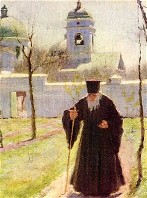
|
KOSTANDI, KYRIAK, b 3 October 1852 in Dofinivka, Odesa county, Kherson gubernia, d 31 October 1921 in Odesa. Realist painter and art scholar. After graduating from the Odesa Drawing School (1874) and the Saint Petersburg Academy of Arts (1882), he returned to Odesa, where he painted and taught at the drawing school. In 1897 he joined the Peredvizhniki and began to take part in their exhibitions. Having helped found the Society of South Russian Artists, he served from 1902 to 1920 as its president. In 1907 he was elected full member of the Saint Petersburg Academy of Arts. From 1917 he served as director of the Odesa City Museum. Adhering to a strictly realist style, Kostandi devoted himself to genre painting, but did some landscape painting and portrait painting as well. His works include At a Friend's Sickbed (1884), Geese (1888), Early Spring (1892), Little Bright Cloud (1906), and Little Blue Cloud (1908). After his death, his style and ideas became leading principles for a group of his followers gathered in the Kostandi Society of Artists... |
| Kyriak Kostandi |
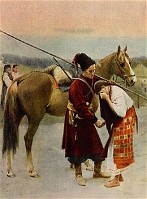
|
PYMONENKO, MYKOLA, b 9 March 1862 in Priorka (a suburb of Kyiv), d 26 March 1912 in Kyiv. Prominent Ukrainian realist painter; full member of the Saint Petersburg Academy of Arts from 1904. After studying at the Kyiv Drawing School (1878-82) and the Saint Petersburg Academy of Arts (1882-4) he taught at the Kyiv Drawing School (1884-1900) and Kyiv Art School (1900-6). He took part in the exhibitions of the Society of South Russian Artists (1891-6) and Peredvizhniki society (from 1893) and became a member of the latter society in 1899. In 1909 he was elected a member of the Paris International Association of Arts and Literatures. Pymonenko produced over 700 genre scenes, landscapes, and portraits, many of which were reproduced as postcards. Pymonenko also created illustrations for several of Taras Shevchenko's narrative poems, and in the 1890s he took part in painting the murals in Saint Volodymyr's Cathedral in Kyiv. Books about him have been written by Yakiv Zatenatsky (1955) and P. Hovdia (1957), and an album of his works was published in Kyiv in 1983... |
| Mykola Pymonenko |
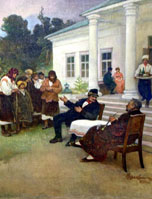
|
IZHAKEVYCH, IVAN, b 18 January 1864 in Vyshnopil, Uman county, Kyiv gubernia, d 19 January 1962 in Kyiv. Realist painter and graphic artist, one of the most popular artists in Ukraine of his time. He studied art at the Kyivan Cave Monastery Icon Painting Studio (1876-82), the Kyiv Drawing School (1882-4), and the Saint Petersburg Academy of Arts (1884-8). In 1883-4 he took part in the restoration of the 12th-century frescoes in Saint Cyril's Church in Kyiv, and later painted the refectory and the All-Saints Church of the Kyivan Cave Monastery. He executed numerous landscapes, genre scenes, and paintings on historical themes. A prolific illustrator, he worked for Russian journals at the time when Ukrainian ones were forbidden, and often referred to Ukrainian themes. He did easel paintings on themes from Shevchenko's poetry and a series of illustrations and the cover for the jubilee edition of Kobzar (The Minstrel, 1940). Izhakevych also illustrated the works of Lesia Ukrainka, Nikolai Gogol, Mykhailo Kotsiubynsky, Ivan Franko, Vasyl Stefanyk, and others. By style he belongs to the Populist School of the second half of the 19th century... |
| Ivan Izhakevych |
The preparation, editing, and display of the IEU entries associated with the Ukrainian genre painting were made possible by the financial support of the CANADIAN FOUNDATION FOR UKRAINIAN STUDIES.
 XIII. THE UKRAINIAN IMPRESSIONIST PAINTERS
XIII. THE UKRAINIAN IMPRESSIONIST PAINTERS
An important movement in painting that arose in France in the late 1860s and is linked with artists such as Claude Monet, Camille Pissarro, August Renoir, and Alfred Sisley, impressionism had a strong influence on Ukrainian painting. The first Ukrainian impressionists appeared at the end of the 19th century and were graduates of the Cracow Academy of Fine Arts. Impressionism remained a major trend in Ukrainian painting until the early 1930s and it gave rise to Neo-impressionism, which attempted to base painting on scientific theory; Postimpressionism, which cultivated the esthetics of color; and Pointillism, which broke down colors into their elementary hues and distributed them in mosaic-like patterns... Learn more about the influence of the impressionist movement on Ukrainian art and the major representatives of this style in Ukraine by visiting the following entries:
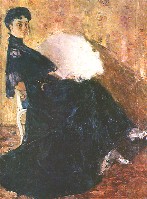
|
IMPRESSIONISM. The original French impressionist painters sought to capture with short strokes of unmixed pigment the play of sunlight on objects. The name of the movement was derived from Claude Monet's Impressions: Sunrise (1872). Oleksa Novakivsky, who later embraced symbolic expressionism, was one of the first Ukrainian impressionists. Ivan Trush, who preferred to work with grayed colors, adopted impressionism only partly. Mykola Burachek captured the sunbathed colors of the Ukrainian steppe, while Mykhailo Zhuk and Ivan Severyn introduced decorative elements into their impressionist works. Other leading exponents of Ukrainian impressionism were Oleksander Murashko, Vasyl Krychevsky, Petro Kholodny (landscapes and portraits), Mykola Hlushchenko, and Oleksii Shovkunenko... |
| Impressionism |
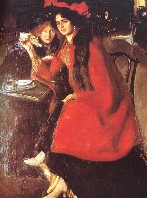
|
OLEKSANDER MURASHKO, b 7 September 1875 in Kyiv, d 14 June 1919 in Kyiv. Painter. He studied at the Kyiv Drawing School (1891-4), under Ilia Repin at the Saint Petersburg Academy of Arts (1894-1900), and in Munich and Paris (1902–4). In 1907 he settled in Kyiv, where he taught painting at the Kyiv Art School and at his own studio. In 1909 he exhibited his canvases in Paris, Munich, and Amsterdam, and in 1910 at the international exhibition in Venice and at one-man shows in Berlin, Koln, and Dusseldorf. From 1911 he exhibited with the Munich Sezession group. In 1916 he joined the Peredvizhniki society and became a founding member of the Kyiv Society of Artists. He was a cofounder of the Ukrainian State Academy of Arts in 1917 and served there as a professor and rector. Murashko's style evolved from the realism of the Peredvizhniki school into a vivid, colorful impressionism... |
| Oleksander Murashko |
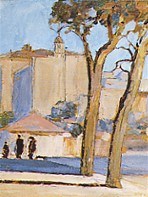
|
KRYCHEVSKY, VASYL, b 12 January 1873 in Vorozhba, Lebedyn county, Kharkiv gubernia, d 15 November 1952 in Caracas, Venezuela. Outstanding art scholar, architect, painter, graphic artist, set designer, and a master of applied and decorative art. Working as an independent architect and artist, he achieved a national reputation by the time of the outbreak of the First World War. During the revolutionary period he was a founder and the first president of the Ukrainian State Academy of Arts. After the war he lived briefly in Paris before immigrating in 1947 to South America. As a painter Krychevsky was deeply influenced by French impressionism. The pure and harmonious colors of his south-Ukrainian landscapes or Kyiv cityscapes (done in oils and watercolors) convey a lyrical atmosphere... |
| Vasyl Krychevsky |
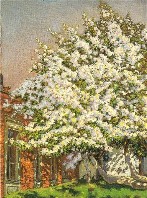
|
BURACHEK, MYKOLA, b 16 March 1871 in Letychiv, Podilia gubernia, d 12 August 1942 in Kharkiv. Impressionist painter and pedagogue. Burachek studied in Kyiv and graduated from the Cracow Academy of Fine Arts in 1910. His first exhibit was held in 1907. In 1910-12 he worked in the studio of Henri Matisse in Paris. In 1917-22 he served as professor at the Ukrainian State Academy of Arts in Kyiv and then at the Kyiv State Art Institute and the Lysenko Music and Drama School in Kyiv. From 1925 to 1934 he was rector of the Kharkiv Art Institute and then returned to the Kyiv State Art Institute. A master landscape painter, he rendered Ukrainian landscapes in a colorful, impressionist style... |
| Mykola Burachek |
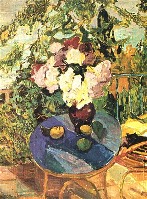
|
HLUSHCHENKO, MYKOLA, b 17 September 1901 in Novomoskovske, Katerynoslav gubernia, d 31 October 1977 in Kyiv. Artist. A graduate of the Academy of Art in Berlin (1924), from 1925 he worked in Paris where he immediately attracted the attention of French critics. From the Neue Sachlichkeit style of his Berlin period he changed to postimpressionism. Besides numerous French, Italian, Dutch, and (later) Ukrainian landscapes, he also painted flowers, still life, nudes, and portraits. At the beginning of the 1930s, Hlushchenko belonged to the Association of Independent Ukrainian Artists and helped organize its large exhibition of Ukrainian, French, and Italian paintings at the National Museum in Lviv. In 1936 he moved to the USSR, but was allowed to live in Ukraine only after the war... |
| Mykola Hlushchenko |
The preparation, editing, and display of the IEU entries associated with the Ukrainian impressionist painters were made possible by the financial support of the CANADIAN FOUNDATION FOR UKRAINIAN STUDIES.
 XIV. MYKHAILO BOICHUK AND HIS SCHOOL OF UKRAINIAN MONUMENTAL ART
XIV. MYKHAILO BOICHUK AND HIS SCHOOL OF UKRAINIAN MONUMENTAL ART
Art critics, including Guillaume Apollinaire, first took notice of Mykhailo Boichuk's art in 1910 in Paris, when he participated in exhibitions of the Salon d'Automne, and, together with his students, held an exhibition at the Salon des Independants on the theme of the revival of Byzantine art. Having witnessed the birth of modern art in Paris, Boichuk attempted to blend it with his native tradition, developing a style of simplified monumental forms inspired by traditional Byzantine and Ukrainian icon, the Italian Renaissance painting of the Quattrocento period, and the Ukrainian folk art. This style, having won high critical acclaim, became known as Boichukism. In the 1920s, its followers made up a dominant part of the membership of Association of Revolutionary Art of Ukraine, which developed a unique and powerful school of Ukrainian monumental art. However, Boichukism was often attacked by official Soviet critics for 'formalism,' 'bourgeois nationalism,' and focusing on the countryside. During the Salinist terror, Boichuk and his most prominent students and collaborators, Vasyl Sedliar, Ivan Padalka, Sofiia Nalepinska-Boichuk, and Mykola Kasperovych, were arrested by the NKVD and executed. Categorized as the 'bourgeois-nationalist art,' most of Boichuk's and his students' frescoes and paintings were destroyed by the Soviet authorities... Learn more about Mykhailo Boichuk and his school of Ukrainian monumental art by visiting the following entries:
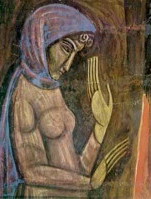
|
BOICHUK, MYKHAILO, b 30 October 1882 in Romanivka, Ternopil county, d 13 July 1937 in Kyiv. Influential Ukrainian modernist painter, graphic artist, and teacher. Boichuk studied at Yuliian Pankevych's art studio in Lviv (1898), a private art school in Vienna (1899), and the Cracow Academy of Arts (1899-1905). He continued his studies in Munich, Vienna, and Paris. In 1909 he founded his own studio-school in Paris, at which his future wife Sofiia Nalepinska, Mykola Kasperovych, and other painters studied. After the Revolution of 1917 Boichuk lived in Kyiv. There he became a founding professor of the Ukrainian State Academy of Arts, taught monumental art at the academy, and was briefly its rector. In 1925 he was one of the founders of the Association of Revolutionary Art of Ukraine. Boichuk formed a school of monumental painting, which continued to develop in Ukraine into the 1930s. Arrested by the NKVD in November 1936 on the charge of being an 'agent of the Vatican,' he was executed together with his students Ivan Padalka and Vasyl Sedliar... |
| Mykhailo Boichuk |
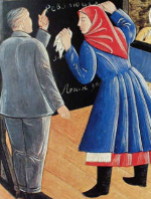
|
SEDLIAR, VASYL, b 12 April 1899 in Zhorzhivka, Poltava gubernia, d 13 July 1937 in Kyiv. Painter and graphic artist. Sedliar studied at the Kyiv Art School (1915-19) and then at the Ukrainian State Academy of Arts under Mykhailo Boichuk. He worked on large-scale murals, illustrated books, designed packaging, and produced ceramic works. Together with Oksana Pavlenko and other painters, he executed murals on the walls of auditoriums of the Kyiv Institute of Plastic Arts (1924) and at the Mezhyhiria Ceramics Tekhnikum (1924). Sedliar was the director of the Mezhyhiria Art and Ceramics Tekhnikum (1923-30). He was one of the founders of the Association of Revolutionary Art of Ukraine. As art critic, Sedliar opposed the official Soviet theory that argued the crucial influence of Russian realist painting on the development of Ukrainian art. He was arrested by the NKVD in November 1936, charged with terrorist activity and later executed together with Boichuk and Ivan Padalka. The majority of his works, including thousands of paintings, were destroyed... |
| Vasyl Sedliar |
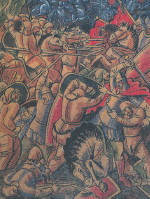
|
PADALKA, IVAN, b 27 October 1894 in Zhornoklovy, Zolotonosha county, Poltava gubernia, d 13 July 1937 in Kyiv. Painter, muralist, and graphic artist. He studied at the Kyiv Art School (1913-17) and under Mykhailo Boichuk and Vasyl H. Krychevsky at the Ukrainian State Academy of Arts (1917-20). A member of the Association of Revolutionary Art of Ukraine in the 1920s, he taught at the Myrhorod (1920-1) and Mezhyhiria (1921-5) ceramics tekhnikums, the Kharkiv Art Institute (1925-34), and the Kyiv State Art Institute (1934-6). Under M. Boichuk's direction, in 1919, he took part in creating the 14 murals at the Lutsk regimental army barracks in Kyiv and, in 1933-5, the fresco 'Rest' at the Kharkiv Chervonozavodskyi Ukrainian Drama Theater. He also did woodcuts, portraits of Petro Panch and Oksana Pavlenko, and numerous genre paintings. His paintings and prints were influenced by the icon and lubok pictures traditions. One of the leading representatives of Boichukism, Padalka was arrested by the NKVD in September 1936 and later executed... |
| Ivan Padalka |
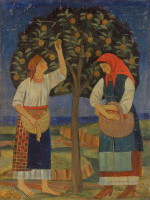
|
BOICHUK, TYMOFII, b 27 September 1896 in Romanivka, Ternopil county, d 1922 in Kyiv. Modernist painter and graphic designer. In 1914 he left his village to live with his much older and more famous brother, Mykhailo Boichuk, and to work with him and Mykola Kasperovych on the restoration of the iconostasis in the Church of the Holy Trinity in Lemeshi, Chernihiv region. After the February Revolution of 1917 the two brothers lived in Kyiv. There Tymofii studied at the Ukrainian State Academy of Arts and his brother's monumental-painting workshop (1917-22), and participated in the painting of frescoes in the Lutsk regimental army barracks in Kyiv (1919). Under his brother's supervision he created large-scale paintings in the Kyiv Theatre of Opera and Ballet for the First Congress of Regional Executive Committees (1919). His other paintings include Two Women Selling Seeds (1916), and, in 1919-20, Planting Potatoes, In the Pasture (now at the Tretiakov Gallery in Moscow), and In the Cobbler's Shop. Boichuk died of tuberculosis... |
| Tymofii Boichuk |
_s.jpg)
|
PAVLENKO, OKSANA, b 12 February 1895 in Valiava, Cherkasy county, Kyiv gubernia, d 21 April 1991 in Moscow. Painter. In 1914 she began her studies at the Kyiv Art School under Fotii Krasytsky and Fedir Krychevsky. In 1917 she enrolled in the Ukrainian State Academy of Arts and studied under Mykhailo Boichuk. She continued her studies in Boichuk's Workshop of Monumental Painting at the Kyiv Institute of Plastic Arts (1918-22). In 1919 she was part of Boichuk's team that decorated the Lutsk regimental army barracks in Kyiv (destroyed in 1922). She also took part in the experimental fresco painting on the walls of auditoriums of the Kyiv Institute of Plastic Arts (these frescos were destroyed in 1934). While teaching painting, drawing, and ceramics at the Mezhyhiria Tekhnikum (1923-9) she painted frescoes there. In 1929 she moved to Moscow where she taught in the ceramics faculty of the Moscow Higher State Artistic and Technical Institute (1929-31) and, later, in several other schools. Her memoirs about Mykhailo Boichuk were published in 1987... |
| Oksana Pavlenko |
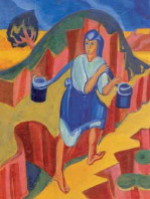
|
SAHAIDACHNY, YEVHEN, b 22 June 1886 in Kherson, d 21 August 1961 in Kosiv, Ivano-Frankivsk oblast. Painter, scenery designer, and teacher. He was educated in Saint Petersburg where he belonged to several avant-garde art goups. In 1911 he traveled to Lviv to work with Mykhailo Boichuk who had a powerful influence on Sahaidachny's development as an artist. Upon his return to Russia in 1912, Sahaidachny exhibited his paintings with the group of leftists avant-garde painters and worked as a designer for Saint Petersburg theaters. He continued to work on stage design in Kyiv after moving to the city in 1917. In 1917 he became a member of the Ukrainian State Academy of Arts, and from 1922 he lectured at the Kyiv State Art Institute, the Mezhyhiria Ceramics Tekhnikum, and several other institutions. He was a member of the Association of Revolutionary Art of Ukraine. After the Second World War Sahaidachny moved to Chernivtsi and, in 1947, to Kosiv where he taught at the Kosiv School of Applied Art... |
| Yevhen Sahaidachny |
The preparation, editing, and display of the IEU entries associated with Mykhailo Boichuk and his school of Ukrainian monumental art were made possible by the financial support of the CANADIAN FOUNDATION FOR UKRAINIAN STUDIES.
 XV. UKRAINIAN AVANT-GARDE ARTISTS OF THE EARLY 20TH CENTURY
XV. UKRAINIAN AVANT-GARDE ARTISTS OF THE EARLY 20TH CENTURY
The early 20th-century avant-garde movement had a direct impact on Ukrainian painting. Artists born in Ukraine, as well as those who considered themselves Ukrainian by nationality, were in its vanguard and they strongly influenced the development of such avant-garde artistic trends as futurism, cubo-futurism, suprematism, and constructivism. The most prominent of them were Kazimir Malevich (the founder of suprematism), David Burliuk and Vladimir Burliuk (the founders of futurism in the Russian Empire), Alexandra Ekster (whose innovative stage and costume designs gained international renown), Oleksander Bohomazov (a master cubo-futurist), and Vladimir Tatlin (one of the founders of constructivism). The first exhibition of the new art in Ukraine (and in the Russian Empire as well) was organized in Kyiv in 1908 by Davyd and Vladimir Burliuk, Alexandra Ekster, and Oleksander Bohomazov. During the 1910s artists from Ukraine played a crucial role in the development of avant-garde artistic trends in Russia. At the same time, they had close contacts with Western avant-garde artists, particularly in France (Paris) and Germany. In fact, a group of artists from Ukraine who resided in Paris and/or Berlin, such as Alexander Archipenko, Vladimir Baranoff-Rossine, Sonia Delaunay-Terk, and Mykhailo Andriienko-Nechytailo, had a considerable impact on the evolution of the avant-garde art in Western Europe. During the relatively liberal period of the 1920s in Soviet Ukraine, a variety of styles flourished and avant-garde art was taught at Ukrainian art schools, particularly at the Kyiv State Art Institute. Cubo-futurist and constructovist art works were produced in Kyiv, Kharkiv, and other cities by such younger artists as Vasyl Yermilov, Vadym Meller, Viktor Palmov, and Anatol Petrytsky. However, in the 1930s all avant-garde activities in Soviet Ukraine came to a halt with the introduction of socialist realism as the only literary and artistic method permitted by the communist regime... Learn more about the early 20th-century Ukrainian avant-garde artists by visiting the following entries:
_s.jpg)
|
EKSTER, ALEXANDRA (also Exter; nee Grigorovich), b 6 January 1882 in Bialystok, Hrodna gubernia, d 17 March 1949 in Fontenay-aux-Roses near Paris, France. Avant-garde painter and theatrical set designer and costume designer working within the currents of cubism, cubo-futurism, suprematism, and constructivism. In 1906 she graduated from Kiev Art School where she studied under Mykola Pymonenko together with, among others, Oleksander Bohomazov and Alexander Archipenko. From 1908 to 1924 she intermittently lived in Kyiv, Saint Petersburg, Odesa, Paris, Rome, and Moscow, but she played a particularly important role on the Kyiv art scene. Her painting studio grouped Kyiv's artistic and intellectual elite. In Paris, Ekster was a personal friend of Pablo Picasso, Georges Braque, and Gertrude Stein. In 1914, she participated in the Salon des Independants exhibitions together with Kazimir Malevich, Alexander Archipenko, Vadym Meller, Sonia Delaunay-Terk and other artists. Exter's early paintings featured elements of cubism, futurism (cubo-futurism), and the Art Deco movement. Later her set designs featured elements of constructivism. In general, her art absorbed influences from a variety of sources and cultures. She was particularly fascinated, however, with the Ukrainian folk art and in 1915-6 she organized the peasant craft cooperatives in the villages Skoptsi and Verbivka which produced, among others, kilims based on Kazimir Malevich's suprematist designs. Ekster brought the colourful palette of the Ukrainian folk art into thus far monochromatic cubist paintings. Proclaiming a close affinity between the avant-garde and folk art, Ekster exhibited her works together with a Ukrainian naive artist Hanna Sobachko-Shostak and other folk painters... |
| Alexandra Ekster |
_s.jpg)
|
BOHOMAZOV, OLEKSANDER, b 7 April 1880 in Yampil, Kharkiv gubernia, d 3 June 1930 in Kyiv. Painter. Having completed a zemstvo agricultural school in Kherson, Bohomazov entered the Kyiv Art School, where he studied under Oleksander Murashko and graduated in 1911. Among his classmates were such prominent figures as Alexander Archipenko, Alexandra Ekster, and Abram Manevich. Having begun painting under the influence of symbolism and art moderne, in 1908, together with Ekster, Davyd Burliuk, and other artists, Bohomazov took part in the exhibition Zveno (Link). In 1914 he co-organized an avant-garde artistic group Kiltse (Circle) in Kyiv and exhibited 88 of his paintings at the group's exhibition that year. His work attracted particular attention of art critics and he earned for himself the name of 'a Ukrainian Picasso.' Most notable were his works in the new style of cubo-futurism (such as The Tram, 1914), which combined the carefully structured architectonics of cubism with the dynamic chaos of futurism that undermined any attempt at traditional composition. In 1914 Bohomazov also wrote an unpublished avant-garde treatise, 'Painting and the Elements,' in which he anticipated many ideas later expressed by the abstractionists Vasilii Kandinsky and Kazimir Malevich. During the late 1910s, together with Alexandra Ekster, Bohomazov organized avant-garde street paintings and performances. In the 1920s he was a member of the Association of Revolutionary Art of Ukraine and worked as an instructor at the Kyiv State Art Institute from 1922 to 1930. In the late 1920s, Bohomazov painted scenes of people's everyday life and work, executed in brilliant vivid colors (eg, Sawyers, 1927)...
|
| Oleksander Bohomazov |
_s.jpg)
|
BURLIUK, DAVYD, b 22 July 1882 in Semyrotivka, Kharkiv gubernia, d 15 January 1967 in Long Island, NY. Painter and poet, founder of futurism in the Russian Empire. He studied at the Odesa and Kazan Art Schools, Munich Royal Academy of Arts (1902-3), and at the Ecole des Beaux-Arts in Paris. He began painting in 1904. Between 1907 and 1913 he lived in Chornianka near Kherson where his father supervised an estate which was visited by many noted artists and writers, such as W. Kandinsky, V. Maiakovsky, V. Kamensky, V. Izdebsky, A. Lentulov, M. Larionov, B. Livshitz, A. Kruchenykh, and V. Khlebnikov. It was here that an avant-garde group coalesced, first calling themselves Hylaea (after the Greek name for Scythian lands at the mouth of the Dnieper River) and then futurists. Burliuk was involved in planning and organizing all of their early exhibitions. Together with Alexandra Ekster and Oleksander Bohomazov, he organized the Link exhibition in Kyiv in 1908, and then several avant-garde exhibitions in Saint Petersburg, Moscow, Odesa, and Mykolaiv that announced the arrival of avant-garde art within the Russian Empire. During the Revolution of 1917 and civil war he traveled through Siberia, lived in Vladivostok and Japan, then moved to the United States, where he lived in New York (1922-41) and Hampton Bays (1941-67). As a painter he experimented with a number of styles, but his cult of energy and vitality, and his connection to nature remained constant. Burliuk, who was descended from a family of Zaporozhian Cossacks, began by mythologizing his steppe homeland as the source of a 'primitivism' which he admired and which drew him to the forceful, 'wild,' and direct in art. He took inspiration from Scythian artifacts collected during archeological digs, ancient sculptures called stone baby, and Cossack history... |
| Davyd Burliuk |
_s.jpg)
|
MALEVICH, KAZIMIR, b 23 February 1878 in Kyiv, d 15 May 1935 in Leningrad. Painter, designer, and theorist. He studied at the Kyiv Drawing School (1895-7), the Moscow School of Painting, Sculpture, and Architecture (1904-5), and F. Rerberg's studio in Moscow (1905-10). Influenced at first by the Impressionists and Fauvists, he participated in avant-garde exhibitions in Moscow, at which he displayed paintings in a neoprimitivist style, cubo-futurist works, and paintings, such as An Englishman in Moscow (1914), which show the influence of Pablo Picasso and Georges Braque's synthetic cubism. In 1915 Malevich launched the artistic movement of suprematism in Petrograd. He was the first modern painter to work in a purely geometric, cerebral, nonfigurative manner. In 1916 he published the journal Supremus. In the 1920s he began working in a constructivist style, in which he produced urban architectural models and furniture, textile, and china designs. He was a prolific writer and produced various theoretical works, developed new educational methods, and established original theoretical frameworks for the analysis of paintings. His works and theories influenced a number of Soviet avant-garde artists and later European avant-garde in general. In the late 1920s Malevich returned to Kyiv and taught at the Kyiv State Art Institute (1927-9), but was removed from there because of the growing opposition on the part of the central Soviet government to the avant-garde. In that time he was able to publish only 13 articles of his theories in the Kharkiv journal Nova generatsiia (1928-9). Forced out of the Kyiv State Art Institute, Malevich died in Leningrad in poverty and oblivion... |
| Kazimir Malevich |
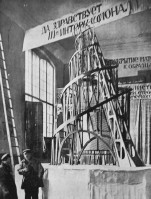
|
TATLIN, VLADIMIR, b 28 December 1885 in Moscow, d 31 May 1953 in Moscow. Painter, designer, and cofounder of constructivism. He grew up in Kharkiv and worked as a merchant marine. He studied art in Penza (1905-10) and at the Moscow School of Painting, Sculpture, and Architecture (1909-10) and private studios in Moscow. There he took part in avant-garde exhibitions. Around 1914 he shared his studio with Oleksa Hryshchenko and began working on painterly reliefs and 'counterreliefs' inspired at first by Pablo Picasso's relief sculptures. His constructions were entirely abstract combinations of materials (wood, metals, and glass). While heading the Moscow branch of the Division of Visual Arts of the Commissariat of Education (1918-19) and chairing the Department of Material Culture at the Moscow Higher State Artistic and Technical Workshops (1919-29) he worked on his famous model of the Monument to the Third International. He then chaired the Department of Material Culture at the Academy of Arts (1920-2) and the Museum of Artistic Culture (1922-5) in Petrograd. In 1925-7 he chaired the theater, film, and photography department of the Kyiv State Art Institute. While in Kyiv he designed the cover for Mykhailo Semenko, Geo Shkurupii, and Mykola Bazhan's poetry collection (1927) and established ties with the Nova Generatsiia futurist group in Kharkiv, and these ties he maintained after his return to Moscow. He was a major exponent of avant-garde art and design of the 1910s and 1920s. His intuitive constructivism is similar to that of Vasyl Yermilov and of the set designs of Anatol Petrytsky and Vadym Meller... |
| Vladimir Tatlin |
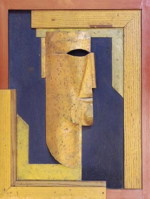
|
YERMILOV, VASYL, b 22 March 1894 in Kharkiv, d 4 December 1967 in Kharkiv. Painter and graphic designer. He studied art in Kharkiv Art School and Moscow. In 1918 he joined the avant-garde Union of Seven group in Kharkiv. Under Soviet rule Yermilov designed posters, 'agit-trains,' street decorations, billboards, the interiors of public buildings (eg, the murals in the foyer of the Kharkiv Circus and the Red Army Club in Kharkiv), theatrical sets, displays, packaging, and journal and book covers; he also directed the art department of the All-Ukrainian Bureau of the Russian Telegraph Agency (1920-1) and taught at the Kharkiv Art Institute (1922-35). He received several international prizes for his graphic designs, including a gold medal at the 1922 Leipzig International Graphics Exhibition and an award at the 1928 Köln International Press Exhibition. While a member of the Avanhard (Avant-garde) group (1926-9) he was graphic designer of its newspaper and journal and, with Valeriian Polishchuk, the three issues of Biuleten' Avanhardu. From 1927 he was also a member of the Association of Revolutionary Art of Ukraine. Yermilov's synthesis of formalist esthetics, folk designs, and traditional painting methods (including egg tempera) was an important contribution to the development of Ukrainian design of the 1920s. His distinctive style of constructivist collage and typographic design, called constructive-dynamism or spiralism, developed distinctly and in parallel with Russian constructivism. Because of his formalist interests Yermilov was forced out of the Soviet art arena in the late 1930s... |
| Vasyl Yermilov |
The preparation, editing, and display of the IEU entries about the early 20th-century Ukrainian avant-garde artists were made possible by the financial support of the CANADIAN FOUNDATION FOR UKRAINIAN STUDIES..
 XVI. UKRAINIAN MODERNIST ARTISTS IN PARIS
XVI. UKRAINIAN MODERNIST ARTISTS IN PARIS
Painters and sculptors from Ukraine were very heavily involved in the artistic revolution that swept Europe in the first decade of the twentieth century. Many spent time in Western Europe, particularly in Paris, in the prewar years, among them Vadym Meller, Alexander Archipenko, Alexandra Ekster (Exter), Mykhailo Boichuk, David Burliuk, Sofiia Levytska, Aleksandr Shevchenko, Vladimir Tatlin, N. Altman, and D. Shterenberg. Some, like Oleksa Hryshchenko (Alexis Gritchenko), Mykhailo Andriienko-Nechytailo (Michel Andreenko), and K. Redko came to Paris after the First World War, and several of them settled there permanently. Some of these artists, such as Alexander Archipenko, exerted a profound influence on European and world 20th-century art. Learn more about Ukrainian modernist artists in Paris and view numerous illustrations of their works by visiting such entries as:
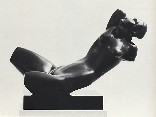
|
ARCHIPENKO ALEXANDER, b 30 May 1887 in Kyiv, d 25 February 1964 in New York. Modernist sculptor, painter, pedagogue, and a full member of the International Institute of Arts and Literature from 1953. Archipenko studied art at the Kyiv Art School in 1902-5, in Moscow in 1906-8, and then briefly at the Ecole des Beaux-Arts in Paris. His first one-man show took place in 1906 in Ukraine. He moved to Paris in 1909. In 1910 he exhibited his works with a group of Cubists at the Salon des Artistes Independants and then exhibited his works there annually until 1914. In 1912 Archipenko joined a new artistic group--La Section d'Or, which numbered among its members P. Picasso, G. Braque, J. Gris, F. Leger, R. Delaunay, R. de la Fresnaye, J. Villon, F. Picabia, and M. Duchamp--and participated in the group's exhibitions... |
| Alexander Archipenko |
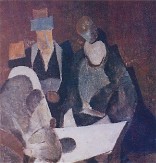
|
HRYSHCHENKO, OLEKSA, b 2 April 1883 in Krolevets, Chernihiv gubernia, d 28 January 1977 in Vence, France. Modernist painter, art scholar, and author. While specializing in biology at Kyiv University and Moscow University, he studied painting with Serhii Svitoslavsky in Kyiv and K. Yuon in Moscow. During a brief stay in Paris in 1911 he met A. Lhote, Alexander Archipenko, and Le Fauconnier and became interested in cubism. From 1913 to 1914 he studied in Italy and wrote several studies of Italian primitive artists and the relation between the icon and Western art. During the Revolution of 1917, Hryshchenko became professor of the State Art Studios in Moscow and was offered the directorship of the Tretiakov Gallery, but he escaped from Russia via Crimea to Turkey... |
| Oleksa Hryshchenko |

|
BOICHUK, MYKHAILO, b 30 October 1882 in Romanivka, Ternopil county, d 13 July 1937 in Kyiv. Influential Ukrainian modernist painter, graphic artist, and teacher. Boichuk studied at Yuliian Pankevych's art studio in Lviv (1898), a private art school in Vienna (1899), and the Cracow Academy of Arts (1899-1905). He continued his studies at the Munich and Vienna academies of art and exhibited his works at the Latour Gallery in Lviv in 1905 and in Munich in 1907. While living in Paris (1907-10), Boichuk visited the Academie Ranson and P. Serusier's studio, and, in 1909, he founded his own studio-school, at which his future wife Sofiia Nalepinska, Mykola Kasperovych, S. Baudouin de Courtenay, S. Segno, J. Lewakowska, O. Shaginian, and H. Szramm studied... |
| Mykhailo Boichuk |
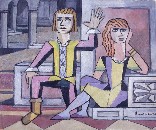 |
ANDRIIENKO-NECHYTAILO, MYKHAILO (known in France as Michel Andreenko), b 29 December 1894 in Odesa, d 12 November 1982 in Paris. Modernist painter and stage designer. In 1912-17 Andriienko-Nechytailo studied with N. Rerikh, A. Rylov, and I. Bilibin at the art school of the Society for the Promotion of the Arts in Saint Petersburg. In 1914-16 he exhibited the composition Black Dome and his first cubist works in Saint Petersburg. In 1914 he participated in an international graphics exhibition in Leipzig. In 1917-24 he devoted most of his time to designing stage sets for various theaters--in Saint Petersburg, Odesa, Prague, Paris, and for the Royal Opera in Bucharest. In Paris, where he lived from 1923, he also worked on sets for the films Casanova and Sheherazade and continued to paint in the cubist-constructivist style... |
| Mykhailo Andriienko-Nechytailo |
The preparation, editing, and display of the IEU entries associated with the creative legacy of the Ukrainian modernist artists in Paris were made possible by the financial support of the CANADIAN FOUNDATION FOR UKRAINIAN STUDIES.
 XVII. UKRAINIAN ARTISTS IN WESTERN UKRAINE IN THE FIRST HALF OF THE 20TH CENTURY
XVII. UKRAINIAN ARTISTS IN WESTERN UKRAINE IN THE FIRST HALF OF THE 20TH CENTURY
In the last few decades of the 19th century Ukrainian artists in Austrian-ruled Western Ukraine adapted to European trends, particularly those prevalent in Vienna and Cracow, where some of them had studied. Among them were Luka Dolynsky, Kornylo Ustyianovych, and Teofil Kopystynsky, all of whom depicted rural life through a romanticized ethnographic prism and were active in decorating churches. Both Mykola Ivasiuk, who was known for his panoramic historical canvases, and Antin Manastyrsky remained dedicated realists. At the beginning of the 20th century, impressionism influenced the work of Ivan Trush (although for the most part he remained a realist), Osyp Kurylas, and Olena Kulchytska. Other artists who worked in the impressionist style included Modest Sosenko and Yaroslav Pstrak. In interwar Western Ukraine under Polish rule, the most prominent Lviv painter was Oleksa Novakivsky, who began as an impressionist and was attracted by French postimpressionism and expressionism. He painted portraits and landscapes, and through his Novakivsky Art School he influenced an entire generation of future artists who went on to explore modern trends in art. The revival of the Byzantine style of church mural painting and decoration in Western Ukraine was encouraged by Metropolitan Andrei Sheptytsky, a great patron of the arts. One of the leading masters of Neo-Byzantinism was an emigre from central Ukraine, Petro Kholodny. Roman Selsky experimented with surrealism while his wife, Margit Selska, painted under the influence of constructivism and cubism; Mykola Butovych, Pavlo Kovzhun, and Robert Lisovsky explored cubism and abstraction. After the Second World War many Ukrainian artists fled from communist rule and settled in the West. Among those who remained in Western Ukraine, Roman Selsky, Margit Selska, and Vitold Manastyrsky managed to avoid the narrow confines of socialist realism and had a great influence on the formation of the next generation of western Ukrainian artists... Learn more about Ukrainian artists in Western Ukraine in the first half of the 20th century by visiting the following entries:
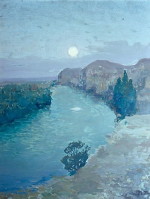
|
TRUSH, IVAN, b 17 January 1869 in Vysotske, Brody county, Galicia, d 22 March 1941 in Lviv. Painter, community figure, and art and literary critic. After studying at the Cracow Academy of Fine Arts (1891-7) under Leon Wyczolkowski and Jan Stanislawski, he lived in Lviv where he was active in Ukrainian artistic circles and community life. A friend of Ivan Franko, he organized the Society for the Advancement of Ruthenian Art and the Society of Friends of Ukrainian Scholarship, Literature, and Art and their exhibitions; copublished the first Ukrainian art magazine, Artystychnyi vistnyk; painted many portraits for the Shevchenko Scientific Society; lectured on art and literature; and contributed articles to Ukrainian literary and art journals. Trush was an outstanding Ukrainian impressionist, noted for his original use of color. A major part of his large legacy (over 6,000 paintings) consists of landscapes, including landscapes of Crimea, Rome, Venice, Egypt, and Palestine. His many genre paintings are noted for their simplicity of composition. His gallery of 350 portraits includes ones of Metropolitan Andrei Sheptytsky, Ivan Franko, Vasyl Stefanyk, Lesia Ukrainka, Mykhailo Hrushevsky, Mykola Lysenko, and many others. The first solo show of Trush's works took place in Lviv in 1899, and a large retrospective exhibition was held posthumously there in 1941. Major collections of his work are at the National Museum and the memorial museum in his former residence in Lviv...
|
| Ivan Trush |
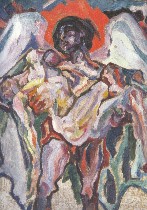
|
NOVAKIVSKY, OLEKSA, b 14 March 1872 in Slobodo-Obodivka (now Nova Obodivka), Olhopil county, Podilia gubernia, d 29 August 1935 in Lviv. Painter and educator. He studied painting under F. Klymenko in Odesa (1888-92) and at the Cracow Academy of Fine Arts (1892-3, 1895-1900) under J. Unierzyski and Jan Stanislawski. After graduating with a gold medal he lived in Mogila (now Nowa Huta), near Cracow, where he devoted himself to landscape painting. The first solo exhibition of his works was held in Cracow in 1911. Having attracted Metropolitan Andrei Sheptytsky as his patron, Novakivsky moved to Lviv in 1913 where exhibitions of his works took place in 1920 and 1921. In 1923 he established the Novakivsky Art School in Lviv which played a very important role in the development of Ukrainian art in Western Ukraine. During his Cracow period Novakivsky painted portraits, landscapes, still lifes, and genre scenes in a naturalistic and impressionist style that resembled that of his Polish contemporaries, such as Jan Stanislawski, Jacek Malczewski, and Stanislaw Wyspianski. During his early Lviv period his style evolved under the impact of the First World War to become more symbolist and expressionist. In the 1920s his colors grew more vivid, and his lines more dynamic, and many of his paintings from that time are fully expressionist in style. Novakivsky's oeuvre consists of over 500 oils, many of them unfinished. A memorial museum dedicated to him and his works was opened in Lviv in 1972... |
| Oleksa Novakivsky |
KHOLODNY, PETRO, b 18 December 1876 in Pereiaslav, Poltava gubernia, d 7 June 1930 in Warsaw. Distinguished painter, by profession a chemist. A graduate of the Kyiv Drawing School, he began to exhibit his early symbolist paintings in 1910. During the Ukrainian struggle for independence (1917-20), Kholodny worked in the Ukrainian National Republic's Ministry of Education. Leaving Ukraine with the UNR government in 1920, he settled in Lviv in 1921. The subsequent period proved to be the most productive one in Kholodny's artistic career. In 1922 he helped found the Circle of Promoters of Ukrainian Art and took part in its exhibitions. He began to paint icons and churches and to design stained-glass windows. His principal works of this period are the icons and stained-glass windows of the Dormition Church in Lviv, the iconostasis and murals of the Chapel of the Greek Catholic Theological Seminary in Lviv, numerous icons of parish churches, and the stained-glass windows of the church in Mraznytsia. The basic features of his work, rooted in Ukrainian artistic traditions that grew out of the synthesis of Byzantine iconography with folk art, were compositional unity, the primacy of the line, and harmonious, warm colors. In his stained-glass windows, Kholodny juxtaposed elements of pure colored glass to achieve lightness and transparency. He also painted many portraits and some historical compositions. Kholodny's style can be described as a mature impressionism of a Ukrainian variety that is profoundly lyrical. His neo-Byzantine works, which rivaled those of Mykhailo Boichuk, revealed new potentialities of the ancient style, free of schematism or archaism. After the Soviets occupied Lviv, many of Kholodny's works were destroyed for their allegedly 'nationalist' spirit and his church murals were painted over... |
|
| Petro Kholodny |
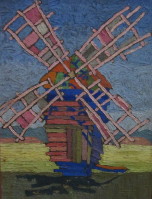
|
KOVZHUN, PAVLO, b 3 October 1896 in Kostiushky, Ovruch county, Volhynia gubernia, d 15 May 1939 in Lviv. Noted graphic artist, painter, and art scholar. His graphic works began to appear in Kyiv journals while he was still a student at the Kyiv Art School. By 1914 his work began to attract wide attention. Sent to the front of the First World War in 1915, at the outbreak of the Revolution of 1917 he joined the Ukrainian movement in the armed forces and edited Ukrainian military newspapers. During the Ukrainian National Republic period he helped to set up the Grunt publishing house, served as secretary of Universal'nyi zhurnal, and belonged to the Muzahet artistic and literary alliance in Kyiv. Finding refuge in Poland with the remnants of the UNR Army, in 1922 Kovzhun settled in Lviv, where he became a leading figure in the artistic community. With Volodymyr Sichynsky, Petro Kholodny, Serhii Tymoshenko, and Mykola Holubets, he founded the Circle of Promoters of Ukrainian Art, and in 1931 helped organize the Association of Independent Ukrainian Artists, whose journal, Mystetstvo, he edited (1932-6). His graphic art was displayed at exhibitions in Lviv, Warsaw, Prague, Brussels, Berlin, Rome, and Naples, and had a major impact on book graphics in Western Ukraine. Kovzhun ranks with Heorhii Narbut as the leading Ukrainian graphic artist of the 20th century. He was thoroughly modern and yet closely bound to Ukrainian artistic traditions. His early work was influenced by symbolism, futurism, and to some extent by Narbut, but after 1924 he developed his own style, which was at first expressionist and then constructivist. Kovzhun was also a noted muralist and painted a number of churches in a modernized neo-Byzantine style... |
| Pavlo Kovzhun |
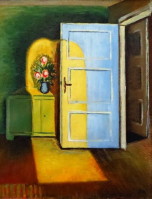
|
SELSKY, ROMAN, b 21 May 1903 in Sokal, Galicia, d 4 February 1990 in Lviv. Painter, graphic artist, and teacher; husband of Margit Selska. He studied under Oleksa Novakivsky in Lviv, graduated from the Cracow Academy of Fine Arts (1927), and made several trips to Paris, where he studied with Fernand Leger. Upon his return to Lviv in 1929, he was instrumental in establishing Artes (1929-36), an association of experimental artists, and was its first president. He taught at the Lviv Applied Arts High School (1935-47) and the Lviv Institute of Applied and Decorative Art (1947-72). Surrealist influences are apparent in his early works, such as Seashore in Hel (1932). After the Second World War, under the Soviet rule, Selsky was initially forced to paint in the style resembling socialist realism. He painted some realist landscapes and paintings depicting peasants at work. However, he abandoned that style in the late 1950s. In the late 1960s Selsky returned to painting the seashore, in works such as At the Seashore (1969), which show some influence of Leger, but especially that of the postimpressionist Pierre Bonnard. Selsky painted numerous landscapes, particularly of the Carpathian Mountains. The Carpathian environment is also reflected in his still lifes and compositions of interiors; many of them include views through windows and open doors. Except for a few realistic landscapes and somber still-life compositions from the 1940s and early 1950s, Selsky managed to avoid the narrow confines of socialist realism. His sensitive and vibrant palette and organization of flattened forms and space are in the Western European art tradition... |
| Roman Selsky |
_s.jpg)
|
SELSKA, MARGIT, (also Mariia, nee Reich), b 23 June 1903 in Kolomyia, Galicia, d 3 February 1980 in Lviv. Painter; wife of Roman Selsky. She studied at the Cracow Academy of Arts (1924-5), the Vienna Academy of Arts (1926-7), and the Academie moderne in Paris (1928-30) under Fernand Leger. In the 1930s she was one of the key members of Artes (1929-36), an association of experimental artists in Lviv, as well as a member of the Association of Independent Ukrainian Artists. Selska's works executed before the Second World War showed influences of constructivism (akin to Fernand Leger), cubism (especially that of Alexander Archipenko), and, to some extent, surrealism. However, most of her prewar paintings were lost during the Holocaust when her entire family was imprisoned in a Nazi concentration camp. Her relatives perished, but Selska was saved thanks to an escape organized by the Ukrainian underground. Under the Soviet rule after the war, Selska and her husband were initially forced to paint in the style resembling socialist realism. She painted realist landscapes and paintings depicting workers and peasants at work. However, in the late 1950s she abandoned that style and painted landscapes (such as Akkerman [1959] or Crimea [1961]), portraits (such as Violinist [1960s] or A Child by the Table [1960s]), and still lifes that are grounded in the modernist esthetics, in particular that of constructivism and cubism... |
| Magrit Selska |
The preparation, editing, and display of the IEU entries about Ukrainian artists in Western Ukraine in the first half of the 20th century were made possible by the financial support of the CANADIAN FOUNDATION FOR UKRAINIAN STUDIES.
 XVIII. 20TH-CENTURY UKRAINIAN GRAPHIC ART AND PRINTMAKING
XVIII. 20TH-CENTURY UKRAINIAN GRAPHIC ART AND PRINTMAKING
The 1863 and 1876 Russian prohibitions against Ukrainian-language book and journal publications delayed a normal development of graphic arts in Ukraine. Conditions improved somewhat only at the beginning of the 20th century, and new graphic artists and illustrators appeared, such as Ivan Izhakevych, Serhii Vasylkivsky, Opanas Slastion, and in Lviv, Olena Kulchytska. All of them were largely influenced by realism. Vasyl H. Krychevsky first explored the possibilities of a new style, combining elements of traditional Ukrainian printing with popular folk motives and using the latest graphic technology. The major craftsman of modern Ukrainian graphic art was Heorhii Narbut, who became renowned in Saint Petersburg. In 1917 he returned to Kyiv, where he made his most significant contributions to the development of Ukrainian graphic art. In his late works, Narbut aimed at a synthesis of Ukrainian baroque graphic traditions with a modern approach and flowing, rhythmic linearity. Graphic art was also nurtured by Mykhailo Boichuk, who advocated the continuation of Ukrainian artistic traditions, particularly Byzantine ones, through modern art forms; his followers include his wife Sofiia Nalepinska, Ivan Padalka, and Vasyl Sedliar. The realist style was espoused by the talented and prolific Vasyl Kasiian, who produced many engravings and illustrations on political and labor themes; as a professor at Soviet art schools, he had a major influence on the development of socialist realism in graphic art. In interwar Polish-ruled Galicia, there arose in Lviv an important group of graphic artists who were closely connected with artists in other European cities. The more prominent of these were Pavlo Kovzhun, who was well known for his cubist and constructivist book designs, Mykola Butovych, and Robert Lisovsky. After the Second World War all graphic art in Ukraine had to conform to the official style of socialist realism and was used as an instrument in political and economic propaganda in the tradition of the Vasyl Kasiian school. It was only during the brief thaw after Joseph Stalin's death that Western influences were allowed. The more prominent graphic artists of the shistdesiatnyky generation included Ivan Ostafiichuk, Bohdan Soroka, and Heorhii Yakutovych. Among Ukrainian emigre graphic artists, Jacques Hnizdovsky, who settled in the United States, achieved international prominence... Learn more about the 20th-century Ukrainian graphic art and printmaking by visiting the following entries:
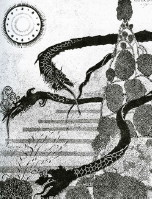
|
PRINTMAKING. The process and art of imprinting or stamping an engraved image onto paper, cloth, or leather. Unlike engravings or lithographs, prints are not necessarily made to be printed in books but are works of art that exist independently of textual material. Early Ukrainian wood engravings of the 16th century are not prints in the strict sense of the word, because they were all printed in books. They could, however, function as prints (eg, the picture of the Evangelist Luke in the Apostolos printed in Lviv in 1574). The first prints executed on individual sheets of paper were the early-17th-century portrayals of the four Evangelists printed by Pamva Berynda at the Striatyn Press. Professional printmaking of the 17th and 18th centuries holds a special place in Ukrainian art. At that time it was developed more fully than painting, sculpture, or graphic art. Not only religious but also secular printmaking of portraits, landscapes, and still lives developed fully. The greatest printmakers of the Cossack period were Master Illia, Master Prokopii, Dionisii Sinkevych, Nykodym Zubrytsky, Oleksander Tarasevych, Leontii Tarasevych, Ivan Shchyrsky, Averkii Kozachkivsky, Ivan Myhura, and Hryhorii K. Levytsky. Ukrainian printmaking declined during the 19th century. Only Taras Shevchenko can be included among those artists who raised the level of printmaking, in both subject matter and technique. Howerver, the printmaking was reborn in the 20th century in the works of original graphic artists, such as Heorhii Narbut, Olena Kulchytska, Volodymyr Zauze, Mykhailo Zhuk, Leopold Levytsky, Vasyl Kasiian, Mykhailo Derehus, and such emigre graphic artists as Jacques Hnizdovsky... |
| Printmaking |
_s.jpg)
|
NARBUT, HEORHII, b 9 March 1886 in Narbutivka, Hlukhiv county, Chernihiv gubernia, d 23 May 1920 in Kyiv. Painter and graphic artist. From 1906 he lived in Saint Petersburg. After studying art in Munich for several months in 1909, he returned to Saint Petersburg and became part of the Mir Iskusstva circle and gained prominence through his book covers and book illustrations (eg, for I. Krylov's fables [1912] and several stories by Hans Christian Andersen) and his neoclassical and symbolist watercolors. Having developed a keen interest in heraldry and the silhouette he illustrated and designed Russian-language editions of V. Lukomsky and V. Modzalevsky's book on 'Little Russian' heraldry (1914), the coats of arms of the Cossack hetmans (1915), Georgii Lukomsky's book on ancient Galician architecture (1915), and a book on the old estates of Kharkiv gubernia (1917). After the February Revolution of 1917 Narbut returned to Ukraine. In September 1917 he was appointed a professor at the Ukrainian State Academy of Arts in Kyiv, and in February 1918 he became its rector. There he laid the foundations for advanced art education and fostered a pleiad of graphic artists, including Oleksander Lozovsky, Pavlo Kovzhun, and Robert Lisovsky. Through his covers and graphics for postrevolutionary books and journals; his graphic designs for Ukrainian National Republic currency, postage stamps, seals, and charters; and his bookplates and series of drawings and initials illustrating the Ukrainian alphabet (1917, 1919) with Cossack, Ukrainian baroque, and folk motifs, he initiated, with Mykhailo Boichuk and Vasyl H. Krychevsky, the rebirth of the national style of Ukrainian art. Narbut died prematurely from typhus...
|
| Heorhii Narbut |
_s.jpg)
|
KULCHYTSKA, OLENA, b 15 September 1877 in Berezhany, Galicia, d 8 March 1967 in Lviv. Painter, graphic artist, master of applied arts, and pedagogue. Completing her art studies in Lviv (1901-3) and Vienna (1903-8), she taught at a gymnasium in Peremyshl (1910-38). In 1939 she joined the ethnographic department of the Museum of the Shevchenko Scientific Society in Lviv. After the Second World War she taught book graphics at the Lviv Polygraphic Institute (1945-51). Most of Kulchytska's artistic work consists of oil paintings, watercolors, and illustrations, particularly of children's books. As a graphic artist she used various techniques and produced woodcuts, linocuts, copper engravings, and etchings. Among her chief oil paintings are Children in a Meadow (1908), Harvest (1913), and Children with Candles (1913). Her mastery of the woodcut and linocut techniques is evident in such print series as 'Ukrainian Writers' (1920), 'Folk Architecture' (1931), 'The Hutsul Region' (1935), and 'Dovbush' (1940). Her etchings, such as The Moloch of War (1915) or Vengeance (1917), are a powerful condemnation of the exploitation of Ukrainian peasants and of war. She has illustrated numerous books. Her skillful blending of modernist Viennese trends with Ukrainian folk art made her art extremely popular. From 1908 Kulchytska took part in numerous exhibitions in Lviv, Cracow, Warsaw, Poznan, Kyiv (1911, 1913), Poltava, Vienna, Berlin, Kharkiv, and Prague. In 1950 she donated her own collection consisting of over 3,000 of her works (paintings, prints, and kilims) to the Lviv Museum of Ukrainian Art... |
| Olena Kulchytska |
 (1939)_s.jpg)
|
KASIIAN, VASYL, b 1 January 1896 in Mykulyntsi, Stanyslaviv county, Galicia, d 26 June 1976 in Kyiv. Graphic artist of the realist school; from 1947 full member of the USSR Academy of Arts and the Academy of Architecture of the Ukrainian SSR. A graduate of the Prague Academy of Arts (1926), he assumed Soviet citizenship and in 1927 immigrated to the Ukrainian SSR. A prolific and versatile artist, he excelled in all the graphic art techniques--woodcut, copper engraving, linocut, and lithography--as well as pen drawing and watercolors. During his Prague period Kasiian dealt with social themes, depicting the poverty and hard life of the lower classes in Europe. Coming to Ukraine, he created several series of propaganda woodcuts and copper engravings in the socialist-realist style about collective farms, the building of the Dnieper Hydroelectric Station, mining in the Donbas, and the building of the Kyiv Metro. He also devoted a series of engravings to Vladimir Lenin and to Joseph Stalin (almost 50 works). Following Nikita Khrushchev's condemnation of the personality cult, Kasiian destroyed whole portfolios of his engravings of Stalin. The most valuable part of his rich, technically flawless legacy consists of the works on industrial themes, which document the economic transformation of Ukraine, and the illustrations to works by Taras Shevchenko, Lesia Ukrainka, Ivan Franko, Mykhailo Kotsiubynsky, Vasyl Stefanyk, and Olha Kobylianska. Socialist realism, which Kasiian defended in his articles, led him to adopt elements of naturalism and had a detrimental effect on his later work.. |
| Vasyl Kasiian |
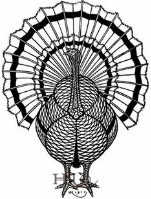
|
HNIZDOVSKY, JACQUES, b 27 January 1915 in Pylypche, Borshchiv county, Galicia, d 8 November 1985 in New York. Painter, graphic artist, and book designer. Having studied at the academies of art in Warsaw and Zagreb, he settled in the United States in 1949. In his paintings and prints he reduced objects to their primeval structure of lines and forms, and called this style 'simplified realism.' Among his oil paintings are multifigural compositions such as The Homeless (1947), also known as Displaced Persons, portraits, landscapes, numerous still lifes, and entire series on the Paris metro, New York skyscrapers, and the Bronx brownstones. The same precision and devotion to detail is displayed in his woodcuts, which number close to 250. They include some extremely intricate works, eg, Field (1962) or Sunflower (1965). Starting with a style close to Durer's, he absorbed elements of old Ukrainian baroque engravings, Chinese and Japanese woodcuts, and various modern tendencies, and molded them into a personal style that brought him international recognition. Hnizdovsky illustrated many books, including The Tale of Ihor's Campaign (1950) and Marie Bloch's Ukrainian Folk Tales (1964). He also designed several hundred book covers and a large number of bookplates. One-man exhibitions of his work have been held at leading galleries in New York, New Orleans, Paris, and London. His works are included in the permanent collections of art museums (Boston, Cleveland, Philadelphia), museums, galleries (Winnipeg, Addison), universities (Duke, Delaware), and libraries (New York Public Library, Library of Congress), and in numerous private collections... |
| Jacques Hnizdovsky |
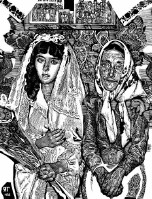
|
YAKUTOVYCH, HEORHII, b 14 February 1930 in Kyiv, d 5 September 2000 in Kyiv. Graphic artist; corresponding member of the USSR (now Russian) Academy of Arts from 1983. He studied at the Kyiv State Art Institute (1948-54) under Vasyl Kasiian and Ilarion Pleshchynsky and taught there in 1954-7 and 1961-2. A representative of the shistdesiatnyky generation, Yakutovych was a master of different graphic techniques from woodcut to metal engraving. He blended realism with formal experimentation to create a thoroughly modernist impression. The influence of Hutsul folk art is evident in his use of geometric forms. Yakutovych illustrated editions of Mykhailo Kotsiubynsky's novels Fata morgana (1957) and Shadows of Forgotten Ancestors (1966), Ivan Kocherha's plays Yaroslav the Wise and Svichka's Wedding (1962), Ivan Franko's novel Zakhar Berkut (1972), the epic The Tale of Ihor's Campaign (1977), Vasyl Stefanyk's story collection The Maple Leaves (1978), the epic The Tale of Bygone Years (1981), and Nikolai Gogol's Vii (1985). Many of his prints have been widely reproduced. They include the series 'Ancient Ukrainian Music' (1957), 'Ivan Vyshensky' (1959), 'Oleh Horyslavych' (1959), and 'Arkan' (1960) and two series of postcards on folk-song themes (1960, 1963). Yakutovych served as artistic consultant for the films Shadows of Forgotten Ancestors (1965; director, Serhii Paradzhanov) and Zakhar Berkut (1971; director, Leonid Osyka)... |
| Heorhii Yakutovych |
The preparation, editing, and display of the IEU entries about the 20th-century Ukrainian graphic art and printmaking were made possible by the financial support of the CANADIAN FOUNDATION FOR UKRAINIAN STUDIES.
 XIX. 20TH-CENTURY UKRAINIAN PRIMITIVE (NAIVE) ART
XIX. 20TH-CENTURY UKRAINIAN PRIMITIVE (NAIVE) ART
The terms 'primitive' or 'naive' art emerged in fine art during the late 19th-century. These terms were initially used to describe 'outsider art' created by artists without a formal training or degree. Although now there are academies for primitive (naive) art and this art genre is fully recognized, we still most often associate it with the work of untrained artists and relate it to modern-day folk art. Primitive or naive paintings or sculptures do not conform to the formal principles of academic art, such as, for example, the three rules of perspective developed during the Renaissance. Naive art is characterized by a refreshing, somewhat awkward innocence, the charming use of bright colors, child-like perspective, and idiosyncratic scale. It portrays simple, easily-understandable and often idealized scenes of everyday life. In the 20th century several Ukrainian 'primitive' or 'naive' artists, inluding Nykyfor, Kateryna Bilokur, or Mariia Pryimachenko, achieved international recognition... Learn more about the 20th-century Ukrainian primitive (naive) art by visiting the following entries:
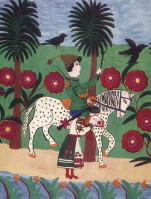
|
PRIMITIVE (NAIVE) ART. Pictures by artists without professional training who work in a way that differs from the traditional or avant-garde with respect to manner of depiction and techniques of paint application. Such pictures show an idiosyncratic naivete in the treatment and depiction of the subject matter and the use of the medium. Icons on glass popular from the late 18th to the early 20th centuries in Western Ukraine are charming examples of primitive art, as are folk icons on panels created by artists who took inspiration from professionally painted models. The best known Ukrainian primitive artist is Nykyfor, who rendered churches, other buildings, saints, and people in captivating compositions. Others whose work was influenced by Ukrainian folk art and ornamentation include Kateryna Bilokur, who painted flower fantasies, and Mariia Pryimachenko and Hanna Sobachko-Shostak, both of whom portrayed fantastic creatures and plant motifs in vivid colors. Of the Ukrainian primitive artists working outside their homeland, Dmytro Stryjek in Canada has received the greatest recognition... |
| Primitive (naive) art |
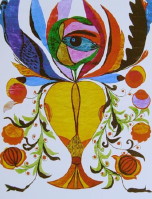
|
SOBACHKO-SHOSTAK, HANNA, b 15 December 1883 in Skoptsi (now Veselynivka), Pereiaslav county, Poltava gubernia, d 3 December 1965 in Cherkizovo, Moscow oblast. Master of primitive art and folk decorative painting. In 1910 she began painting embroidery and kilim patterns in A. Semigradova and Ye. Prybylska's folk-art workshop in Skoptsi. From 1932 she lived in exile in Cherkizovo and designed embroidery patterns for the local cloth factory. Her decorative paintings, with floral and faunal motifs, are distinguished by their dynamic composition, asymmetry, and use of intense colors. Sobachko's work was exhibited in Kyiv (1913, 1919, 1963, 1965), Saint Petersburg (1913), Moscow (1915, 1927, 1936), Paris (1913, 1937), Berlin (1914, 1922), and New York (1939). A book about her by H. Miestiechkin was published in Kyiv in 1965...
|
| Hanna Sobachko-Shostak |
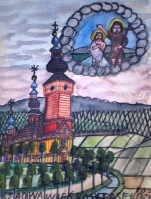
|
NYKYFOR [real name: Drovniak, Epifanii], b 21 May 1895 in Krynytsia (Krynica), Nowy Sacz county, Galicia, d 10 October 1968 in Krynytsia. Lemko naive painter. A deaf son of a beggar woman, he supported himself from his teens by begging for food or a few coins in exchange for his small drawings and watercolors. He was discovered by Ukrainian and Polish artistic circles in the 1930s. With the help of Roman Turyn, one of his earliest discoverers, his works were exhibited in Paris in 1932. Over 100 of his works were included in an exhibition of self-taught artists held by the Association of Independent Ukrainian Artists in Lviv in 1938. Like other Lemkos, he was deported to northern Poland by the Polish authorities during Operation Wisla after the Second World War. He returned illegally twice to Krynytsia before he was allowed to stay. In the 1950s and 1960s his works were exhibited in London, Rome, Belgrade, Amsterdam, Paris, Brussels, Florence, Liege, Haifa, Vienna, Frankfurt, Chicago, Basel, Rotterdam, Lviv, Kyiv, and New York. In his lifetime Nykyfor produced over 30,000 small color drawings or watercolors depicting existing and imaginary Lemko buildings, churches, landscapes, saints, and individuals (often himself). In style some of his works belong to the Lemko tradition of folk icon painting on glass; others are typical of naive art in general... |
| Nykyfor |
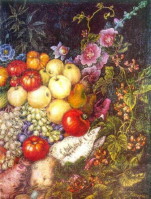
|
BILOKUR, KATERYNA, b 7 December 1900 in the village of Bohdanivka, Kyiv gubernia, d 10 June 1961 in Bohdanivka. Self-taught master of primitive art and decorative folk painting. Bilokur painted flowers and fruits in gardens, orchards, and fields; still lifes; and several portraits and self-portraits. Her paintings display originality, vivid coloring, and great attention to detail. In 1954 three paintings by Bilokur were exhibited at an international exhibition in Paris where, among others, they were highly praised by Pablo Picasso. Her work is preserved at the Kyiv Museum of Ukrainian Decorative Folk Art. Albums of her paintings were published in Kyiv in 1959, 1975, and 2010... |
| Kateryna Bilokur |
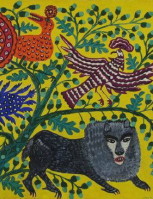
|
PRYIMACHENKO, MARIA, b 30 December 1908 in Bolotnia, Radomyshl county, Kyiv gubernia, d 18 August 1997 in Bolotnia, Ivankiv raion, Kyiv oblast. Famous folk naive painter. She has lived in Bolotnia (now in the Chornobyl nuclear accident zone) throughout her life and has done over 500 primitive paintings, murals, illustrations to verses and children's stories, and ceramic decorations. Distinguished by their vivid colors, they include the painting series 'Bolotnia's Animals' (1935–41), 'For People's Enjoyment' (1960–6), and the more recent 'Chornobyl Cycle'; murals, such as Peahen (1936), Cossack Grave (1962), and Bears in the Apiary (1965); and illustrations to several children's poetry books by Mykhailo Stelmakh. Her works have been displayed at Soviet and international exhibitions. Albums of her paintings were published in 1971 and 1985... |
| Maria Pryimachenko |
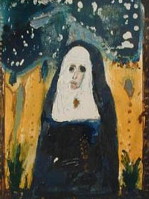
|
STRYJEK, DMYTRO, b 5 November 1899 in Lanivtsi, Borshchiv county, Galicia, d 7 March 1991 in Saskatoon, Saskatchewan. Naive painter; one of the most prominent primitive artists in Canada. A resident of Canada since 1923, he began painting seriously after his retirement in 1965. After moving to Saskatoon in 1967, he began exhibiting and attracted the attention of curators and art historians. His subjects include landscapes, flowers, birds, and religious and historical events, often those remembered from his youth in Ukraine. His portraits include some famous Ukrainians, such as Taras Shevchenko, Lesia Ukrainka, Hetman Ivan Mazepa, Symon Petliura, and Cardinal Yosyf Slipy, and world leaders, such as Queen Elizabeth II, Indira Ghandi, John Diefenbaker, and Pierre Trudeau. Although Stryjek lived most of his life in Canada, his vision is deeply rooted in his Ukrainian environment and the Ukrainian community in Saskatoon. His paintings are astonishingly inventive and hauntingly lyrical (eg, the series 'Hill of Flowers'). A brilliant colorist, Stryjek achieves a freshness that seems inexhaustible, and challenges accepted ideas of untutored painting as separate from mainstream art. A monograph about him by Peter Millard was published in 1988 in conjunction with a cross-Canada traveling exhibition of Stryjek's paintings... |
| Dmytro Stryjek |
The preparation, editing, and display of the IEU entries about the 20-th century Ukrainian primitive (naive) art were made possible by the financial support of the CANADIAN FOUNDATION FOR UKRAINIAN STUDIES.
 XX. KYIV'S ARCHITECTURAL MONUMENTS DESTROYED IN THE 1930s AND 1940s
XX. KYIV'S ARCHITECTURAL MONUMENTS DESTROYED IN THE 1930s AND 1940s
One aspect of the multifaceted antireligious campaign, initiated by the Soviet authorities in the late 1910s and greatly intensified during the Stalinist terror of the 1930s, was the government-organized methodical destruction of churches in Ukraine, including numerous masterpieces of the Ukrainian medieval and baroque architecture. A survey of major architectural monuments destroyed in the city of Kyiv during the ostensibly "peaceful" decade of the 1930s can be extrapolated to reflect the overall scope of this destruction throughout Ukraine. Among the ancient monuments of sacral architecture dismantled by the authorities in Kyiv in the mid-1930s were such unique architectural ensembles as the 12th-century Saint Michael's Golden-Domed Monastery, the 12th-century Saint Nicholas's Monastery, and the 17th-century Epiphany Brotherhood Monastery, as well as numerous individual churches, such as the 12th-century Pyrohoshcha Church, 12th-century Church of the Three Saints, 17th-century Saint Nicholas's Military Cathedral, the 17th-century Church of SS Peter and Paul, and many others. The devastation of Kyiv's old architecture was continued by the Soviet troops during their retreat from Kyiv in 1941 before the advancing German army. Soviet sappers set explosives under the buildings along the entire length of Khreshchatyk, Kyiv's main thoroughfare, as well as under the main church of the ancient Kyivan Caves Monastery, the 11th-century Dormition Cathedral, and all of these unique architectural monuments were blown up. Replicas of some of these architectural structures, including the Dormition Cathedral and Saint Michael's Monastery, were built by the Ukrainian government in the 1990s ansd 2000s. However, the original buildings and most of the priceless art they contained, such as mosaics, frescoes, and iconostases, were irretrievably lost... Learn more about Kyiv's destroyed architectural monuments by visiting the following entries:
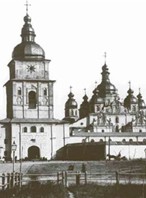
|
SAINT MICHAEL'S GOLDEN-DOMED MONASTERY. An Orthodox men's monastery in Kyiv. In the 1050s Prince Iziaslav Yaroslavych built Saint Demetrius's Monastery in the old upper city of Kyiv, near Saint Sophia Cathedral. In 1108-13 his son, Sviatopolk II Iziaslavych, built a church at the monastery dedicated to Saint Michael the Archangel. The monastery was mostly destroyed during the Tatar invasion. Written records confirm that the monastery was reopened by 1496. Restored and enlarged over the 16th century, it gradually became one of the most popular and wealthy monasteries in Ukraine. In 1620 Yov Boretsky made it the residence of the renewed Orthodox metropolitan of Kyiv. It enjoyed the patronage of hetmans and other benefactors and acquired many valuable artifacts. The main church of the monastery was an important architectural and cultural monument. After the Soviet seizure of power the monastery was closed, and in 1936, during the Stalinist antireligious campaign, the main church was demolished by the authorities. The construction of a replica of the Saint Michael's Church in independent Ukraine began on 24 May 1997. The church was officially opened on 30 May 1999... |
| Saint Michael's Monastery |
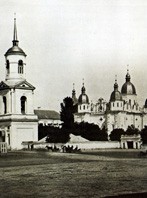
|
KYIV EPIPHANY BROTHERHOOD MONASTERY. An Orthodox monastery established in 1616 in Kyiv's Podil district after the noblewoman Yelyzaveta Hulevychivna donated a lot and orchard for this purpose. The Kyiv Epiphany Brotherhood, which was affiliated with the monastery, had built the original Kyiv Epiphany Brotherhood School on an adjacent lot in 1615. The monastery's first wooden church was destroyed by fires at least twice, in 1658 and 1665. The new church was designed by Yosyp Starchenko in the Ukrainian baroque style and built in 1693. The bell tower, designed by Stepan Kovnir in 1756, stood above the main gate to the monastery. The monastery owned extensive property donated to it by Kyivan metropolitans (Petro Mohyla and Rafail Zaborovsky) and Cossack hetmans (Bohdan Khmelnytsky and Ivan Mazepa). The rector of the brotherhood school (later the Kyivan Mohyla Academy) was also the hegumen (from 1731, archimandrite) of the monastery; Teofan Prokopovych was its most famous hegumen. Hetman Petro Konashevych-Sahaidachny and Vasyl Hryhorovych-Barsky were buried at the monastery. Despite their architectural and historical significance, the Epiphany Church and the bell tower were demolished by the Soviet authorities in 1935... |
| Kyiv Epiphany Monastery |
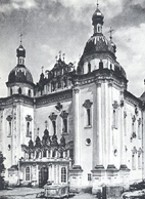
|
SAINT NICHOLAS'S MILITARY CATHEDRAL. One of the finest Cossack baroque buildings financed by Hetman Ivan Mazepa. It was built by Yosyp Starchenko in 1690-3 on one of the highest sites in Kyiv, on the grounds of Saint Nicholas's Monastery. The cathedral consisted of three naves, five domes, an elaborately carved facade, and richly embellished portals. Inside was a unique baroque seven-tier iconostasis (15.5 m high, 22.0 m wide) donated by the Kyiv burgher Sozon Balyka. After Mazepa's death his coat of arms was removed from the facade. A three-story baroque campanile was built in the 1750s. In 1831 the Russian military expropriated the monastery, which was then within the area of the Kyivan Cave Fortress, and began using the cathedral as the Kyiv garrison church. In the 1920s, restoration of the cathedral was supervised by the All-Ukrainian Academy of Sciences. Nevertheless, as part of their antireligious campaign, the Soviet authorities dismantled the iconostasis, and in 1934 they demolished the entire cathedral... |
| Saint Nicholas's Cathedral |
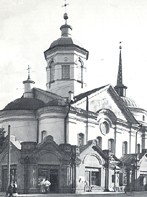
|
PYROHOSHCHA CHURCH OF THE MOTHER OF GOD. A church built in the Byzantine style in the Podil district of Kyiv in 1132-6 during the reign of Prince Mstyslav I Volodymyrovych. The church consisted of three naves and apses covered by one dome. The walls were decorated with frescoes, and the floor was laid with glazed and mosaic tiles. The first building of the Kyivan princes to be erected entirely of brick instead of stone, in the medieval period it was the main church of the Podil's merchants and tradesmen and housed an orphanage, a hospital for the poor, and the municipal archives. In 1613-33, when the Saint Sophia Cathedral was the seat of the Uniate Kyiv metropoly, the church served as the cathedral of the Orthodox metropolitans. It was reconstructed several times and in 1778 it acquired one of the finest rococo iconostases in Ukraine. In 1835 a new belfry was built in the Empire style above the main entrance. In 1935 the church was destroyed by the Soviet authorities during their antireligious campaign, so that a public square could be expanded. The church was rebuilt in independent Ukraine in 1998... |
| Pyrohoshcha Church |
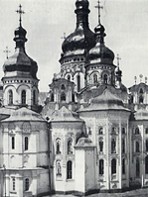
|
DORMITION CATHEDRAL OF THE KYIVAN CAVE MONASTERY. The main church of the Kyivan Cave Monastery. Built in 1073-8 at the initiative of Saint Theodosius of the Caves during the hegumenship of Stefan of Kyiv and funded by Prince Sviatoslav II Yaroslavych. The cathedral had three naves, which on the outside terminated in many-faced apses. Inside, the central part was decorated with mosaics (including an Oranta), while the rest of the walls were painted with frescoes. According to the Kyivan Cave Patericon, Master Olimpii was to have been one of the mosaic masters. At the end of the 11th century many additions to the cathedral were built, including Saint John's Baptistry in the form of a small church on the north side. In the 17th century more cupolas and decorative elements in the Cossack baroque style were added. As the Soviet Army retreated from Kyiv on 16-17 September 1941, mines were placed under the cathedral, and on 3 November it was blown up. The reconstruction of the cathedral began in independent Ukraine in 1998 and was completed in August 2000... |
| Dormition Cathedral |
The preparation, editing, and display of the IEU entries featuring Kyiv's architectural monuments destroyed in the 1930s and 1940s were made possible by a generous donation from ARKADI MULAK-YATSKIVSKY of Los Angeles, CA, USA.
 XXI. SOCIALIST REALISM IN SOVIET UKRAINIAN ART
XXI. SOCIALIST REALISM IN SOVIET UKRAINIAN ART
In the 1930s all avant-garde activities in Soviet Ukraine came to a halt with the introduction of socialist realism as the only literary and artistic method permitted by the communist regime. Painting was limited to naturalistically rendered thematic canvases of the Bolshevik October Revolution of 1917 and its champions, glorification of the Soviet state and its leaders, portraits and genre scenes of happy workers and peasants, and romanticized depictions of war and its heroes. Particularly in its first period (1934-41) socialist realism's range in painting was restricted to depictions of industrialization and collectivization and to numerous portraits and monuments to Joseph Stalin. Landscapes and still-life compositions were discouraged and all departures from the socialist-realist canon were condemned as 'formalist.' Sculpture was particularly pompous during the Stalinist period, in which thousands of monuments to Vladimir Lenin, Karl Marx, Joseph Stalin, and Maxim Gorky were erected. Socialist realism was enforced by means of repressions. Some modernist painters, such as Anatol Petrytsky, survived the terror, but their works were destroyed (an extensive series of Petrytsky's portraits). Many others, including Mykhailo Boichuk, Sofiia Nalepinska, Vasyl Sedliar, and Ivan Padalka, were shot. Departures from the norm were labeled 'formalism,' 'abstractionism,' or 'modernism' and proscribed. The narrow confines of socialist realism were widened somewhat after the death of Joseph Stalin, particularly during Nikita Khrushchev's cultural thaw. But even in its last stages socialist realism was praised for its Party orientation and its 'populism' (narodnist). Those terms continued to be used as synonyms for devoted service to the interests of the Party. Socialist realism also demanded isolation from the art of the West. Among the more prominent socialist-realist artists were Volodymyr Kostetsky, Karpo Trokhymenko, Mykhailo Bozhii, Serhii Hryhoriev, Dmitrii Shavykin, and Oleksii Shovkunenko. The style of socialist realism in graphic art was developed under the influence of Vasyl Kasiian. Notable Ukrainian sculptors who have worked in the socialist-realist manner are Mykhailo Lysenko, Ivan Makohon, Valentyn Znoba, Teodosiia Bryzh, Vasyl Borodai, and others... Learn more about the only officially sanctioned style of socialist realism in the art of Soviet Ukraine by visiting the following entries:
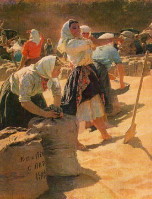
|
SOCIALIST REALISM. The only officially sanctioned so-called 'creative method' in Soviet art and literature from the early 1930s. The term socialist realism and its theoretical underpinnings were officially adopted by the First Congress of Writers of the USSR in August 1934, when the Soviet Writers' Union was established. Those active in other fields (theater, painting, sculpture, cinema, music) were also organized into single artistic unions, and also adopted socialist realism as the basic creative method. According to the resolution of the first Writers' Union congress: 'socialist realism demands a true, historical, and concrete depiction of reality in its revolutionary development. The realism and historical concreteness of the artistic rendering of reality must be tied to the ideological re-education and training of workers in the spirit of socialism.' As applied, however, those principles had a very narrow meaning. The 'true depiction of reality in its revolutionary development' meant that art and literature were to serve as glorifying illustrations of the policies of the Communist Party, and to portray what was hoped for in such a way that it seemed real. Deviations into truly realistic portrayals of Soviet reality and its deficiencies were attacked as 'slavishness to facts' or 'anti-Soviet agitation and propaganda.' Socialist realism's need to hide falsity of content gave rise to certain characteristics of style in all Soviet art and literature. In painting it resulted in excessive pathos, photographism (with gestures and motion depicted as if frozen by photographs), and the tendency to dwell on luxurious uniforms and interiors...
|
| Socialist realism |
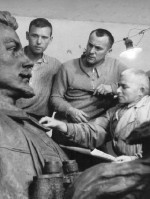
|
UNION OF ARTISTS OF UKRAINE. The only official organization of artists and art scholars that existed in Soviet Ukraine after the Party banned all other artistic organizations in 1932 and set up an organizational committee. In 1938 the union was officially founded at its first congress. Subsequent congresses were held every five or six years from 1956. The union was divided into sections (painting, sculpture, poster design, graphic art, large-scale decorative art, applied art, artistic design, stage design) and commissions (art criticism and art scholarship). The Art Fund of the Ukrainian SSR was administered by it. The union was divided into 20 oblast organizations. In 1983 their combined membership was 2,200. The union's official organs have been Maliarstvo i skul'ptura, later Obrazotvorche mystetstvo (1935-41), and then Obrazotvorche mystetstvo (1970-). Its presidents have been I. Boichenko (1938-41), Oleksandr S. Pashchenko (1941-4), Vasyl Kasiian (1944-9), Oleksii Shovkunenko (1949-51), M. Khmelko (1951-5), Mykhailo Derehus (1955-62), Vasyl Borodai (1968-82), Oleksander Skoblykov (1982-3), Oleksandr Lopukhov (1983-89), and Volodymyr Chepelyk (elected in 1990). In the late 1980s the union freed itself of Party control, and it no longer propagates socialist realism as the only artistic approach. Many of Ukraine's talented artists have never been members of the union. In 1998 the union was granted the status of a national union and changed its name to the National Union of Artists of Ukraine... |
| Union of Artists of Ukraine |
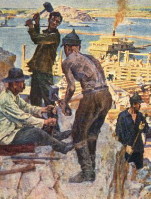
|
TROKHYMENKO, KARPO, b 25 October 1885 in Sushchany, Vasylkiv county, Kyiv gubernia, d 1 October 1979 in Kyiv. Painter. He studied at the Kyiv Art School (1902-10), the Moscow School of Painting, Sculpture, and Architecture (1906-7), and under Mykola Samokysh at the Saint Petersburg Academy of Arts (1910-16). He worked in Kyiv as an instructor for the Commission for the Protection of Historical and Artistic Monuments (1918-20) and taught at the Kyiv Art School (1918-19), the Kyiv Artistic-Industrial Professional School and Kyiv Art Tekhnikum (1926-33), and the Kyiv State Art Institute (1933-74). He belonged to the Association of Artists of Red Ukraine (1926-32) and became vice-chairman of the Arts Council of the Ministry of Education of the Ukrainian SSR. Trokhymenko worked in watercolors, oils, and pencil. He painted murals in the church at the Swedish Grave in Poltava; realistic historical scenes, such as Cossacks' Supper at Their Battle Posts (1917); and landscapes such as The Dnipro from Ivanova Mountain (1926). He also created Soviet genre paintings in the style of socialist realism. Taras Shevchenko and his works inspired such of his canvases as Shevchenko on Chernecha Mountain (1954). Books about Trokhymenko have been written by P. Musiienko (1946) and Ivan Vrona (1957), and an album of his works was published in 1969... |
| Karpo Trokhymenko |
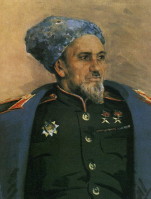
|
SHOVKUNENKO, OLEKSII, b 21 March 1884 in Kherson, d 12 March 1974 in Kyiv. Painter and educator; full member of the USSR Academy of Arts from 1947. A graduate of the Odesa Art School (1908) and the Saint Petersburg Academy of Arts (1917), he took part in the exhibitions of the Society of South Russian Artists (1913-19) and was a member of the Kostandi Society of Artists (1924-9). He taught at the Odesa Art Polytechnic (1926-9) and Odesa Art Institute (1929-35) and at the Kyiv State Art Institute (1936-63). He painted portraits, including ones of prominent Ukrainian cultural figures, such as Yurii Yanovsky, Pavlo Tychyna (1949), Maksym Rylsky (1945), Ivan Le (1943), Leonid Pervomaisky (1943), Mariia Lytvynenko-Volgemut, Volodymyr Zabolotny, Nataliia Uzhvii (1947), Mykhailo Lysenko (1947), and Oleksader Bohomolets (1945), and many natural, urban, and industrial landscapes of Ukraine (such as Flood in Koncha Zaspa, 1954), Caucasia, Moscow, the Urals, Moldavia, and Bashkiria, including series (painted in the style of socialist realism) depicting the Odesa shipyard (1925-35) and the construction of the Dnieper Hydroelectric Station (1930-2) (such as The Construction of the Dniprohes, 1931). For the latter series he was awarded the grand prize at the Art and Technology in Contemporary Life Exhibition in Paris (1937). A volume of recollections about Shovkunenko was published in 1980, and Leonid Vladych's books about him appeared in 1960 and 1983... |
| Oleksii Shovkunenko |
 (1939)_s.jpg)
|
KASIIAN, VASYL, b 1 January 1896 in Mykulyntsi, Stanyslaviv county, Galicia, d 26 June 1976 in Kyiv. Graphic artist of the realist school; from 1947 full member of the USSR Academy of Arts and the Academy of Architecture of the Ukrainian SSR. A graduate of the Prague Academy of Arts (1926), he assumed Soviet citizenship and in 1927 immigrated to the Ukrainian SSR. A prolific and versatile artist, he excelled in all the graphic art techniques--woodcut, copper engraving, linocut, and lithography--as well as pen drawing and watercolors. During his Prague period Kasiian dealt with social themes, depicting the poverty and hard life of the lower classes in Europe. Coming to Ukraine, he created several series of propaganda woodcuts and copper engravings in the socialist-realist style about collective farms, the building of the Dnieper Hydroelectric Station, mining in the Donbas, and the building of the Kyiv Metro. He also devoted a series of engravings to Vladimir Lenin and to Joseph Stalin (almost 50 works). Following Nikita Khrushchev's condemnation of the personality cult, Kasiian destroyed whole portfolios of his engravings of Stalin. The most valuable part of his rich, technically flawless legacy consists of the works on industrial themes, which document the economic transformation of Ukraine, and the illustrations to works by Taras Shevchenko, Lesia Ukrainka, Ivan Franko, Mykhailo Kotsiubynsky, Vasyl Stefanyk, and Olha Kobylianska. Socialist realism, which Kasiian defended in his articles, led him to adopt elements of naturalism and had a detrimental effect on his later work... |
| Vasyl Kasiian |
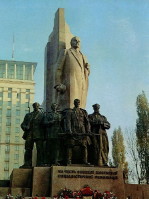
|
BORODAI, VASYL, b 18 August 1917 in Katerynoslav (present-day Dnipro), d 19 April 2010 in Kyiv. Sculptor. Borodai studied at the Kyiv State Art Institute (1947-53). In 1966 he became lecturer, and in 1971 professor, at the institute. He was a full member of the Academy of Arts of the USSR from 1973 and was chairman of the Union of Artists of Ukraine from 1968 to 1973. Among his sculptures are the following compositions: Youth (1951), Ivan Bohun (1954), Lesia Ukrainka (1957), and Bandura Player (1960). He also sculpted portraits of Petro Panch (1960), Pavlo Tychyna (1963), Lev Revutsky (1963), and Tetiana Yablonska (1974), as well as the series Through Egypt (1961-4) and some monuments--busts of Juliusz Slowacki in Kremianets (1969) and of Taras Shevchenko in Arrow Park, New York State (1970), and Lesia Ukrainka's monument in Kyiv. Borodai's works usually meet the demands of socialist realism; a good example of that is his giant monument Motherland (1981) in Kyiv. His monument depicting the legendary founders of Kyiv, Kyi, Shchek, Khoryv, and Lybid, has become one of the symbols of Kyiv. Borodai's perhaps most interesting sculptures are adaptations of the ancient Egyptian style (eg, Silence). Monographs on Borodai by B. Lobanovsky (Kyiv 1964) and Z. Fogel (Moscow 1968) have been published... |
| Vasyl Borodai |
The preparation, editing, and display of the IEU entries about the only officially sanctioned style of socialist realism in the art of Soviet Ukraine were made possible by the financial support of the CANADIAN FOUNDATION FOR UKRAINIAN STUDIES.
 XXII. UKRAINIAN ARTISTS OF THE SHISTDESIATNYKY GENERATION
XXII. UKRAINIAN ARTISTS OF THE SHISTDESIATNYKY GENERATION
The very narrow confines of socialist realism that were forced upon all art in Soviet Ukraine during the Stalinist terror of the 1930s were widened somewhat only after the death of Joseph Stalin in 1953. A brief period of very relative artistic freedom began in the second half of the 1950s, during Nikita Khrushchev's 'de-Stalinization' campaign, and reached its most important stage in in the early 1960s, during Khrushchev's cultural 'thaw.' First, artists of the older generation, such as Roman Selsky, Margit Selska, and Vitold Manastyrsky in western Ukraine, or Tetiana Yablonska in Kyiv turned to Ukrainian folklore and folk themes, more vibrant colors in landscape paintings, and a flattened rendering. Then younger artists of the shistdesiatnyky generation, including Viktor Zaretsky, Alla Horska, Halyna Sevruk, Opanas Zalyvakha, and Stefaniia Shabatura, rediscovered the Ukrainian art of the 1920s, and in particular, became influenced by the monumental art of Mykhailo Boichuk and his school. Other younger artists, such as Karlo Zvirynsky and Valerii Lamakh, experimented with abstraction; Liubomyr Medvid, Ivan Zavadovsky, and Ivan Marchuk, with surrealism; and Volodymyr Patyk and Volodymyr Loboda, with expressionism. However, the curtailing of artistic freedom in 1965 and again in 1972, as well as the arrest and sentencing of prominent Ukrainian writers and artists, including Zalyvakha and Shabatura, marked the end of this relatively liberal period of the development of Ukrainian art. Forced 'underground,' the innovatve representatives of the next generation of Ukrainian artists later created the nonconformist movement in Soviet Ukrainian art... Learn more about Ukrainians artists of the shistdesiatnyky generation by visiting the following entries:
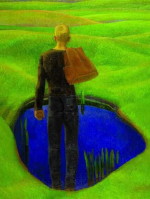
|
YABLONSKA, TETIANA, b 24 February 1917 in Smolensk, Russia, d 17 June 2005 in Kyiv. Ukrainian painter and teacher, of Belarusian descent; full member of the USSR (now Russian) Academy of Arts from 1975. She studied at the Kyiv State Art Institute (1935-41) under Fedir Krychevsky and later taught there (1944-52, 1966-73). Her canvases, most of which are painted in the realist tradition, are often bathed in light and show a highly developed sense of color. They have more in common with impressionism than with socialist realism, even though some have depicted happy farmers at a collective farm (eg, her famous Bread, 1949) and workers (eg, Evening on the Dnieper, 1946). In the 1960s, as a result of her interest in Ukrainian folk art and ethnography, her paintings became more decorative, with simplified forms and flattened space (eg, Young Mother, 1964; Widows, 1964). Ukrainian elements appeared, in works such as Betrothed (1966) and Swans (1966). By 1969 Yablonska was creating canvases that synthesized her two previous styles, a synthesis that culminated in the powerful, symbolic Youth (1969) and Silence (1975). In the 1980s she created portraits and numerous landscapes, including Winter in Old Kyiv (1975), The Source (1983), and Old Apple Tree (1986), peaceful compositions painted in a subdued, pearly gray palette. A large retrospective of her paintings was held at the Kyiv Museum of Ukrainian Art in 1987...
|
| Tetiana Yablonska |
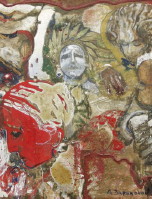
|
ZARETSKY, VIKTOR, b 8 February 1925 in Bilopillia, Sumy okruha, d 23 August 1990 in Kyiv. Painter. A graduate of the Kyiv State Art Institute (1953), he taught there and worked as a graphic artist. He painted realistic genre canvases in the Donbas and in Chornobyl raion, such as Flax Gathering (1960) and Girls (1962). He collaborated with his late wife, Alla Horska, and other artists in creating large mosaics and mixed-media murals, such as Prometheus, Earth, and Fire, in Secondary School No. 47 in Donetsk, The Tree of Life and Dream-Bird, in the Ukraina restaurant in Mariupol, and The Flag of Victory in the Young Guard Museum in Krasnodon. For signing a public letter protesting against the political trials of Ukrainian artists and intellectuals in 1965-6 he was reprimanded by the Communist Party and ostracized by the Union of Artists of Ukraine. In the 1970s he abandoned socialist realism in favor of an art nouveau style. His favorite themes became women and nature. The threat of ecological disaster is expressed sharply in his paintings Beauty Abandons the Earth, Sign of Calamity, Ozone Hole, and Atomic Winter. His late works include Klimtesque paintings, such as Angels (1988) and Portrait of Liudmyla Kozachenko (1987). A catalog of his works was published in 1991... |
| Viktor Zaretsky |
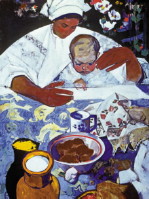
|
HORSKA, ALLA, b 18 September 1929 in Yalta in the Crimea, d 28 November 1970 in Vasylkiv, Kyiv oblast. Monumentalist painter, graduate of the Kyiv State Art Institute, and wife of Viktor Zaretsky. She was a co-founder and active member of the Club of Creative Youth (est 1962) in Kyiv, which played an important role in the cultural movement of the 1960s. She designed the stage sets for Mykola Kulish's Otak zahynuv Huska (Thus Huska Perished), whose premiere at the Lviv Ukrainian Drama Theater was banned. In 1964 she collaborated with Halyna Sevruk and Liudmyla Semykina on a stained-glass panel designed by Opanas Zalyvakha for Kyiv University. Because of its unconventional style and patriotic message, the panel, which depicted an angry Taras Shevchenko, was destroyed by the authorities, and Horska was expelled from the Union of Artists of Ukraine. To find work she had to leave Kyiv, but she continued to defy the authorities by protesting against their repressive measures. She was murdered in 1970. Although the crime remains officially unsolved, circumstantial evidence points to the KGB's involvement. Horska's main works are monumental internal and external paintings and mosaics decorating schools, museums, and restaurants, done in collaboration with other artists. A collection of Horska's letters and essays as well as reminiscences about her was published in Kyiv in 1996... |
| Alla Horska |
_s.jpg)
|
SEVRUK, HALYNA, b 18 May 1929 in Samarkand, Uzbekistan. Ceramist, painter, and graphic artist. After graduating from the Kyiv State Art Institute (1959) she worked for the Art Fund as a decorator of buildings; she created mosaics and large-scale ceramic panels (eg, for the Khmilnyk Sanatorium, the Chorne More Hotel in Odesa, the Kyiv Hotel in Kyiv, the Hradetskyi Hotel in Chernihiv, and School 204 in Kyiv). In 1964 she collaborated with Alla Horska and Liudmyla Semykina on a stained-glass panel designed by Opanas Zalyvakha for Kyiv University, which was later destroyed by the authorities. For speaking out against the political persecution of her friends she was expelled from the Union of Artists of Ukraine in 1968. In 1970-5 she produced several relief sculptures of Slavic pagan gods for the Cinema Building and the Kyivan Cave Historical-Cultural Preserve in Kyiv. Sevruk has won recognition for her many small ceramic reliefs depicting historical figures from Ukrainian history, mythology, folklore, and famous historical buildings. She has also done over 20 paintings (mostly in tempera) and over 30 ink drawings. A strong sympathizer of the dissident movement, Sevruk executed portraits of such dissidents as Alla Horska, Ivan Svitlychny, Nadiia Svitlychna, and Mykhailo Braichevsky. The first solo exhibition of her works was held in Kyiv in 1984, and in 1991 she had a solo exhibition in Toronto... |
| Halyna Sevruk |
_s.jpg)
|
ZVIRYNSKY, KARLO, b 14 August 1923 in Lavriv, Turka county, Galicia, d 8 October 1997 in Lviv. Painter and educator. He studied at the short-lived Lviv Academy of Art in 1942-3 under Mykola Butovych, Volodymyr Balias, and others. Under Soviet rule he studied at the Lviv Institute of Applied and Decorative Art under Roman Selsky and graduated in 1953. He later taught at the institute (1959-82), but was dismissed from his position as a consequence of his nonconformist stance. For years Zvirynsky gave illegal private lessons (known informally as the 'Zvirynsky academy') to his most talented students and had a powerful influence on the next generation of Ukrainian painters. Among the more prominent student's at his 'private academy' were Zenovii Flinta, Oleh Minko, Ivan Marchuk, Roman Petruk, and Vasyl Bazhai. In independent Ukraine Zvirynsky worked, from 1993, as professor at the Lviv National Academy of Arts. Zvirynsky experimented with the formal aspects of composition, form, line, texture, and color. Some of his works of the 1960s parallel the formal achievements of Western abstractionists. Zvirynsky has also painted semiabstract landscapes and complex still lifes, in which an assortment of objects fill the canvas. His numerous collages and relief constructions on panels explore the formal relationships of form and color. He also decorated several churches in Galicia and painted icons in a traditional style. Suppressed during Soviet time, Zvirynsky began to exhibit his works only in the 1990s... |
| Karlo Zvirynsky |
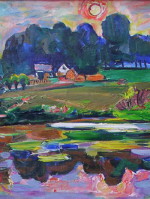
|
PATYK, VOLODYMYR, b 9 October 1926 in Chornyi Ostriv, Bibrka county, Galicia, d 28 August 2016 in Lviv. Painter and muralist. A graduate of the Lviv Institute of Applied and Decorative Art (1953), where he studies under Roman Selsky, Yosyp Bokshai, and others, he later worked as an artist in Lviv. In the 1960s he incorporated ethnographic themes and elements into paintings such as Korovai (1964) and Girl from Bukovyna (1966). Although most of his work is figurative, he has painted several canvases using Easter egg symbols as the basis of the compositions. Patyk is best known for his expressionist landscapes painted energetically in brilliant, high-intensity colors that convey his emotional response to nature and love of his homeland. The Green Carpathians (1970) and Autumn in the Carpathians (1986) are examples of the many paintings of the Carpathian Mountains created by the artist. Patyk has also painted thematic canvases, such as Dovbush--Our Glory (1967) and the funereal The Last Journey (1987), in which he used a dark, brooding palette in keeping with the subject. In 1999 he was awarded the Shevchenko Prize... |
| Volodymyr Patyk |
The preparation, editing, and display of the IEU entries about Ukrainians artists of the shistdesiatnyky generation were made possible by the financial support of the CANADIAN FOUNDATION FOR UKRAINIAN STUDIES.
 XXIII. UKRAINIAN NONCONFORMIST (UNOFFICIAL) ART IN THE USSR (1960s-80s)
XXIII. UKRAINIAN NONCONFORMIST (UNOFFICIAL) ART IN THE USSR (1960s-80s)
From the time of Joseph Stalin's terror of the 1930s, the officially prescribed style of socialist-realism was the only state-sanctioned so-called 'creative method' in Soviet art. Ukrainian nonconformist art, that broke with this tradition, had its beginnings in the Khrushchev 'thaw' of the mid-1950s. At that time the socialist-realist framework was widened, and Ukrainian ethnographic and folk-art themes became popular. Artists began exploring hitherto forbidden styles and trends in Western art and Eastern philosophy, as well as Ukrainian art of the 1920s, and developing their individual visions and means of expression. In the 1960s some artists became part of the growing dissident movement, and Opanas Zalyvakha and Stefaniia Shabatura were arrested for their involvement and imprisoned. Unlike their colleagues in Kyiv and in western Ukraine who signed petitions and attended political trials, the Odesa nonconformists pursued only artistic concerns. During the crackdown on the dissident movement in Ukraine in 1965 and again in 1972, nonconformist art went underground. Thereafter, some artists led a double existence, earning a living by creating socialist-realist art while continuing to paint nonconformist works in private. In 1975 the First Exhibition of Ukrainian Nonconformist Artists (with five participants) was held in Moscow in a private apartment. In the Second Exhibition of Ukrainian Nonconformist Art, held in Moscow in 1976, 16 artists participated. These exhibitions gave an opportunity for Ukrainian nonconformist artists living in different parts of the USSR to join forces. They could do so only in the Russian capital--the only place in the USSR where such a gathering was possible... Learn more about Ukrainian nonconformist artists in the USSR by visiting the following entries:
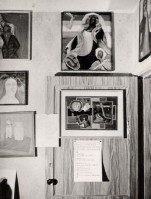
|
NONCONFORMIST ART (aka unofficial art). A term for art created in the USSR that, until the period of glasnost and perestroika in the 1980s, did not meet official approval and recognition. The creators of this art did not adhere to the prescribed program of socialist realism formulated at the First All-Union Congress of Soviet Writers in 1934. They did not, however, constitute a movement, nor did they represent one style, ideology, or worldview. In most cases their art was not an expression of political dissent. What unified them was their belief in and insistence on the freedom of creative individual expression. Strictly speaking, nonconformist art was not forbidden as long as it was kept private; when it was shown publicly, however, its creators were often subjected to reprisals and persecution. This state of affairs forced nonconformist artists to work in solitude and without official recognition. Ukrainian nonconformist artists who remained in the USSR were unable to exhibit their work publicly until the early 1980s. At that time shows by some more prominent nonconformists, such as Ivan Marchuk, were sponsored by official organizations, such as the Writers' Union of Ukraine... |
| Nonconformist art |
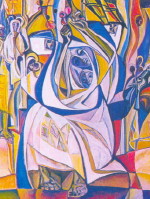
|
ZALYVAKHA, OPANAS, b 26 November 1925 in Husynka, now in Kupiansk raion, Kharkiv oblast, d 24 April 2007 in Ivano-Frankivsk. Nonconformist artist. Zalyvakha grew up in the Far East, where his parents resettled in 1933. He was expelled from the Leningrad Art Institute in 1947 for not conforming to socialist realism but was readmitted after Joseph Stalin's death, and graduated in 1960. In 1961 he moved to Ivano-Frankivsk. There his second solo exhibition (April 1962) was closed down by the Communist Party authorities for 'decadent tendencies.' In 1964 Zalyvakha, Alla Horska, and Liudmyla Semykina were commissioned to create a stained-glass panel for the vestibule of Kyiv University's main building. Depicting Taras Shevchenko with a wrathful expression, the panel was destroyed on orders of Kyiv's Party secretary. Zalyvakha was arrested in August 1965 and sentenced at a closed trial in March 1966 to five years in a hard-labor camp. After his release in 1970, he was forced to work as a laborer in Ivano-Frankivsk, but continued painting. The first solo exhibition of his paintings, sculptures, and ceramics in 26 years was held in Lviv in December 1988. A second was held in Ivano-Frankivsk in May 1989...
|
| Opanas Zalyvakha |
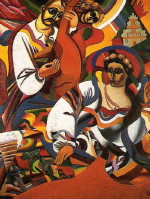
|
HUMENIUK, FEODOSII, b 6 September 1941 in Rybchyntsi, Khmilnyk raion, Vinnytsia oblast. Nonconformist painter and graphic artist. A graduate of the Dnipropetrovsk Art School and Leningrad Institute of Sculpture, Architecture, and Painting (1965), in 1974 he took part in the first nonconformist art exhibition in Leningrad and in 1975 he and Volodymyr Makarenko organized the first Ukrainian nonconformist art exhibition in a private apartment in Moscow. This led to Humeniuk's expulsion from the Union of Artists of the USSR and banishment to Dnipropetrovsk. His works, which tourists had managed to bring out of the USSR, were exhibited without his permission in Toronto in 1978, 1980, and 1984. Humeniuk again settled in Leningrad in 1983, and in 1992 he returned to Ukraine where he was awarded the Shevchenko Prize in 1992. Humeniuk deals with historical and religious themes through a rich system of symbols. From a formal aspect, his work is closely related to Mykhailo Boichuk's monumentalist style, which combines the traditions of old Byzantine art with folk art and modern Western styles, and exerted a dominant influence in Ukraine's artistic processes... |
| Feodosii Humeniuk |
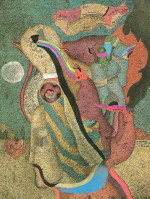
|
MAKARENKO, VOLODYMYR, b 26 July 1943 in Verkhivtseve, Dnipropetrovsk oblast. Painter and graphic artist. A graduate of the Dnipropetrovsk Art School (1963) and Leningrad Institute of Applied Art (1969), he was forced to leave Leningrad in 1973, and settled in Tallinn, Estonia. In 1975 he received first prize at the Biennale of Graphic Art in Ljubljana, Slovenia, and together with Feodosii Humeniuk organized the first Ukrainian nonconformist exhibition, which was held in Moscow in a private apartment and featured also paintings by Volodymyr Strelnikov and Vitalii Sazonov. In 1976 his first one-man exhibition was held at the Galerie Hardy in Paris. Makarenko emigrated to the West in 1979 and settled in Paris. The subjects of most of his works are highly personal, as are his images and vocabulary, which often reflect his Ukrainian heritage and Ukrainian history and literature. Although Makarenko is not a narrative artist, some of his paintings are visual texts with multiple readings. He has successfully synthesized several disparate sources, including Kazimir Malevich, Ukrainian icons, surrealism, and abstract art, into an unusual and unique vision... |
| Volodymyr Makarenko |
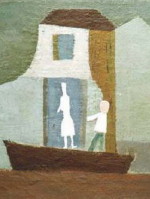
|
STRELNIKOV, VOLODYMYR, b 25 October 1939 in Odesa. Painter. He studied briefly at the Odesa Art School but was mostly self-taught. He worked as a muralist in Odesa and participated in and organized some of the exhibitions of nonconformist art there. Strelnikov has experimented with reduced shapes and the interrelationship between figures and architecture. In his later pictures architecture and figures have been reduced to simplified patterns within the larger contained form, so that a tension is sustained between the detailed, intricate shapes and the surrounding smooth areas of warm color. Together with Feodosii Humeniuk, Volodymyr Makarenko, and Vitalii Sazonov, Strelnikov participated in the 1975 and 1976 Moscow exhibitions of Ukrainian nonconformist artists and was consequently harassed by the Soviet authorities. In 1978 he was allowed to emigrate to Austria, and in 1979 he settled in Munich. Since that time he has exhibited in Western Europe, the United States, and Canada. He abandoned figuration in the late 1980s in favor of nonrepresentational compositions based on the interrelationship between form and color... |
| Volodymyr Strelnikov |
_s.jpg)
|
MARCHUK, IVAN, b 12 May 1936 in Moskalivka, Kremianets county, Volhynia voivodeship. Painter and sculptor. He graduated from the Lviv Institute of Applied and Decorative Art in 1965 and then moved to Kyiv. Until 1988 he was denied membership in the Union of Artists of Ukraine because his themes and style did not conform to socialist realism. Marchuk paints fantastic figural and floral compositions with elements of surrealism, hyperrealist portraits, enigmatic landscapes, and abstract expressionist compositions. His figural tempera paintings of the 'Voice of My Soul' series depict seemingly irrational situations with skeletal, often grotesque, persons cut off at the waist and surrounded by sinister objects and creatures set in a vast empty landscape. Marchuk's palette borders on the monochromatic, and the unreality of the imagery is thereby reinforced. His realistic landscapes have a peculiar, dense texture consisting of weblike layers of pigment that, combined with the dramatic use of light and dark, create an atmosphere of unease and mystery... |
| Ivan Marchuk |
The preparation, editing, and display of the IEU entries about Ukrainian nonconformist artists in the USSR in the 1960s-80s were made possible by the financial support of the CANADIAN FOUNDATION FOR UKRAINIAN STUDIES.
ABOUT IEU:Once completed, the Internet Encyclopedia of Ukraine will be the most comprehensive source of information in English on Ukraine, its history, people, geography, society, economy, and cultural heritage. With over 20,000 detailed encyclopedic entries supplemented with thousands of maps, photographs, illustrations, tables, and other graphic and/or audio materials, this immense repository of knowledge is designed to present Ukraine and Ukrainians to the world.
At present, only 51% of the entire planned IEU database is available on the IEU site. New entries are being edited, updated, and added daily. However, the successful completion of this ambitious and costly project will be possible only with financial assistance from IEU supporters. Become an IEU supporter and help the CIUS in creating the world's most authoritative electronic information resource about Ukraine and Ukrainians!
|
Click Home to get to the IEU Home page; to contact the IEU editors click Contact. To learn more about IEU click About IEU and to view the list of donors and to become an IEU supporter click Donors. ©2001 All Rights Reserved. Canadian Institute of Ukrainian Studies. |
